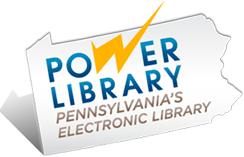

Teaching Research Skills to K-12 Students in The Classroom
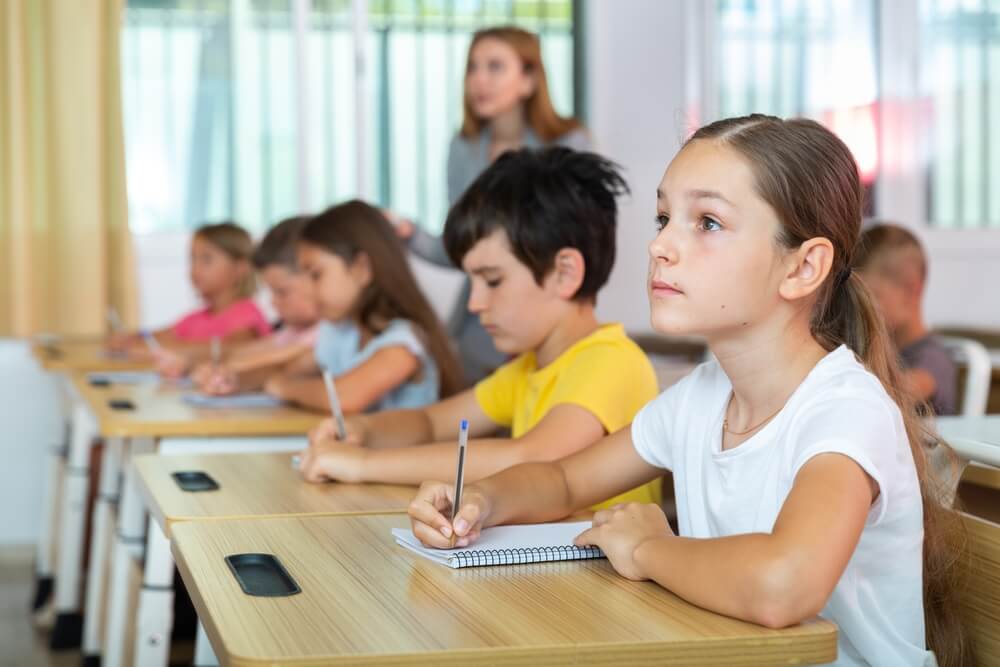
Research is at the core of knowledge. Nobody is born with an innate understanding of quantum physics. But through research , the knowledge can be obtained over time. That’s why teaching research skills to your students is crucial, especially during their early years.
But teaching research skills to students isn’t an easy task. Like a sport, it must be practiced in order to acquire the technique. Using these strategies, you can help your students develop safe and practical research skills to master the craft.
What Is Research?
By definition, it’s a systematic process that involves searching, collecting, and evaluating information to answer a question. Though the term is often associated with a formal method, research is also used informally in everyday life!
Whether you’re using it to write a thesis paper or to make a decision, all research follows a similar pattern.
- Choose a topic : Think about general topics of interest. Do some preliminary research to make sure there’s enough information available for you to work with and to explore subtopics within your subject.
- Develop a research question : Give your research a purpose; what are you hoping to solve or find?
- Collect data : Find sources related to your topic that will help answer your research questions.
- Evaluate your data : Dissect the sources you found. Determine if they’re credible and which are most relevant.
- Make your conclusion : Use your research to answer your question!
Why Do We Need It?
Research helps us solve problems. Trying to answer a theoretical question? Research. Looking to buy a new car? Research. Curious about trending fashion items? Research!
Sometimes it’s a conscious decision, like when writing an academic paper for school. Other times, we use research without even realizing it. If you’re trying to find a new place to eat in the area, your quick Google search of “food places near me” is research!
Whether you realize it or not, we use research multiple times a day, making it one of the most valuable lifelong skills to have. And it’s why — as educators —we should be teaching children research skills in their most primal years.
Teaching Research Skills to Elementary Students
In elementary school, children are just beginning their academic journeys. They are learning the essentials: reading, writing, and comprehension. But even before they have fully grasped these concepts, you can start framing their minds to practice research.
According to curriculum writer and former elementary school teacher, Amy Lemons , attention to detail is an essential component of research. Doing puzzles, matching games, and other memory exercises can help equip students with this quality before they can read or write.
Improving their attention to detail helps prepare them for the meticulous nature of research. Then, as their reading abilities develop, teachers can implement reading comprehension activities in their lesson plans to introduce other elements of research.
One of the best strategies for teaching research skills to elementary students is practicing reading comprehension . It forces them to interact with the text; if they come across a question they can’t answer, they’ll need to go back into the text to find the information they need.
Some activities could include completing compare/contrast charts, identifying facts or questioning the text, doing background research, and setting reading goals. Here are some ways you can use each activity:
- How it translates : Step 3, collect data; Step 4, evaluate your data
- Questioning the text : If students are unsure which are facts/not facts, encourage them to go back into the text to find their answers.
- How it translates : Step 3, collect data; Step 4, evaluate your data; Step 5, make your conclusion
- How it translates : Step 1, choose your topic
- How it translates : Step 2, develop a research question; Step 5, make your conclusion
Resources for Elementary Research
If you have access to laptops or tablets in the classroom, there are some free tools available through Pennsylvania’s POWER Kids to help with reading comprehension. Scholastic’s BookFlix and TrueFlix are 2 helpful resources that prompt readers with questions before, after, and while they read.
- BookFlix : A resource for students who are still new to reading. Students will follow along as a book is read aloud. As they listen or read, they will be prodded to answer questions and play interactive games to test and strengthen their understanding.
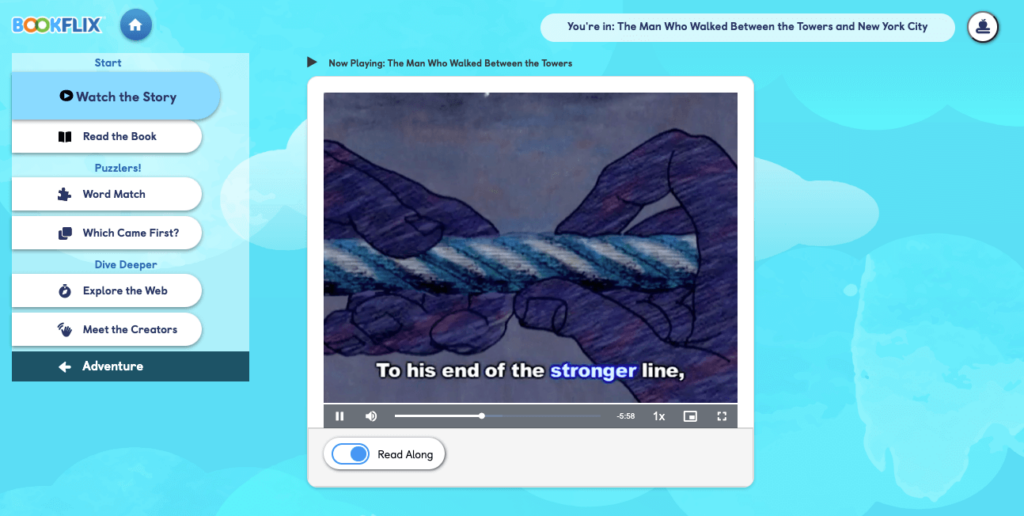
- TrueFlix : A resource for students who are proficient in reading. In TrueFlix, students explore nonfiction topics. It’s less interactive than BookFlix because it doesn’t prompt the reader with games or questions as they read. (There are still options to watch a video or listen to the text if needed!)

Teaching Research Skills to Middle School Students
By middle school, the concept of research should be familiar to students. The focus during this stage should be on credibility . As students begin to conduct research on their own, it’s important that they know how to determine if a source is trustworthy.
Before the internet, encyclopedias were the main tool that people used for research. Now, the internet is our first (and sometimes only) way of looking information up.
Unlike encyclopedias which can be trusted, students must be wary of pulling information offline. The internet is flooded with unreliable and deceptive information. If they aren’t careful, they could end up using a source that has inaccurate information!
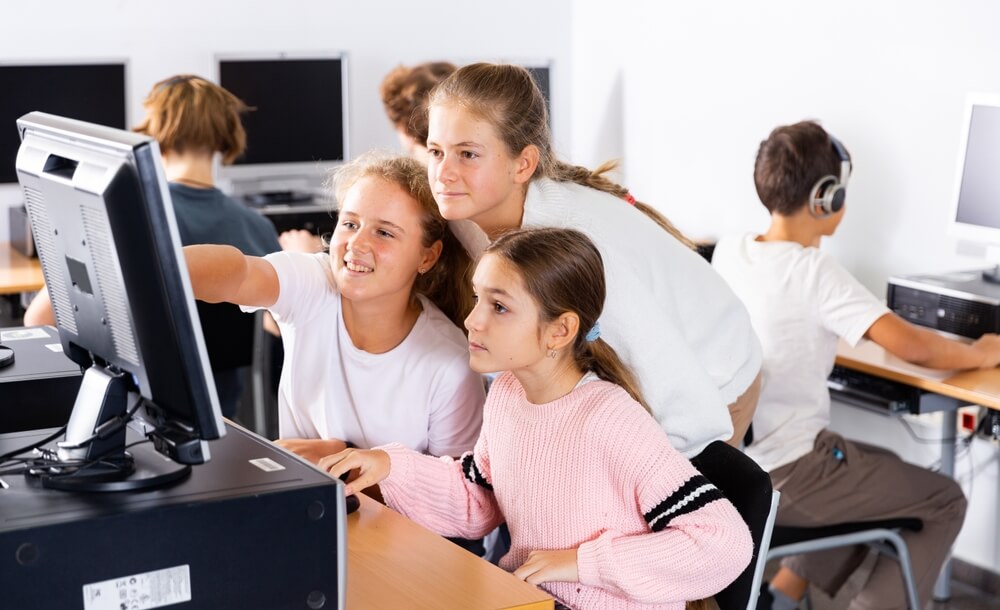
How To Know If A Source Is Credible
In general, credible sources are going to come from online encyclopedias, academic journals, industry journals, and/or an academic database. If you come across an article that isn’t from one of those options, there are details that you can look for to determine if it can be trusted.
- The author: Is the author an expert in their field? Do they write for a respected publication? If the answer is no, it may be good to explore other sources.
- Citations: Does the article list its sources? Are the sources from other credible sites like encyclopedias, databases, or journals? No list of sources (or credible links) within the text is usually a red flag.
- Date: When was the article published? Is the information fresh or out-of-date? It depends on your topic, but a good rule of thumb is to look for sources that were published no later than 7-10 years ago. (The earlier the better!)
- Bias: Is the author objective? If a source is biased, it loses credibility.
An easy way to remember what to look for is to utilize the CRAAP test . It stands for C urrency (date), R elevance (bias), A uthority (author), A ccuracy (citations), and P urpose (bias). They’re noted differently, but each word in this acronym is one of the details noted above.
If your students can remember the CRAAP test, they will be able to determine if they’ve found a good source.
Resources for Middle School Research
To help middle school researchers find reliable sources, the database Gale is a good starting point. It has many components, each accessible on POWER Library’s site. Gale Litfinder , Gale E-books , or Gale Middle School are just a few of the many resources within Gale for middle school students.
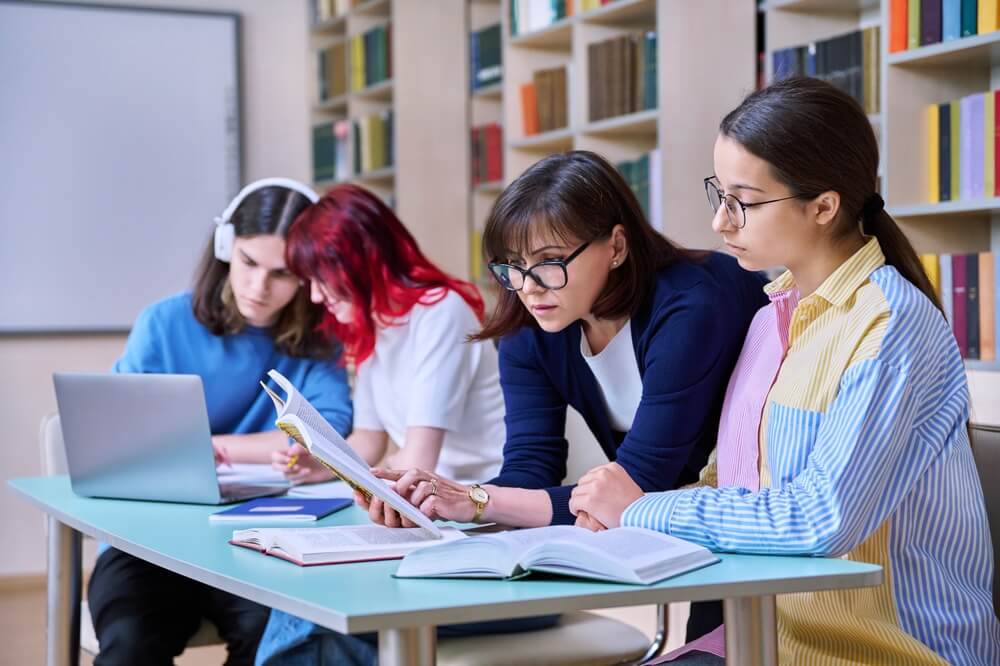
Teaching Research Skills To High Schoolers
The goal is that research becomes intuitive as students enter high school. With so much exposure and practice over the years, the hope is that they will feel comfortable using it in a formal, academic setting.
In that case, the emphasis should be on expanding methodology and citing correctly; other facets of a thesis paper that students will have to use in college. Common examples are annotated bibliographies, literature reviews, and works cited/reference pages.
- Annotated bibliography : This is a sheet that lists the sources that were used to conduct research. To qualify as annotated , each source must be accompanied by a short summary or evaluation.
- Literature review : A literature review takes the sources from the annotated bibliography and synthesizes the information in writing.
- Works cited/reference pages : The page at the end of a research paper that lists the sources that were directly cited or referenced within the paper.
Resources for High School Research
Many of the Gale resources listed for middle school research can also be used for high school research. The main difference is that there is a resource specific to older students: Gale High School .
If you’re looking for some more resources to aid in the research process, POWER Library’s e-resources page allows you to browse by grade level and subject. Take a look at our previous blog post to see which additional databases we recommend.
Visit POWER Library’s list of e-resources to start your research!
How to teach research skills to high school students: 12 tips
by mindroar | Oct 10, 2021 | blog | 0 comments
Teachers often find it difficult to decide how to teach research skills to high school students. You probably feel students should know how to do research by high school. But often students’ skills are lacking in one or more areas.
Today we’re not going to give you research skills lesson plans for high school. But we will give you 12 tips for how to teach research skills to high school students. Bonus, the tips will make it quick, fun, and easy.
One of my favorite ways of teaching research skills to high school students is to use the Crash Course Navigating Digital Information series.
The videos are free and short (between ten and fifteen minutes each). They cover information such as evaluating the trustworthiness of sources, using Wikipedia, lateral reading, and understanding how the source medium can affect the message.
Another thing I like to integrate into my lessons are the Crash Course Study Skills videos . Again, they’re free and short. Plus they are an easy way to refresh study skills such as:
- note-taking
- writing papers
- editing papers
- getting organized
- and studying for tests and exams.
If you’re ready to get started, we’ll give you links to great resources that you can integrate into your lessons. Because often students just need a refresh on a particular skill and not a whole semester-long course.
1. Why learn digital research skills?
Tip number one of how to teach research skills to high school students. Address the dreaded ‘why?’ questions upfront. You know the questions: Why do we have to do this? When am I ever going to use this?
If your students understand why they need good research skills and know that you will show them specific strategies to improve their skills, they are far more likely to buy into learning about how to research effectively.
An easy way to answer this question is that students spend so much time online. Some people spend almost an entire day online each week.
It’s amazing to have such easy access to information, unlike the pre-internet days. But there is far more misinformation and disinformation online.
A webpage, Facebook post, Instagram post, YouTube video, infographic, meme, gif, TikTok video (etc etc) can be created by just about anyone with a phone. And it’s easy to create them in a way that looks professional and legitimate.
This can make it hard for people to know what is real, true, evidence-based information and what is not.
The first Crash Course Navigating Digital Information video gets into the nitty-gritty of why we should learn strategies for evaluating the information we find (online or otherwise!).
An easy way to answer the ‘why’ questions your high schoolers will ask, the video is an excellent resource.
2. Teaching your students to fact check
Tip number two for teaching research skills to high school students is to teach your students concrete strategies for how to check facts.
It’s surprising how many students will hand in work with blatant factual errors. Errors they could have avoided had they done a quick fact check.
An easy way to broach this research skill in high school is to watch the second video in the Crash Course Navigating Digital Information series. It explains what fact-checking is, why people should do it, and how to make it a habit.
You can explain to your students that they’ll write better papers if they learn to fact-check. But they’ll also make better decisions if they make fact-checking a habit.
The video looks at why people are more likely to believe mis- or disinformation online. And it shows students a series of questions they can use to identify mis- or disinformation.
The video also discusses why it’s important to find a few generally reliable sources of information and to use those as a way to fact-check other online sources.
3. Teaching your students how and why to read laterally
This ties in with tip number 2 – teach concrete research strategies – but it is more specific. Fact-checking tends to be checking what claim sources are making, who is making the claim, and corroborating the claim with other sources.
But lateral reading is another concrete research skills strategy that you can teach to students. This skill helps students spot inaccurate information quickly and avoid wasting valuable research time.
One of the best (and easiest!) research skills for high school students to learn is how to read laterally. And teachers can demonstrate it so, so easily. As John Green says in the third Crash Course Navigating Digital Information video , just open another tab!
The video also shows students good websites to use to check hoaxes and controversial information.
Importantly, John Green also explains that students need a “toolbox” of strategies to assess sources of information. There’s not one magic source of information that is 100% accurate.
4. Teaching your students how to evaluate trustworthiness
Deciding who to trust online can be difficult even for those of us with lots of experience navigating online. And it is made even more difficult by how easy it now is to create a professional-looking websites.
This video shows students what to look for when evaluating trustworthiness. It also explains how to take bias, opinion, and political orientations into account when using information sources.
The video explains how reputable information sources gather reliable information (versus disreputable sources). And shows how reputable information sources navigate the situation when they discover their information is incorrect or misleading.
Students can apply the research skills from this video to news sources, novel excerpts, scholarly articles, and primary sources. Teaching students to look for bias, political orientation, and opinions within all sources is one of the most valuable research skills for high school students.
5. Teaching your students to use Wikipedia
Now, I know that Wikipedia can be the bane of your teacherly existence when you are reading essays. I know it can make you want to gouge your eyes out with a spoon when you read the same recycled article in thirty different essays. But, teaching students how to use Wikipedia as a jumping-off point is a useful skill.
Wikipedia is no less accurate than other online encyclopedia-type sources. And it often includes hyperlinks and references that students can check or use for further research. Plus it has handy-dandy warnings for inaccurate and contentious information.
Part of how to teach research skills to high school students is teaching them how to use general reference material such as encyclopedias for broad information. And then following up with how to use more detailed information such as primary and secondary sources.
The Crash Course video about Wikipedia is an easy way to show students how to use it more effectively.
6. Teaching your students to evaluate evidence
Another important research skill to teach high school students is how to evaluate evidence. This skill is important, both in their own and in others’ work.
An easy way to do this is the Crash Course video about evaluating evidence video. The short video shows students how to evaluate evidence using authorship, the evidence provided, and the relevance of the evidence.
It also gives examples of ways that evidence can be used to mislead. For example, it shows that simply providing evidence doesn’t mean that the evidence is quality evidence that supports the claim being made.
The video shows examples of evidence that is related to a topic, but irrelevant to the claim. Having an example of irrelevant evidence helps students understand the difference between related but irrelevant evidence and evidence that is relevant to the claim.
Finally, the video gives students questions that they can use to evaluate evidence.
7. Teaching your students to evaluate photos and videos
While the previous video about evidence looked at how to evaluate evidence in general, this video looks specifically at video and photographic evidence.
The video looks at how videos and photos can be manipulated to provide evidence for a claim. It suggests that seeking out the context for photos and videos is especially important as a video or photo is easy to misinterpret. This is especially the case if a misleading caption or surrounding information is provided.
The video also gives tools that students can use to discover hoaxes or fakes. Similarly, it encourages people to look for the origin of the photo or video to find the creator. And to then use that with contextual information to decide whether the photo or video is reliable evidence for a claim.
8. Teaching your students to evaluate data and infographics
Other sources of evidence that students (and adults!) often misinterpret or are misled by are data and infographics. Often people take the mere existence of statistics or other data as evidence for a claim instead of investigating further.
Again the Crash Course video suggests seeking out the source and context for data and infographics. It suggests that students often see data as neutral and irrefutable, but that data is inherently biased as it is created by humans.
The video gives a real-world example of how data can be manipulated as a source of evidence by showing how two different news sources represented global warming data.
9. Teaching your students how search engines work and why to use click restraint
Another video from the Crash Course Navigating Digital Information series is the video about how search engines work and click restraint . This video shows how search engines decide which information to list at the top of the search results. It also shows how search engines decide what information is relevant and of good quality.
The video gives search tips for using search engines to encourage the algorithms to return more reliable and accurate results.
This video is important when you are want to know how to teach research skills to high school students. This is because many students don’t understand why the first few results on a search are not necessarily the best information available.
10. Teach your students how to evaluate social media sources
One of the important research skills high school students need is to evaluate social media posts. Many people now get news and information from social media sites that have little to no oversight or editorial control. So, being able to evaluate posts for accuracy is key.
This video in the Crash Course Navigating Digital Information series also explains that social media sites are free to use because they make money from advertising. The advertising money comes from keeping people on the platform (and looking at the ads).
How do they keep people on the platform? By using algorithms that gather information about how long people spend on or react to different photos, posts and videos. Then, the algorithms will send viewers more content that is similar to the content that they view or interact with.
This prioritizes content that is controversial, shocking, engaging, attractive. It also reinforces the social norms of the audience members using the platform.
By teaching students how to combat the way that social media algorithms work, you can show them how to gather more reliable and relevant information in their everyday lives. Further, you help students work out if social media posts are relevant to (reliable for) their academic work.
11. Teaching your students how to cite sources
Another important research skill high school students need is how to accurately cite sources. A quick Google search turned up a few good free ideas:
- This lesson plan from the Brooklyn Library for grades 4-11. It aligns with the common core objectives and provides worksheets for students to learn to use MLA citation.
- This blog post about middle-school teacher Jody Passanini’s experiences trying to teach students in English and History how to cite sources both in-text and at the end with a reference list.
- This scavenger hunt lesson by 8th grade teacher on ReadWriteThink. It has a free printout asking students to prove assertions (which could be either student- or teacher-generated) with quotes from the text and a page number. It also has an example answer using the Catching Fire (Hunger Games) novel.
- The Chicago Manual of Style has this quick author-date citation guide .
- This page by Purdue Online Writing Lab has an MLA citation guide , as well as links to other citation guides such as APA.
If you are wanting other activities, a quick search of TPT showed these to be popular and well-received by other teachers:
- Laura Randazzo’s 9th edition MLA in-text and end-of-text citation activities
- Tracee Orman 8th edition MLA cheet sheet
- The Daring English Teacher’s MLA 8th edition citation powerpoint
12. Teaching your students to take notes
Another important skill to look at when considering how to teach research skills to high school students is whether they know how to take effective notes.
The Crash Course Study Skills note-taking video is great for this. It outlines three note-taking styles – the outline method, the Cornell method, and the mind map method. And it shows students how to use each of the methods.
This can help you start a conversation with your students about which styles of note-taking are most effective for different tasks.
For example, mind maps are great for seeing connections between ideas and brain dumps. The outline method is great for topics that are hierarchical. And the Cornell method is great for topics with lots of specific vocabulary.
Having these types of metacognitive discussions with your students helps them identify study and research strategies. It also helps them to learn which strategies are most effective in different situations.
Teaching research skills to high school students . . .
Doesn’t have to be
- time-consuming
The fantastic Crash Course Navigating Digital Information videos are a great way to get started if you are wondering how to teach research skills to high school students.
If you decide to use the videos in your class, you can buy individual worksheets if you have specific skills in mind. Or you can buy the full bundle if you think you’ll end up watching all of the videos.
Got any great tips for teaching research skills to high school students?
Head over to our Facebook or Instagram pages and let us know!
How to Teach Research to High School Students
Using inquiry and reflection.

How to Teach Research Skills to High School Students
Teaching a comprehensive research experiences can be daunting and overwhelming! Many dread teaching a research project or paper but, weirdly, one of my favorite things to teach. I have taught many projects over my years but the inquiry-based project has always been my favorite! I love seeing what topics excite students! Plus, research skills are rigorous and develop critical thinking skills. As they develop there is growing-pains! As students tell me, “You do too much Ms.” Haha! Yes, I do! But having a topic they are excited about makes (slightly) less whining.
The focus of teaching research to high school students is to create independent learners and critical thinkers. I often take bits and pieces of the whole project. I might have my class write reflections on our class readings or create research questions based on articles and even novels.
Below are my steps for how to teach research and writing skills to high school students. Find all my resources in this Inquiry-Based research project on TPT.

Here are my steps and strategies to help you teach a successful inquiry-based research project:
First introduce the concept:
Begin by explaining the purpose and benefits of an inquiry-based research project. Emphasize the importance of curiosity, asking meaningful questions, and seeking evidence-based answers.
Then select a relevant topic: Help students choose a topic that aligns with their interests and the curriculum. Encourage them to select a broad topic and refine it through the process of inquiry. I model a brainstorming process. I often end up creating my own project as I take students through the process!
Formulate research questions:
Teach students how to develop research questions that are specific, clear, and open-ended. Guide them in brainstorming questions that will guide their research and exploration.

Teaching research skills to high school students
Teach research skills: Provide instruction on effective research techniques and tools. Teach students how to use search engines, databases, libraries, and credible sources to gather information. Emphasize the importance of evaluating sources for reliability and accuracy. I started this process when it was mainly paper-based! My project now are a blend of paper templates and digital organization using (mainly) Google products.
Develop a research plan using outlines and graphic organizers: Assist students in creating a research plan that outlines the steps they will take to investigate their questions. Teach them how to break down their research into manageable tasks and set realistic timelines. Writing templates are my savior! It helps them break it into manageable parts and write in sections. Students don’t always have students write a formal paper- often I use the template and then they create a brochure or “marketing material” for their topic and share using a gallery walk.
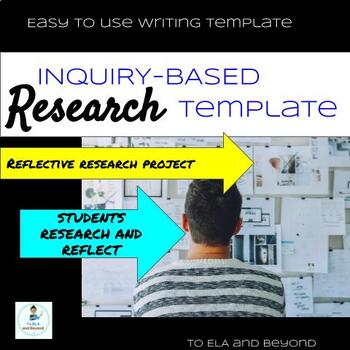
Encourage reflection and analysis
Guide students in reflecting on their findings and analyzing the data they have collected. Teach them how to draw conclusions, identify patterns or trends, and make connections to the broader context of their topic.
Finally present findings
Assist students in organizing and presenting their research findings in a clear and engaging manner. Teach them how to create visual aids, write reports, or deliver presentations that effectively communicate their research.
I love using Padlet or discussion boards to have students share questions. I also love gallery walks where students create a brochure or other “marketing” material based on their research. Presenting to partner or small group is effective where listening students create questions for their peer’s topics.
Reflect on the process: At the end of the project, have students reflect on their experience. Ask them to consider what they learned, what challenges they faced, and how their thinking and research skills have developed. Reflection is a key component to this project. It is built into the template and final paper.

You may also enjoy:
Teaching research to high school students: halloween …, leave a reply cancel reply.
Your email address will not be published. Required fields are marked *
Website URL
Teaching research to high school students: Halloween Edition
Collaborative writing tasks: an unsung hero in the classroom.
Empowering students to develop research skills
February 8, 2021
This post is republished from Into Practice , a biweekly communication of Harvard’s Office of the Vice Provost for Advances in Learning
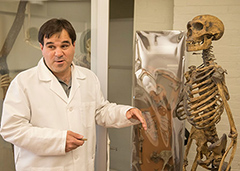
Terence D. Capellini, Richard B Wolf Associate Professor of Human Evolutionary Biology, empowers students to grow as researchers in his Building the Human Body course through a comprehensive, course-long collaborative project that works to understand the changes in the genome that make the human skeleton unique. For instance, of the many types of projects, some focus on the genetic basis of why human beings walk on two legs. This integrative “Evo-Devo” project demands high levels of understanding of biology and genetics that students gain in the first half of class, which is then applied hands-on in the second half of class. Students work in teams of 2-3 to collect their own morphology data by measuring skeletons at the Harvard Museum of Natural History and leverage statistics to understand patterns in their data. They then collect and analyze DNA sequences from humans and other animals to identify the DNA changes that may encode morphology. Throughout this course, students go from sometimes having “limited experience in genetics and/or morphology” to conducting their own independent research. This project culminates in a team presentation and a final research paper.
The benefits: Students develop the methodological skills required to collect and analyze morphological data. Using the UCSC Genome browser and other tools, students sharpen their analytical skills to visualize genomics data and pinpoint meaningful genetic changes. Conducting this work in teams means students develop collaborative skills that model academic biology labs outside class, and some student projects have contributed to published papers in the field. “Every year, I have one student, if not two, join my lab to work on projects developed from class to try to get them published.”
“The beauty of this class is that the students are asking a question that’s never been asked before and they’re actually collecting data to get at an answer.”
The challenges: Capellini observes that the most common challenge faced by students in the course is when “they have a really terrific question they want to explore, but the necessary background information is simply lacking. It is simply amazing how little we do know about human development, despite its hundreds of years of study.” Sometimes, for instance, students want to learn about the evolution, development, and genetics of a certain body part, but it is still somewhat a mystery to the field. In these cases, the teaching team (including co-instructor Dr. Neil Roach) tries to find datasets that are maximally relevant to the questions the students want to explore. Capellini also notes that the work in his class is demanding and hard, just by the nature of the work, but students “always step up and perform” and the teaching team does their best to “make it fun” and ensure they nurture students’ curiosities and questions.
Takeaways and best practices
- Incorporate previous students’ work into the course. Capellini intentionally discusses findings from previous student groups in lectures. “They’re developing real findings and we share that when we explain the project for the next groups.” Capellini also invites students to share their own progress and findings as part of class discussion, which helps them participate as independent researchers and receive feedback from their peers.
- Assign groups intentionally. Maintaining flexibility allows the teaching team to be more responsive to students’ various needs and interests. Capellini will often place graduate students by themselves to enhance their workload and give them training directly relevant to their future thesis work. Undergraduates are able to self-select into groups or can be assigned based on shared interests. “If two people are enthusiastic about examining the knee, for instance, we’ll match them together.”
- Consider using multiple types of assessments. Capellini notes that exams and quizzes are administered in the first half of the course and scaffolded so that students can practice the skills they need to successfully apply course material in the final project. “Lots of the initial examples are hypothetical,” he explains, even grounded in fiction and pop culture references, “but [students] have to eventually apply the skills they learned in addressing the hypothetical example to their own real example and the data they generate” for the Evo-Devo project. This is coupled with a paper and a presentation treated like a conference talk.
Bottom line: Capellini’s top advice for professors looking to help their own students grow as researchers is to ensure research projects are designed with intentionality and fully integrated into the syllabus. “You can’t simply tack it on at the end,” he underscores. “If you want this research project to be a substantive learning opportunity, it has to happen from Day 1.” That includes carving out time in class for students to work on it and make the connections they need to conduct research. “Listen to your students and learn about them personally” so you can tap into what they’re excited about. Have some fun in the course, and they’ll be motivated to do the work.
- Research Skills
How to Teach Online Research Skills to Students in 5 Steps (Free Posters)
Please note, this post was updated in 2020 and I no longer update this website.
How often does this scenario play out in your classroom?
You want your students to go online and do some research for some sort of project, essay, story or presentation. Time ticks away, students are busy searching and clicking, but are they finding the useful and accurate information they need for their project?
We’re very fortunate that many classrooms are now well equipped with devices and the internet, so accessing the wealth of information online should be easier than ever, however, there are many obstacles.
Students (and teachers) need to navigate:
- What search terms to put into Google or other search engines
- What search results to click on and read through (while avoiding inappropriate or irrelevant sites or advertisements)
- How to determine what information is credible, relevant and student friendly
- How to process, synthesize, evaluate , and present the information
- How to compare a range of sources to evaluate their reliability and relevancy
- How to cite sources correctly
Phew! No wonder things often don’t turn out as expected when you tell your students to just “google” their topic. On top of these difficulties some students face other obstacles including: low literacy skills, limited internet access, language barriers, learning difficulties and disabilities.
All of the skills involved in online research can be said to come under the term of information literacy, which tends to fall under a broader umbrella term of digital literacy.
Being literate in this way is an essential life skill.
This post offers tips and suggestions on how to approach this big topic. You’ll learn a 5 step method to break down the research process into manageable chunks in the classroom. Scroll down to find a handy poster for your classroom too.
How to Teach Information Literacy and Online Research Skills
The topic of researching and filtering information can be broken down in so many ways but I believe the best approach involves:
- Starting young and building on skills
- Embedding explicit teaching and mini-lessons regularly (check out my 50 mini-lesson ideas here !)
- Providing lots of opportunity for practice and feedback
- Teachers seeking to improve their own skills — these free courses from Google might help
- Working with your librarian if you have one
💡 While teaching research skills is something that should be worked on throughout the year, I also like the idea of starting the year off strongly with a “Research Day” which is something 7th grade teacher Dan Gallagher wrote about . Dan and his colleagues had their students spend a day rotating around different activities to learn more about researching online. Something to think about!
Google or a Kid-friendly Search Engine?
If you teach young students you might be wondering what the best starting place is.
I’ve only ever used Google with students but I know many teachers like to start with search engines designed for children. If you’ve tried these search engines, I’d love you to add your thoughts in a comment.
💡 If you’re not using a kid-friendly search engine, definitely make sure SafeSearch is activated on Google or Bing. It’s not foolproof but it helps.
Two search engines designed for children that look particularly useful include:
These sites are powered by Google SafeSearch with some extra filtering/moderating.
KidzSearch contains additional features like videos and image sections to browse. While not necessarily a bad thing, I prefer the simple interface of Kiddle for beginners.
Read more about child-friendly search engines
This article from Naked Security provides a helpful overview of using child-friendly search engines like Kiddle.
To summarise their findings, search-engines like Kiddle can be useful but are not perfect.
For younger children who need to be online but are far too young to be left to their own devices, and for parents and educators that want little ones to easily avoid age-inappropriate content, these search engines are quite a handy tool. For older children, however, the results in these search engines may be too restrictive to be useful, and will likely only frustrate children to use other means.
Remember, these sorts of tools are not a replacement for education and supervision.
Maybe start with no search engine?
Another possible starting point for researching with young students is avoiding a search engine altogether.
Students could head straight to a site they’ve used before (or choose from a small number of teacher suggested sites). There’s a lot to be learned just from finding, filtering, and using information found on various websites.
Five Steps to Teaching Students How to Research Online and Filter Information
This five-step model might be a useful starting point for your students to consider every time they embark on some research.
Let’s break down each step. You can find a summary poster at the end.
Students first need to take a moment to consider what information they’re actually looking for in their searches.
It can be a worthwhile exercise to add this extra step in between giving a student a task (or choice of tasks) and sending them off to research.
You could have a class discussion or small group conferences on brainstorming keywords , considering synonyms or alternative phrases , generating questions etc. Mindmapping might help too.
2016 research by Morrison showed that 80% of students rarely or never made a list of possible search words. This may be a fairly easy habit to start with.
Time spent defining the task can lead to a more effective and streamlined research process.

It sounds simple but students need to know that the quality of the search terms they put in the Google search box will determine the quality of their results.
There are a LOT of tips and tricks for Googling but I think it’s best to have students first master the basics of doing a proper Google search.
I recommend consolidating these basics:
- Type in some simple search terms using only the important keywords
- If the initial results aren’t what you want, alter the search terms and get more specific (get clues from the initial search results e.g. you might see synonyms that would work or get ideas from the “People Also Ask” section)
- Use quotation marks if you want your keywords in an exact order, e.g. “raining cats and dogs”
- use your best guess with spelling (Google will often understand)
- don’t worry about punctuation
- understand that everyone’s results will be different , even if they use the same search terms (depending on browser history, location etc.)
📌 Get a free PDF of this poster here.
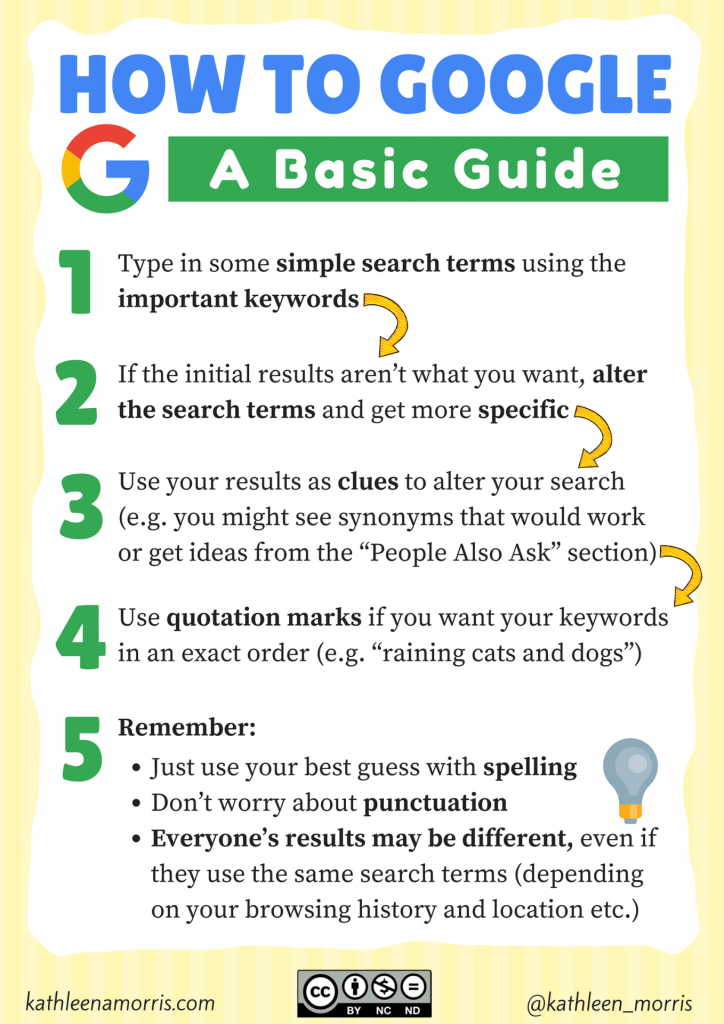
Links to learn more about Google searches
There’s lots you can learn about Google searches.
I highly recommend you take a look at 20 Instant Google Searches your Students Need to Know by Eric Curts to learn about “instant searches”.
Med Kharbach has also shared a simple visual with 12 search tips which would be really handy once students master the basics too.
The Google Search Education website is an amazing resource with lessons for beginner/intermediate/advanced plus slideshows and videos. It’s also home to the A Google A Day classroom challenges. The questions help older students learn about choosing keywords, deconstructing questions, and altering keywords.
Useful videos about Google searches
How search works.
This easy to understand video from Code.org to explains more about how search works.
How Does Google Know Everything About Me?
You might like to share this video with older students that explains how Google knows what you’re typing or thinking. Despite this algorithm, Google can’t necessarily know what you’re looking for if you’re not clear with your search terms.
What about when the answer comes up in Google instantly?
If you’ve been using Google for a while, you know they are tweaking the search formula so that more and more, an answer will show up within the Google search result itself. You won’t even need to click through to any websites.
For example, here I’ve asked when the Titanic sunk. I don’t need to go to any websites to find out. The answer is right there in front of me.
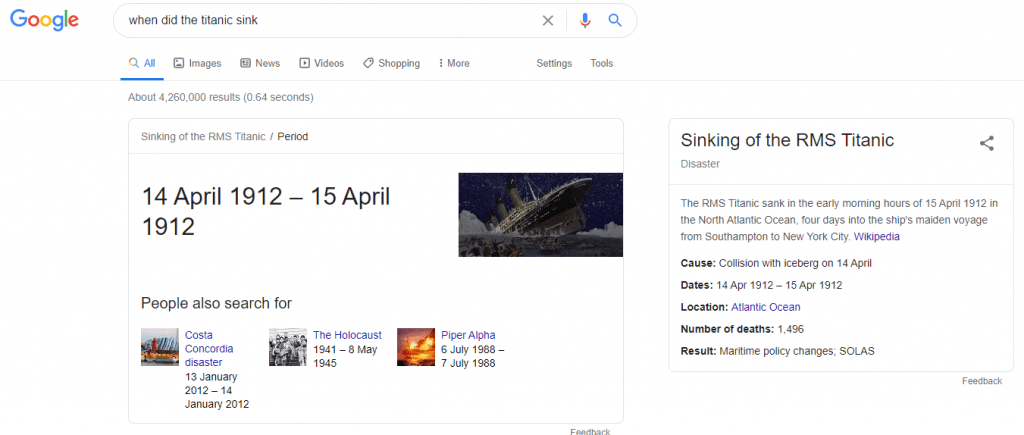
While instant searches and featured snippets are great and mean you can “get an answer” without leaving Google, students often don’t have the background knowledge to know if a result is incorrect or not. So double checking is always a good idea.
As students get older, they’ll be able to know when they can trust an answer and when double checking is needed.
Type in a subject like cats and you’ll be presented with information about the animals, sports teams, the musical along with a lot of advertising. There are a lot of topics where some background knowledge helps. And that can only be developed with time and age.
Entering quality search terms is one thing but knowing what to click on is another.
You might like to encourage students to look beyond the first few results. Let students know that Google’s PageRank algorithm is complex (as per the video above), and many websites use Search Engine Optimisation to improve the visibility of their pages in search results. That doesn’t necessarily mean they’re the most useful or relevant sites for you.
As pointed out in this article by Scientific American ,
Skilled searchers know that the ranking of results from a search engine is not a statement about objective truth, but about the best matching of the search query, term frequency, and the connectedness of web pages. Whether or not those results answer the searchers’ questions is still up for them to determine.
Point out the anatomy of a Google search result and ensure students know what all the components mean. This could be as part of a whole class discussion, or students could create their own annotations.
An important habit to get into is looking at the green URL and specifically the domain . Use some intuition to decide whether it seems reliable. Does the URL look like a well-known site? Is it a forum or opinion site? Is it an educational or government institution? Domains that include .gov or .edu might be more reliable sources.
When looking through possible results, you may want to teach students to open sites in new tabs, leaving their search results in a tab for easy access later (e.g. right-click on the title and click “Open link in new tab” or press Control/Command and click the link).
Searchers are often not skilled at identifying advertising within search results. A famous 2016 Stanford University study revealed that 82% of middle-schoolers couldn’t distinguish between an ad labelled “sponsored content” and a real news story.
Time spent identifying advertising within search results could help students become much more savvy searchers. Looking for the words “ad” and “sponsored” is a great place to start.
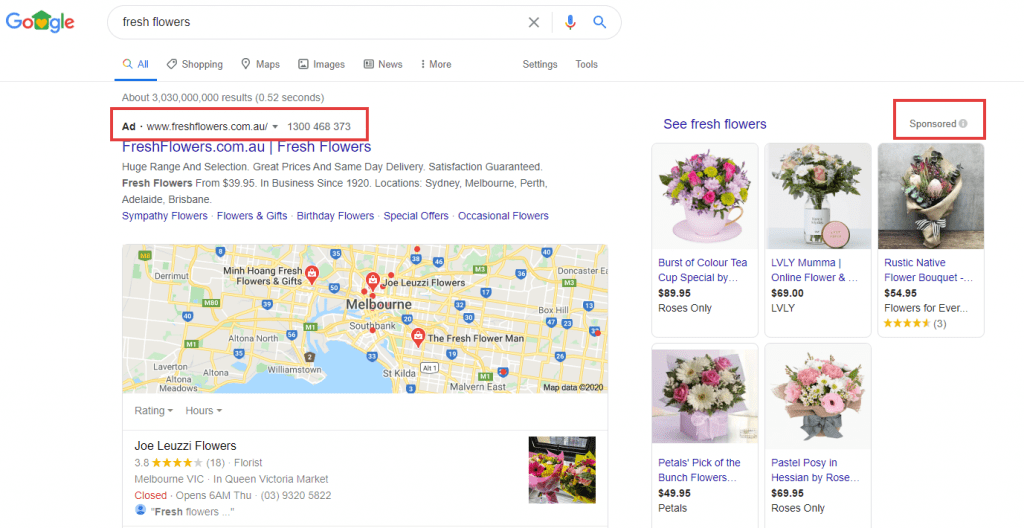
4) Evaluate
Once you click on a link and land on a site, how do you know if it offers the information you need?
Students need to know how to search for the specific information they’re after on a website. Teach students how to look for the search box on a webpage or use Control F (Command F on Mac) to bring up a search box that can scan the page.
Ensure students understand that you cannot believe everything you read . This might involve checking multiple sources. You might set up class guidelines that ask students to cross check their information on two or three different sites before assuming it’s accurate.
I’ve written a post all about teaching students how to evaluate websites . It includes this flowchart which you’re welcome to download and use in your classroom.
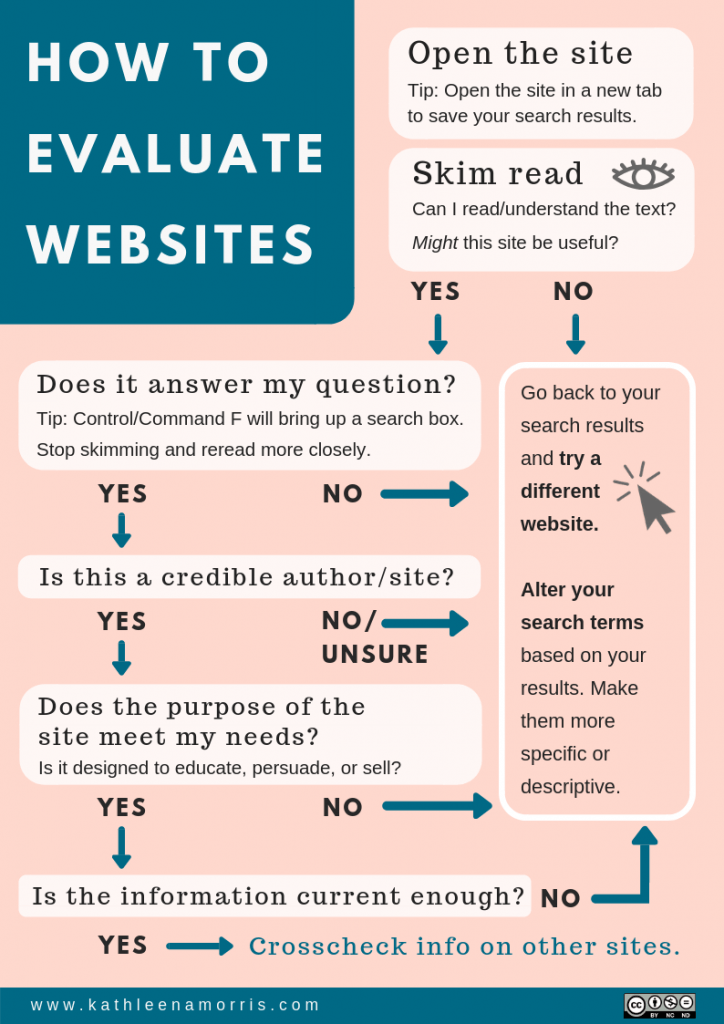
So your students navigated the obstacles of searching and finding information on quality websites. They’ve found what they need! Hooray.
Many students will instinctively want to copy and paste the information they find for their own work.
We need to inform students about plagiarism and copyright infringement while giving them the skills they need to avoid this.
- Students need to know that plagiarism is taking someone’s work and presenting it as your own. You could have a class discussion about the ethics and legalities of this.
- Students also need to be assured that they can use information from other sources and they should. They just need to say who wrote it, where it was from and so on.
All students can benefit from learning about plagiarism, copyright, how to write information in their own words, and how to acknowledge the source. However, the formality of this process will depend on your students’ age and your curriculum guidelines.
Give students lots of practice writing information in their own words. Younger students can benefit from simply putting stories or recounts in their own words. Older students could investigate the difference between paraphrasing and summarising .
There are some free online tools that summarise information for you. These aren’t perfect and aren’t a replacement from learning the skill but they could be handy for students to try out and evaluate. For example, students could try writing their own summary and then comparing it to a computer summary. I like the tool SMMRY as you can enter text or a URL of an article. Eric Curts shares a list of 7 summary tools in this blog post .
Students also need a lot of practice using quotation marks and citing sources .
The internet can offer a confusing web of information at times. Students need to be shown how to look for the primary source of information. For example, if they find information on Wikipedia, they need to cite from the bibliography at the bottom of the Wikipedia article, not Wikipedia itself.
There are many ways you can teach citation:
- I like Kathy Schrock’s PDF document which demonstrates how you can progressively teach citation from grades 1 to 6 (and beyond). It gives some clear examples that you could adapt for your own classroom use.
Staying organised!
You might also like to set up a system for students to organise their information while they’re searching. There are many apps and online tools to curate, annotate, and bookmark information, however, you could just set up a simple system like a Google Doc or Spreadsheet.
The format and function is simple and clear. This means students don’t have to put much thought into using and designing their collections. Instead, they can focus on the important curation process.
Bring These Ideas to Life With Mini-Lessons!
We know how important it is for students to have solid research skills. But how can you fit teaching research skills into a jam-packed curriculum? The answer may be … mini-lessons !
Whether you teach primary or secondary students, I’ve compiled 50 ideas for mini-lessons.
Try one a day or one a week and by the end of the school year, you might just be amazed at how independent your students are becoming with researching.
Become an Internet Search Master with This Google Slides Presentation
In early 2019, I was contacted by Noah King who is a teacher in Northern California.
Noah was teaching his students about my 5 step process outlined in this post and put together a Google Slides Presentation with elaboration and examples.
You’re welcome to use and adapt the Google Slides Presentation yourself. Find out exactly how to do this in this post.
The Presentation was designed for students around 10-11 years old but I think it could easily be adapted for different age groups.
Recap: How To Do Online Research
Despite many students being confident users of technology, they need to be taught how to find information online that’s relevant, factual, student-friendly, and safe.
Keep these six steps in mind whenever you need to do some online research:
- Clarify : What information are you looking for? Consider keywords, questions, synonyms, alternative phrases etc.
- Search : What are the best words you can type into the search engine to get the highest quality results?
- Delve : What search results should you click on and explore further?
- Evaluate : Once you click on a link and land on a site, how do you know if it offers the information you need?
- Cite : How can you write information in your own words (paraphrase or summarise), use direct quotes, and cite sources?
- Staying organised : How can you keep the valuable information you find online organised as you go through the research process?
Don’t forget to ask for help!
Lastly, remember to get help when you need it. If you’re lucky enough to have a teacher-librarian at your school, use them! They’re a wonderful resource.
If not, consult with other staff members, librarians at your local library, or members of your professional learning network. There are lots of people out there who are willing and able to help with research. You just need to ask!
Being able to research effectively is an essential skill for everyone . It’s only becoming more important as our world becomes increasingly information-saturated. Therefore, it’s definitely worth investing some classroom time in this topic.
Developing research skills doesn’t necessarily require a large chunk of time either. Integration is key and remember to fit in your mini-lessons . Model your own searches explicitly and talk out loud as you look things up.
When you’re modelling your research, go to some weak or fake websites and ask students to justify whether they think the site would be useful and reliable. Eric Curts has an excellent article where he shares four fake sites to help teach students about website evaluation. This would be a great place to start!
Introduce students to librarians ; they are a wonderful resource and often underutilised. It pays for students to know how they can collaborate with librarians for personalised help.
Finally, consider investing a little time in brushing up on research skills yourself . Everyone thinks they can “google” but many don’t realise they could do it even better (myself included!).
You Might Also Enjoy
Teaching Digital Citizenship: 10 Internet Safety Tips for Students
Free Images, Copyright, And Creative Commons: A Guide For Teachers And Students
8 Ways Teachers And Schools Can Communicate With Parents
How To Evaluate Websites: A Guide For Teachers And Students

14 Replies to “How to Teach Online Research Skills to Students in 5 Steps (Free Posters)”
Kathleen, I like your point about opening up sites in new tabs. You might be interested in Mike Caulfield’s ‘four moves’ .
What a fabulous resource, Aaron. Thanks so much for sharing. This is definitely one that others should check out too. Even if teachers don’t use it with students (or are teaching young students), it could be a great source of learning for educators too.
This is great information and I found the safe search sites you provided a benefit for my children. I searched for other safe search sites and you may want to know about them. http://www.kids-search.com and http://www.safesearch.tips .
Hi Alice, great finds! Thanks so much for sharing. I like the simple interface. It’s probably a good thing there are ads at the top of the listing too. It’s an important skill for students to learn how to distinguish these. 🙂
Great website! Really useful info 🙂
I really appreciate this blog post! Teaching digital literacy can be a struggle. This topic is great for teachers, like me, who need guidance in effectively scaffolding for scholars who to use the internet to gain information.
So glad to hear it was helpful, Shasta! Good luck teaching digital literacy!
Why teachers stopped investing in themselves! Thanks a lot for the article, but this is the question I’m asking myself after all teachers referring to google as if it has everything you need ! Why it has to come from you and not the whole education system! Why it’s an option? As you said smaller children don’t need search engine in the first place! I totally agree, and I’m soo disappointed how schooling system is careless toward digital harms , the very least it’s waste of the time of my child and the most being exposed to all rubbish on the websites. I’m really disappointed that most teachers are not thinking taking care of their reputation when it comes to digital learning. Ok using you tube at school as material it’s ok , but why can’t you pay little extra to avoid adverts while teaching your children! Saving paper created mountains of electronic-toxic waste all over the world! What a degradation of education.
Thanks for sharing your thoughts, Shohida. I disagree that all schooling systems are careless towards ‘digital harms’, however, I do feel like more digital citizenship education is always important!
Hi Kathleen, I love your How to Evaluate Websites Flow Chart! I was wondering if I could have permission to have it translated into Spanish. I would like to add it to a Digital Research Toolkit that I have created for students.
Thank you! Kristen
Hi Kristen, You’re welcome to translate it! Please just leave the original attribution to my site on there. 🙂 Thanks so much for asking. I really hope it’s useful to your students! Kathleen
[…] matter how old your child is, there are many ways for them to do research into their question. For very young children, you’ll need to do the online research work. Take your time with […]
[…] digs deep into how teachers can guide students through responsible research practices on her blog (2019). She suggests a 5 step model for elementary students on how to do online […]
Writing lesson plans on the fly outside of my usual knowledge base (COVID taken down so many teachers!) and this info is precisely what I needed! Thanks!!!
Comments are closed.

LIVE@CoSN2024: Exclusive Coverage
4 essential resources for building research skills in high school
Strong research skills are valuable beyond high school and will serve students well as they enter a world of digital resources and information.
Key points: Helping students develop strong research skills will create responsible digital citizens Critical evaluation of online resources and information is essential See related article: Students need freedom to develop critical skills with edtech Get the latest news about digital learning by going to eSN’s Digital Learning page Stay up to date on the latest trends about learning in the digital age
Right now is the perfect time to start a research project with your students, as it will help them develop skills they will use for the rest of their lives. While your students, who have grown up in the Information Age and think they already know everything, any classroom teacher knows that our students need help more than they think.
As a school librarian for the past 11 years, my primary focus has been on helping students become adept navigators of the sea of information they live in. By the time students reach me in high school, they are already juggling multiple social media accounts and unknowingly driving many business and political decisions through their media consumption.
Our students’ belief that everything they need to know is online can, without the right skillset, leave them prey to misinformation. So how do we teach our students to steer through the online ocean of data to be both effective researchers and responsible digital citizens?
Here are 4 must-have resources for teaching high school students how to research:
Digital encyclopedias like Britannica School or Credo Reference are still important, and vetted, sources of basic information. Each provides students with a credible resource and gives them helpful notation and citation tools. But don’t settle for just one. Take students on a tour of both databases and explore the differences. Britannica School is user-friendly and comprehensive, which makes it an ideal tool for building student confidence in their research skills. Even if your students are literal social media influencers, they may be apprehensive or overwhelmed navigating a database, and we do not want them to give up and turn to Google. They need to develop their research skills before they are ready to evaluate content from across the world wide web. The bold, colorful text features and differentiation of reading levels make Britannica School engaging and easy to use, and it is a trusted source of information.
Although both databases offer similar content, Credo Reference has a unique feature called Visual Exploration that you and your students will love. The database will retrieve your search results in the form of a mind map, which links your search term to related terms that are hyperlinked to vetted content. Articles related to the original search term appear alongside the mind map. Visual Exploration is an effective and interactive tool for teaching students about choosing search terms and narrowing their research topics. Credo Reference also has a series of short research tip videos for students on topics such as “what to do when your topic is too broad.”
Upper-level courses require students to navigate and analyze more complex sources than a standard encyclopedia entry, which can often be just a list of facts. Whether you are teaching U.S. Government or A.P. Language and Composition, your students are learning to evaluate persuasive writing and identify propaganda, because these are key information literacy skills. Gale In Context: Opposing Viewpoints not only provides students with curated sources and all the tools of an online encyclopedia but also introduces students to well-researched writing from various perspectives. A huge part of research is thinking critically about the credibility and intent of the source, and this database provides a safe space to analyze and examine issues from multiple angles. Gale In Context: Opposing Viewpoints is both visually appealing and has a unique feature for visual learners. The Topic Finder retrieves results as your choice of a tile or a wheel that displays terms at various sizes depending on the number of results for that term. For example, a Topic Finder search for “Artificial intelligence” displays “mental health” among the largest clusters of the tile or section of the wheel, which lets me know I can find significant content in the database related to A.I. and mental health. There is a curriculum search and an Educator Resources page with helpful tip sheets and worksheets, including one for students to create their own concept map.
Before you dive into an encyclopedia head first, you may want to go to Discovery Education Experience and gather some tools for teaching research effectively. You do not need to build a lesson from scratch. There’s a wealth of media within the platform to help you activate prior knowledge, develop assignments and create interactive lessons on any topic. The Discover Data channel, which is the result of a partnership between the Nielsen Foundation, Discovery Education, and the National Afterschool Association, has interactive, relevant lessons that you can adapt for your students. One of my favorites is the “Social Media and Misinformation” presentation. You can use it as an introduction to information literacy or assign the presentation as a self-paced lesson for students. In fact, you can use the Build an Activity feature with this or another presentation from Discovery Education to create an assignment and share it directly to Google Classroom, Microsoft Teams, Schoology or Canvas.
With these essentials in your toolbox, you will be able to equip your students with research skills that will help them unlock success in and out of the classroom.
Related : 4 tools to help students build post-COVID research skills
Sign up for our K-12 newsletter
- Recent Posts
Ayanna Mayes is a school librarian at Chapin High School in School District Five of Lexington and Richland Counties. She served as the 2018 School Librarian of the Year for the South Carolina Association of School Librarians (SCASL).
- The 4Cs: How esports promotes student development - April 5, 2024
- How bullying contributes to K-12 student absenteeism - April 4, 2024
- Show Stopper—CTL on Connected Chromebooks - April 3, 2024
Want to share a great resource? Let us know at [email protected] .
Username or Email Address
Remember Me

" * " indicates required fields
eSchool News uses cookies to improve your experience. Visit our Privacy Policy for more information.
Thank you for visiting nature.com. You are using a browser version with limited support for CSS. To obtain the best experience, we recommend you use a more up to date browser (or turn off compatibility mode in Internet Explorer). In the meantime, to ensure continued support, we are displaying the site without styles and JavaScript.
- View all journals
- My Account Login
- Explore content
- About the journal
- Publish with us
- Sign up for alerts
- Open access
- Published: 02 December 2020
Enhancing senior high school student engagement and academic performance using an inclusive and scalable inquiry-based program
- Locke Davenport Huyer ORCID: orcid.org/0000-0003-1526-7122 1 , 2 na1 ,
- Neal I. Callaghan ORCID: orcid.org/0000-0001-8214-3395 1 , 3 na1 ,
- Sara Dicks 4 ,
- Edward Scherer 4 ,
- Andrey I. Shukalyuk 1 ,
- Margaret Jou 4 &
- Dawn M. Kilkenny ORCID: orcid.org/0000-0002-3899-9767 1 , 5
npj Science of Learning volume 5 , Article number: 17 ( 2020 ) Cite this article
40k Accesses
4 Citations
13 Altmetric
Metrics details
The multi-disciplinary nature of science, technology, engineering, and math (STEM) careers often renders difficulty for high school students navigating from classroom knowledge to post-secondary pursuits. Discrepancies between the knowledge-based high school learning approach and the experiential approach of future studies leaves some students disillusioned by STEM. We present Discovery , a term-long inquiry-focused learning model delivered by STEM graduate students in collaboration with high school teachers, in the context of biomedical engineering. Entire classes of high school STEM students representing diverse cultural and socioeconomic backgrounds engaged in iterative, problem-based learning designed to emphasize critical thinking concomitantly within the secondary school and university environments. Assessment of grades and survey data suggested positive impact of this learning model on students’ STEM interests and engagement, notably in under-performing cohorts, as well as repeating cohorts that engage in the program on more than one occasion. Discovery presents a scalable platform that stimulates persistence in STEM learning, providing valuable learning opportunities and capturing cohorts of students that might otherwise be under-engaged in STEM.
Similar content being viewed by others
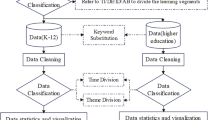
Subject integration and theme evolution of STEM education in K-12 and higher education research
Zehui Zhan & Shijing Niu
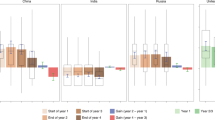
Skill levels and gains in university STEM education in China, India, Russia and the United States
Prashant Loyalka, Ou Lydia Liu, … Yanyan Li
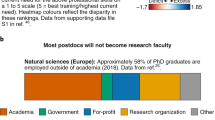
Academic ecosystems must evolve to support a sustainable postdoc workforce
Murielle Ålund, Nathan Emery, … Eben Gering
Introduction
High school students with diverse STEM interests often struggle to understand the STEM experience outside the classroom 1 . The multi-disciplinary nature of many career fields can foster a challenge for students in their decision to enroll in appropriate high school courses while maintaining persistence in study, particularly when these courses are not mandatory 2 . Furthermore, this challenge is amplified by the known discrepancy between the knowledge-based learning approach common in high schools and the experiential, mastery-based approaches afforded by the subsequent undergraduate model 3 . In the latter, focused classes, interdisciplinary concepts, and laboratory experiences allow for the application of accumulated knowledge, practice in problem solving, and development of both general and technical skills 4 . Such immersive cooperative learning environments are difficult to establish in the secondary school setting and high school teachers often struggle to implement within their classroom 5 . As such, high school students may become disillusioned before graduation and never experience an enriched learning environment, despite their inherent interests in STEM 6 .
It cannot be argued that early introduction to varied math and science disciplines throughout high school is vital if students are to pursue STEM fields, especially within engineering 7 . However, the majority of literature focused on student interest and retention in STEM highlights outcomes in US high school learning environments, where the sciences are often subject-specific from the onset of enrollment 8 . In contrast, students in the Ontario (Canada) high school system are required to complete Level 1 and 2 core courses in science and math during Grades 9 and 10; these courses are offered as ‘applied’ or ‘academic’ versions and present broad topics of content 9 . It is not until Levels 3 and 4 (generally Grades 11 and 12, respectively) that STEM classes become subject-specific (i.e., Biology, Chemistry, and/or Physics) and are offered as “university”, “college”, or “mixed” versions, designed to best prepare students for their desired post-secondary pursuits 9 . Given that Levels 3 and 4 science courses are not mandatory for graduation, enrollment identifies an innate student interest in continued learning. Furthermore, engagement in these post-secondary preparatory courses is also dependent upon achieving successful grades in preceding courses, but as curriculum becomes more subject-specific, students often yield lower degrees of success in achieving course credit 2 . Therefore, it is imperative that learning supports are best focused on ensuring that those students with an innate interest are able to achieve success in learning.
When given opportunity and focused support, high school students are capable of successfully completing rigorous programs at STEM-focused schools 10 . Specialized STEM schools have existed in the US for over 100 years; generally, students are admitted after their sophomore year of high school experience (equivalent to Grade 10) based on standardized test scores, essays, portfolios, references, and/or interviews 11 . Common elements to this learning framework include a diverse array of advanced STEM courses, paired with opportunities to engage in and disseminate cutting-edge research 12 . Therein, said research experience is inherently based in the processes of critical thinking, problem solving, and collaboration. This learning framework supports translation of core curricular concepts to practice and is fundamental in allowing students to develop better understanding and appreciation of STEM career fields.
Despite the described positive attributes, many students do not have the ability or resources to engage within STEM-focused schools, particularly given that they are not prevalent across Canada, and other countries across the world. Consequently, many public institutions support the idea that post-secondary led engineering education programs are effective ways to expose high school students to engineering education and relevant career options, and also increase engineering awareness 13 . Although singular class field trips are used extensively to accomplish such programs, these may not allow immersive experiences for application of knowledge and practice of skills that are proven to impact long-term learning and influence career choices 14 , 15 . Longer-term immersive research experiences, such as after-school programs or summer camps, have shown successful at recruiting students into STEM degree programs and careers, where longevity of experience helps foster self-determination and interest-led, inquiry-based projects 4 , 16 , 17 , 18 , 19 .
Such activities convey the elements that are suggested to make a post-secondary led high school education programs successful: hands-on experience, self-motivated learning, real-life application, immediate feedback, and problem-based projects 20 , 21 . In combination with immersion in university teaching facilities, learning is authentic and relevant, similar to the STEM school-focused framework, and consequently representative of an experience found in actual STEM practice 22 . These outcomes may further be a consequence of student engagement and attitude: Brown et al. studied the relationships between STEM curriculum and student attitudes, and found the latter played a more important role in intention to persist in STEM when compared to self-efficacy 23 . This is interesting given that student self-efficacy has been identified to influence ‘motivation, persistence, and determination’ in overcoming challenges in a career pathway 24 . Taken together, this suggests that creation and delivery of modern, exciting curriculum that supports positive student attitudes is fundamental to engage and retain students in STEM programs.
Supported by the outcomes of identified effective learning strategies, University of Toronto (U of T) graduate trainees created a novel high school education program Discovery , to develop a comfortable yet stimulating environment of inquiry-focused iterative learning for senior high school students (Grades 11 & 12; Levels 3 & 4) at non-specialized schools. Built in strong collaboration with science teachers from George Harvey Collegiate Institute (Toronto District School Board), Discovery stimulates application of STEM concepts within a unique term-long applied curriculum delivered iteratively within both U of T undergraduate teaching facilities and collaborating high school classrooms 25 . Based on the volume of medically-themed news and entertainment that is communicated to the population at large, the rapidly-growing and diverse field of biomedical engineering (BME) were considered an ideal program context 26 . In its definition, BME necessitates cross-disciplinary STEM knowledge focused on the betterment of human health, wherein Discovery facilitates broadening student perspective through engaging inquiry-based projects. Importantly, Discovery allows all students within a class cohort to work together with their classroom teacher, stimulating continued development of a relevant learning community that is deemed essential for meaningful context and important for transforming student perspectives and understandings 27 , 28 . Multiple studies support the concept that relevant learning communities improve student attitudes towards learning, significantly increasing student motivation in STEM courses, and consequently improving the overall learning experience 29 . Learning communities, such as that provided by Discovery , also promote the formation of self-supporting groups, greater active involvement in class, and higher persistence rates for participating students 30 .
The objective of Discovery , through structure and dissemination, is to engage senior high school science students in challenging, inquiry-based practical BME activities as a mechanism to stimulate comprehension of STEM curriculum application to real-world concepts. Consequent focus is placed on critical thinking skill development through an atmosphere of perseverance in ambiguity, something not common in a secondary school knowledge-focused delivery but highly relevant in post-secondary STEM education strategies. Herein, we describe the observed impact of the differential project-based learning environment of Discovery on student performance and engagement. We identify the value of an inquiry-focused learning model that is tangible for students who struggle in a knowledge-focused delivery structure, where engagement in conceptual critical thinking in the relevant subject area stimulates student interest, attitudes, and resulting academic performance. Assessment of study outcomes suggests that when provided with a differential learning opportunity, student performance and interest in STEM increased. Consequently, Discovery provides an effective teaching and learning framework within a non-specialized school that motivates students, provides opportunity for critical thinking and problem-solving practice, and better prepares them for persistence in future STEM programs.
Program delivery
The outcomes of the current study result from execution of Discovery over five independent academic terms as a collaboration between Institute of Biomedical Engineering (graduate students, faculty, and support staff) and George Harvey Collegiate Institute (science teachers and administration) stakeholders. Each term, the program allowed senior secondary STEM students (Grades 11 and 12) opportunity to engage in a novel project-based learning environment. The program structure uses the problem-based engineering capstone framework as a tool of inquiry-focused learning objectives, motivated by a central BME global research topic, with research questions that are inter-related but specific to the curriculum of each STEM course subject (Fig. 1 ). Over each 12-week term, students worked in teams (3–4 students) within their class cohorts to execute projects with the guidance of U of T trainees ( Discovery instructors) and their own high school teacher(s). Student experimental work was conducted in U of T teaching facilities relevant to the research study of interest (i.e., Biology and Chemistry-based projects executed within Undergraduate Teaching Laboratories; Physics projects executed within Undergraduate Design Studios). Students were introduced to relevant techniques and safety procedures in advance of iterative experimentation. Importantly, this experience served as a course term project for students, who were assessed at several points throughout the program for performance in an inquiry-focused environment as well as within the regular classroom (Fig. 1 ). To instill the atmosphere of STEM, student teams delivered their outcomes in research poster format at a final symposium, sharing their results and recommendations with other post-secondary students, faculty, and community in an open environment.
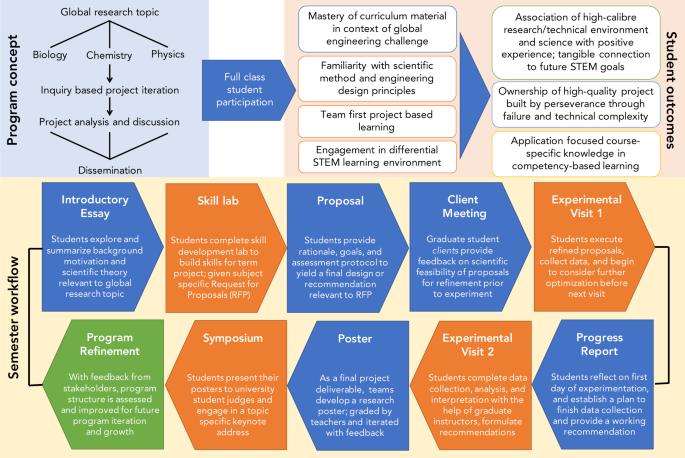
The general program concept (blue background; top left ) highlights a global research topic examined through student dissemination of subject-specific research questions, yielding multifaceted student outcomes (orange background; top right ). Each program term (term workflow, yellow background; bottom panel ), students work on program deliverables in class (blue), iterate experimental outcomes within university facilities (orange), and are assessed accordingly at numerous deliverables in an inquiry-focused learning model.
Over the course of five terms there were 268 instances of tracked student participation, representing 170 individual students. Specifically, 94 students participated during only one term of programming, 57 students participated in two terms, 16 students participated in three terms, and 3 students participated in four terms. Multiple instances of participation represent students that enrol in more than one STEM class during their senior years of high school, or who participated in Grade 11 and subsequently Grade 12. Students were surveyed before and after each term to assess program effects on STEM interest and engagement. All grade-based assessments were performed by high school teachers for their respective STEM class cohorts using consistent grading rubrics and assignment structure. Here, we discuss the outcomes of student involvement in this experiential curriculum model.
Student performance and engagement
Student grades were assigned, collected, and anonymized by teachers for each Discovery deliverable (background essay, client meeting, proposal, progress report, poster, and final presentation). Teachers anonymized collective Discovery grades, the component deliverable grades thereof, final course grades, attendance in class and during programming, as well as incomplete classroom assignments, for comparative study purposes. Students performed significantly higher in their cumulative Discovery grade than in their cumulative classroom grade (final course grade less the Discovery contribution; p < 0.0001). Nevertheless, there was a highly significant correlation ( p < 0.0001) observed between the grade representing combined Discovery deliverables and the final course grade (Fig. 2a ). Further examination of the full dataset revealed two student cohorts of interest: the “Exceeds Expectations” (EE) subset (defined as those students who achieved ≥1 SD [18.0%] grade differential in Discovery over their final course grade; N = 99 instances), and the “Multiple Term” (MT) subset (defined as those students who participated in Discovery more than once; 76 individual students that collectively accounted for 174 single terms of assessment out of the 268 total student-terms delivered) (Fig. 2b, c ). These subsets were not unrelated; 46 individual students who had multiple experiences (60.5% of total MTs) exhibited at least one occasion in achieving a ≥18.0% grade differential. As students participated in group work, there was concern that lower-performing students might negatively influence the Discovery grade of higher-performing students (or vice versa). However, students were observed to self-organize into groups where all individuals received similar final overall course grades (Fig. 2d ), thereby alleviating these concerns.
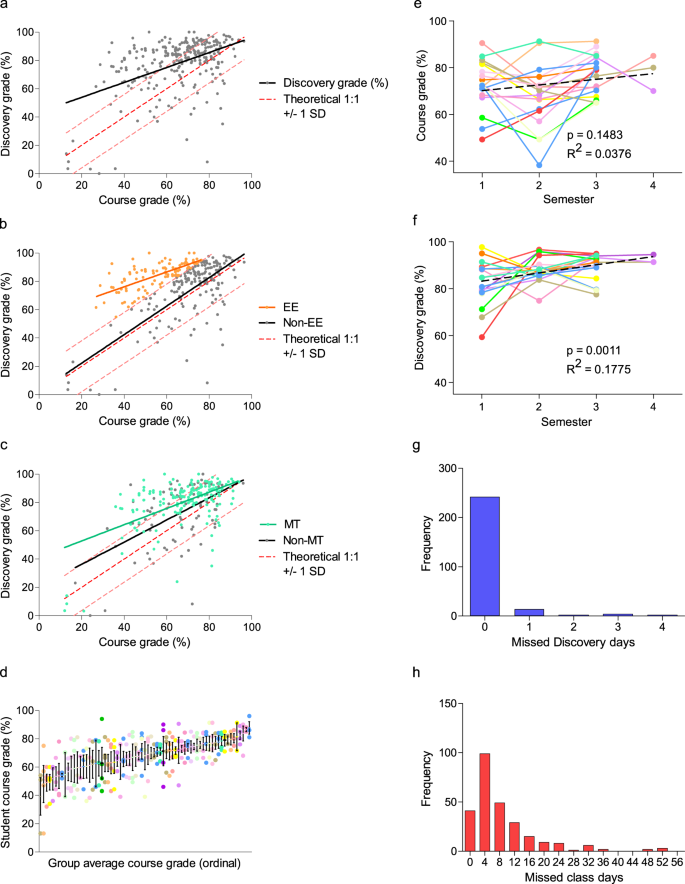
a Linear regression of student grades reveals a significant correlation ( p = 0.0009) between Discovery performance and final course grade less the Discovery contribution to grade, as assessed by teachers. The dashed red line and intervals represent the theoretical 1:1 correlation between Discovery and course grades and standard deviation of the Discovery -course grade differential, respectively. b , c Identification of subgroups of interest, Exceeds Expectations (EE; N = 99, orange ) who were ≥+1 SD in Discovery -course grade differential and Multi-Term (MT; N = 174, teal ), of which N = 65 students were present in both subgroups. d Students tended to self-assemble in working groups according to their final course performance; data presented as mean ± SEM. e For MT students participating at least 3 terms in Discovery , there was no significant correlation between course grade and time, while ( f ) there was a significant correlation between Discovery grade and cumulative terms in the program. Histograms of total absences per student in ( g ) Discovery and ( h ) class (binned by 4 days to be equivalent in time to a single Discovery absence).
The benefits experienced by MT students seemed progressive; MT students that participated in 3 or 4 terms ( N = 16 and 3, respectively ) showed no significant increase by linear regression in their course grade over time ( p = 0.15, Fig. 2e ), but did show a significant increase in their Discovery grades ( p = 0.0011, Fig. 2f ). Finally, students demonstrated excellent Discovery attendance; at least 91% of participants attended all Discovery sessions in a given term (Fig. 2g ). In contrast, class attendance rates reveal a much wider distribution where 60.8% (163 out of 268 students) missed more than 4 classes (equivalent in learning time to one Discovery session) and 14.6% (39 out of 268 students) missed 16 or more classes (equivalent in learning time to an entire program of Discovery ) in a term (Fig. 2h ).
Discovery EE students (Fig. 3 ), roughly by definition, obtained lower course grades ( p < 0.0001, Fig. 3a ) and higher final Discovery grades ( p = 0.0004, Fig. 3b ) than non-EE students. This cohort of students exhibited program grades higher than classmates (Fig. 3c–h ); these differences were significant in every category with the exception of essays, where they outperformed to a significantly lesser degree ( p = 0.097; Fig. 3c ). There was no statistically significant difference in EE vs. non-EE student classroom attendance ( p = 0.85; Fig. 3i, j ). There were only four single day absences in Discovery within the EE subset; however, this difference was not statistically significant ( p = 0.074).
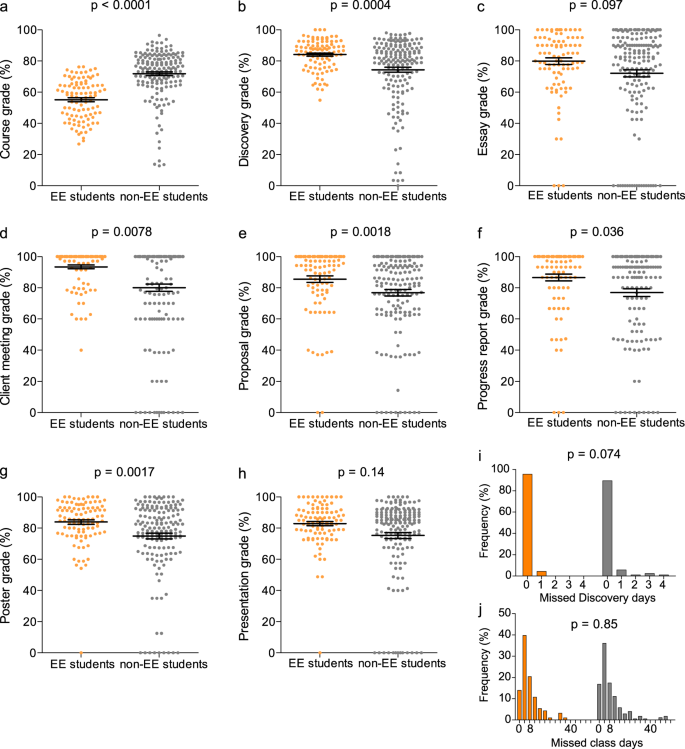
The “Exceeds Expectations” (EE) subset of students (defined as those who received a combined Discovery grade ≥1 SD (18.0%) higher than their final course grade) performed ( a ) lower on their final course grade and ( b ) higher in the Discovery program as a whole when compared to their classmates. d – h EE students received significantly higher grades on each Discovery deliverable than their classmates, except for their ( c ) introductory essays and ( h ) final presentations. The EE subset also tended ( i ) to have a higher relative rate of attendance during Discovery sessions but no difference in ( j ) classroom attendance. N = 99 EE students and 169 non-EE students (268 total). Grade data expressed as mean ± SEM.
Discovery MT students (Fig. 4 ), although not receiving significantly higher grades in class than students participating in the program only one time ( p = 0.29, Fig. 4a ), were observed to obtain higher final Discovery grades than single-term students ( p = 0.0067, Fig. 4b ). Although trends were less pronounced for individual MT student deliverables (Fig. 4c–h ), this student group performed significantly better on the progress report ( p = 0.0021; Fig. 4f ). Trends of higher performance were observed for initial proposals and final presentations ( p = 0.081 and 0.056, respectively; Fig. 4e, h ); all other deliverables were not significantly different between MT and non-MT students (Fig. 4c, d, g ). Attendance in Discovery ( p = 0.22) was also not significantly different between MT and non-MT students, although MT students did miss significantly less class time ( p = 0.010) (Fig. 4i, j ). Longitudinal assessment of individual deliverables for MT students that participated in three or more Discovery terms (Fig. 5 ) further highlights trend in improvement (Fig. 2f ). Greater performance over terms of participation was observed for essay ( p = 0.0295, Fig. 5a ), client meeting ( p = 0.0003, Fig. 5b ), proposal ( p = 0.0004, Fig. 5c ), progress report ( p = 0.16, Fig. 5d ), poster ( p = 0.0005, Fig. 5e ), and presentation ( p = 0.0295, Fig. 5f ) deliverable grades; these trends were all significant with the exception of the progress report ( p = 0.16, Fig. 5d ) owing to strong performance in this deliverable in all terms.
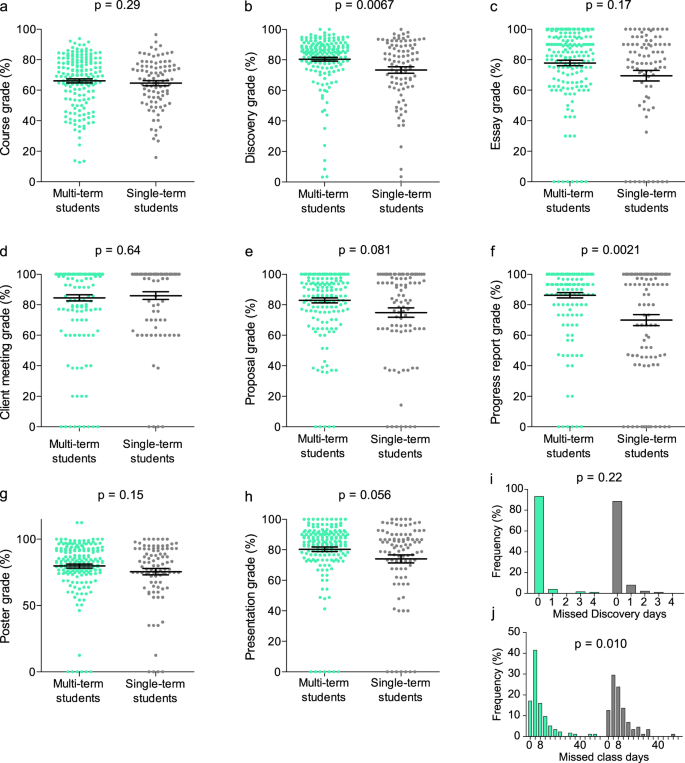
The “multi-term” (MT) subset of students (defined as having attended more than one term of Discovery ) demonstrated favorable performance in Discovery , ( a ) showing no difference in course grade compared to single-term students, but ( b outperforming them in final Discovery grade. Independent of the number of times participating in Discovery , MT students did not score significantly differently on their ( c ) essay, ( d ) client meeting, or ( g ) poster. They tended to outperform their single-term classmates on the ( e ) proposal and ( h ) final presentation and scored significantly higher on their ( f ) progress report. MT students showed no statistical difference in ( i ) Discovery attendance but did show ( j ) higher rates of classroom attendance than single-term students. N = 174 MT instances of student participation (76 individual students) and 94 single-term students. Grade data expressed as mean ± SEM.
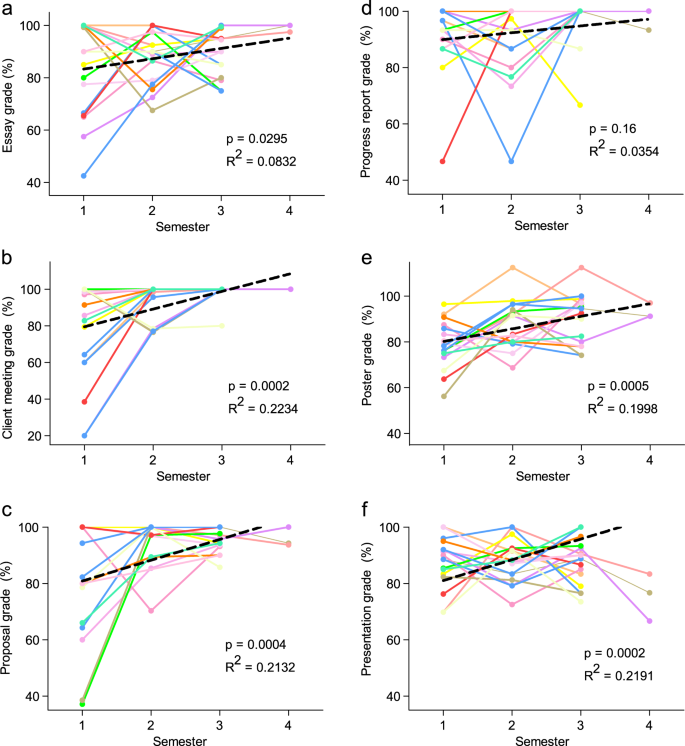
Longitudinal assessment of a subset of MT student participants that participated in three ( N = 16) or four ( N = 3) terms presents a significant trend of improvement in their ( a ) essay, ( b ) client meeting, ( c ) proposal, ( e ) poster, and ( f ) presentation grade. d Progress report grades present a trend in improvement but demonstrate strong performance in all terms, limiting potential for student improvement. Grade data are presented as individual student performance; each student is represented by one color; data is fitted with a linear trendline (black).
Finally, the expansion of Discovery to a second school of lower LOI (i.e., nominally higher aggregate SES) allowed for the assessment of program impact in a new population over 2 terms of programming. A significant ( p = 0.040) divergence in Discovery vs. course grade distribution from the theoretical 1:1 relationship was found in the new cohort (S 1 Appendix , Fig. S 1 ), in keeping with the pattern established in this study.
Teacher perceptions
Qualitative observation in the classroom by high school teachers emphasized the value students independently placed on program participation and deliverables. Throughout the term, students often prioritized Discovery group assignments over other tasks for their STEM courses, regardless of academic weight and/or due date. Comparing within this student population, teachers spoke of difficulties with late and incomplete assignments in the regular curriculum but found very few such instances with respect to Discovery -associated deliverables. Further, teachers speculated on the good behavior and focus of students in Discovery programming in contrast to attentiveness and behavior issues in their school classrooms. Multiple anecdotal examples were shared of renewed perception of student potential; students that exhibited poor academic performance in the classroom often engaged with high performance in this inquiry-focused atmosphere. Students appeared to take a sense of ownership, excitement, and pride in the setting of group projects oriented around scientific inquiry, discovery, and dissemination.
Student perceptions
Students were asked to consider and rank the academic difficulty (scale of 1–5, with 1 = not challenging and 5 = highly challenging) of the work they conducted within the Discovery learning model. Considering individual Discovery terms, at least 91% of students felt the curriculum to be sufficiently challenging with a 3/5 or higher ranking (Term 1: 87.5%, Term 2: 93.4%, Term 3: 85%, Term 4: 93.3%, Term 5: 100%), and a minimum of 58% of students indicating a 4/5 or higher ranking (Term 1: 58.3%, Term 2: 70.5%, Term 3: 67.5%, Term 4: 69.1%, Term 5: 86.4%) (Fig. 6a ).
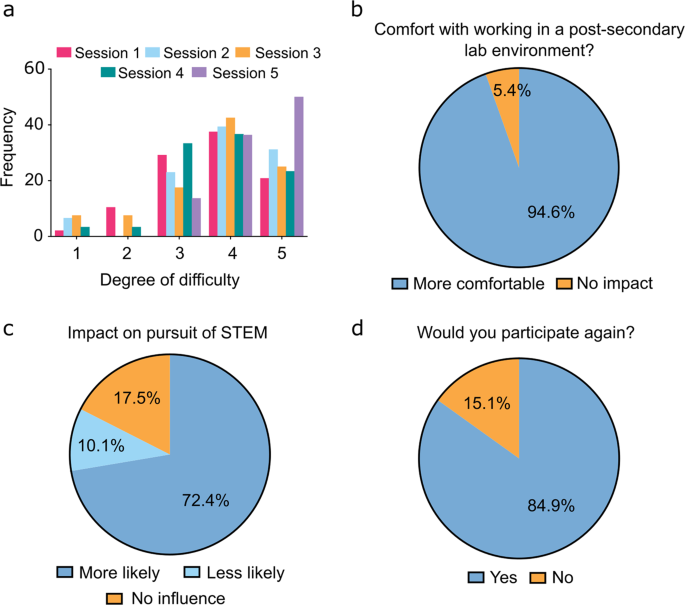
a Histogram of relative frequency of perceived Discovery programming academic difficulty ranked from not challenging (1) to highly challenging (5) for each session demonstrated the consistently perceived high degree of difficulty for Discovery programming (total responses: 223). b Program participation increased student comfort (94.6%) with navigating lab work in a university or college setting (total responses: 220). c Considering participation in Discovery programming, students indicated their increased (72.4%) or decreased (10.1%) likelihood to pursue future experiences in STEM as a measure of program impact (total responses: 217). d Large majority of participating students (84.9%) indicated their interest for future participation in Discovery (total responses: 212). Students were given the opportunity to opt out of individual survey questions, partially completed surveys were included in totals.
The majority of students (94.6%) indicated they felt more comfortable with the idea of performing future work in a university STEM laboratory environment given exposure to university teaching facilities throughout the program (Fig. 6b ). Students were also queried whether they were (i) more likely, (ii) less likely, or (iii) not impacted by their experience in the pursuit of STEM in the future. The majority of participants (>82%) perceived impact on STEM interests, with 72.4% indicating they were more likely to pursue these interests in the future (Fig. 6c ). When surveyed at the end of term, 84.9% of students indicated they would participate in the program again (Fig. 6d ).
We have described an inquiry-based framework for implementing experiential STEM education in a BME setting. Using this model, we engaged 268 instances of student participation (170 individual students who participated 1–4 times) over five terms in project-based learning wherein students worked in peer-based teams under the mentorship of U of T trainees to design and execute the scientific method in answering a relevant research question. Collaboration between high school teachers and Discovery instructors allowed for high school student exposure to cutting-edge BME research topics, participation in facilitated inquiry, and acquisition of knowledge through scientific discovery. All assessments were conducted by high school teachers and constituted a fraction (10–15%) of the overall course grade, instilling academic value for participating students. As such, students exhibited excitement to learn as well as commitment to their studies in the program.
Through our observations and analysis, we suggest there is value in differential learning environments for students that struggle in a knowledge acquisition-focused classroom setting. In general, we observed a high level of academic performance in Discovery programming (Fig. 2a ), which was highlighted exceptionally in EE students who exhibited greater academic performance in Discovery deliverables compared to normal coursework (>18% grade improvement in relevant deliverables). We initially considered whether this was the result of strong students influencing weaker students; however, group organization within each course suggests this is not the case (Fig. 2d ). With the exception of one class in one term (24 participants assigned by their teacher), students were allowed to self-organize into working groups and they chose to work with other students of relatively similar academic performance (as indicated by course grade), a trend observed in other studies 31 , 32 . Remarkably, EE students not only excelled during Discovery when compared to their own performance in class, but this cohort also achieved significantly higher average grades in each of the deliverables throughout the program when compared to the remaining Discovery cohort (Fig. 3 ). This data demonstrates the value of an inquiry-based learning environment compared to knowledge-focused delivery in the classroom in allowing students to excel. We expect that part of this engagement was resultant of student excitement with a novel learning opportunity. It is however a well-supported concept that students who struggle in traditional settings tend to demonstrate improved interest and motivation in STEM when given opportunity to interact in a hands-on fashion, which supports our outcomes 4 , 33 . Furthermore, these outcomes clearly represent variable student learning styles, where some students benefit from a greater exchange of information, knowledge and skills in a cooperative learning environment 34 . The performance of the EE group may not be by itself surprising, as the identification of the subset by definition required high performers in Discovery who did not have exceptionally high course grades; in addition, the final Discovery grade is dependent on the component assignment grades. However, the discrepancies between EE and non-EE groups attendance suggests that students were engaged by Discovery in a way that they were not by regular classroom curriculum.
In addition to quantified engagement in Discovery observed in academic performance, we believe remarkable attendance rates are indicative of the value students place in the differential learning structure. Given the differences in number of Discovery days and implications of missing one day of regular class compared to this immersive program, we acknowledge it is challenging to directly compare attendance data and therefore approximate this comparison with consideration of learning time equivalence. When combined with other subjective data including student focus, requests to work on Discovery during class time, and lack of discipline/behavior issues, the attendance data importantly suggests that students were especially engaged by the Discovery model. Further, we believe the increased commute time to the university campus (students are responsible for independent transit to campus, a much longer endeavour than the normal school commute), early program start time, and students’ lack of familiarity with the location are non-trivial considerations when determining the propensity of students to participate enthusiastically in Discovery . We feel this suggests the students place value on this team-focused learning and find it to be more applicable and meaningful to their interests.
Given post-secondary admission requirements for STEM programs, it would be prudent to think that students participating in multiple STEM classes across terms are the ones with the most inherent interest in post-secondary STEM programs. The MT subset, representing students who participated in Discovery for more than one term, averaged significantly higher final Discovery grades. The increase in the final Discovery grade was observed to result from a general confluence of improved performance over multiple deliverables and a continuous effort to improve in a STEM curriculum. This was reflected in longitudinal tracking of Discovery performance, where we observed a significant trend of improved performance. Interestingly, the high number of MT students who were included in the EE group suggests that students who had a keen interest in science enrolled in more than one course and in general responded well to the inquiry-based teaching method of Discovery , where scientific method was put into action. It stands to reason that students interested in science will continue to take STEM courses and will respond favorably to opportunities to put classroom theory to practical application.
The true value of an inquiry-based program such as Discovery may not be based in inspiring students to perform at a higher standard in STEM within the high school setting, as skills in critical thinking do not necessarily translate to knowledge-based assessment. Notably, students found the programming equally challenging throughout each of the sequential sessions, perhaps somewhat surprising considering the increasing number of repeat attendees in successive sessions (Fig. 6a ). Regardless of sub-discipline, there was an emphasis of perceived value demonstrated through student surveys where we observed indicated interest in STEM and comfort with laboratory work environments, and desire to engage in future iterations given the opportunity. Although non-quantitative, we perceive this as an indicator of significant student engagement, even though some participants did not yield academic success in the program and found it highly challenging given its ambiguity.
Although we observed that students become more certain of their direction in STEM, further longitudinal study is warranted to make claim of this outcome. Additionally, at this point in our assessment we cannot effectively assess the practical outcomes of participation, understanding that the immediate effects observed are subject to a number of factors associated with performance in the high school learning environment. Future studies that track graduates from this program will be prudent, in conjunction with an ever-growing dataset of assessment as well as surveys designed to better elucidate underlying perceptions and attitudes, to continue to understand the expected benefits of this inquiry-focused and partnered approach. Altogether, a multifaceted assessment of our early outcomes suggests significant value of an immersive and iterative interaction with STEM as part of the high school experience. A well-defined divergence from knowledge-based learning, focused on engagement in critical thinking development framed in the cutting-edge of STEM, may be an important step to broadening student perspectives.
In this study, we describe the short-term effects of an inquiry-based STEM educational experience on a cohort of secondary students attending a non-specialized school, and suggest that the framework can be widely applied across virtually all subjects where inquiry-driven and mentored projects can be undertaken. Although we have demonstrated replication in a second cohort of nominally higher SES (S 1 Appendix , Supplementary Fig. 1 ), a larger collection period with more students will be necessary to conclusively determine impact independent of both SES and specific cohort effects. Teachers may also find this framework difficult to implement depending on resources and/or institutional investment and support, particularly if post-secondary collaboration is inaccessible. Offerings to a specific subject (e.g., physics) where experiments yielding empirical data are logistically or financially simpler to perform may be valid routes of adoption as opposed to the current study where all subject cohorts were included.
As we consider Discovery in a bigger picture context, expansion and implementation of this model is translatable. Execution of the scientific method is an important aspect of citizen science, as the concepts of critical thing become ever-more important in a landscape of changing technological landscapes. Giving students critical thinking and problem-solving skills in their primary and secondary education provides value in the context of any career path. Further, we feel that this model is scalable across disciplines, STEM or otherwise, as a means of building the tools of inquiry. We have observed here the value of differential inclusive student engagement and critical thinking through an inquiry-focused model for a subset of students, but further to this an engagement, interest, and excitement across the body of student participants. As we educate the leaders of tomorrow, we suggest that use of an inquiry-focused model such as Discovery could facilitate growth of a data-driven critical thinking framework.
In conclusion, we have presented a model of inquiry-based STEM education for secondary students that emphasizes inclusion, quantitative analysis, and critical thinking. Student grades suggest significant performance benefits, and engagement data suggests positive student attitude despite the perceived challenges of the program. We also note a particular performance benefit to students who repeatedly engage in the program. This framework may carry benefits in a wide variety of settings and disciplines for enhancing student engagement and performance, particularly in non-specialized school environments.
Study design and implementation
Participants in Discovery include all students enrolled in university-stream Grade 11 or 12 biology, chemistry, or physics at the participating school over five consecutive terms (cohort summary shown in Table 1 ). Although student participation in educational content was mandatory, student grades and survey responses (administered by high school teachers) were collected from only those students with parent or guardian consent. Teachers replaced each student name with a unique coded identifier to preserve anonymity but enable individual student tracking over multiple terms. All data collected were analyzed without any exclusions save for missing survey responses; no power analysis was performed prior to data collection.
Ethics statement
This study was approved by the University of Toronto Health Sciences Research Ethics Board (Protocol # 34825) and the Toronto District School Board External Research Review Committee (Protocol # 2017-2018-20). Written informed consent was collected from parents or guardians of participating students prior to the acquisition of student data (both post-hoc academic data and survey administration). Data were anonymized by high school teachers for maintenance of academic confidentiality of individual students prior to release to U of T researchers.
Educational program overview
Students enrolled in university-preparatory STEM classes at the participating school completed a term-long project under the guidance of graduate student instructors and undergraduate student mentors as a mandatory component of their respective course. Project curriculum developed collaboratively between graduate students and participating high school teachers was delivered within U of T Faculty of Applied Science & Engineering (FASE) teaching facilities. Participation allows high school students to garner a better understanding as to how undergraduate learning and career workflows in STEM vary from traditional high school classroom learning, meanwhile reinforcing the benefits of problem solving, perseverance, teamwork, and creative thinking competencies. Given that Discovery was a mandatory component of course curriculum, students participated as class cohorts and addressed questions specific to their course subject knowledge base but related to the defined global health research topic (Fig. 1 ). Assessment of program deliverables was collectively assigned to represent 10–15% of the final course grade for each subject at the discretion of the respective STEM teacher.
The Discovery program framework was developed, prior to initiation of student assessment, in collaboration with one high school selected from the local public school board over a 1.5 year period of time. This partner school consistently scores highly (top decile) in the school board’s Learning Opportunities Index (LOI). The LOI ranks each school based on measures of external challenges affecting its student population therefore schools with the greatest level of external challenge receive a higher ranking 35 . A high LOI ranking is inversely correlated with socioeconomic status (SES); therefore, participating students are identified as having a significant number of external challenges that may affect their academic success. The mandatory nature of program participation was established to reach highly capable students who may be reluctant to engage on their own initiative, as a means of enhancing the inclusivity and impact of the program. The selected school partner is located within a reasonable geographical radius of our campus (i.e., ~40 min transit time from school to campus). This is relevant as participating students are required to independently commute to campus for Discovery hands-on experiences.
Each program term of Discovery corresponds with a five-month high school term. Lead university trainee instructors (3–6 each term) engaged with high school teachers 1–2 months in advance of high school student engagement to discern a relevant overarching global healthcare theme. Each theme was selected with consideration of (a) topics that university faculty identify as cutting-edge biomedical research, (b) expertise that Discovery instructors provide, and (c) capacity to showcase the diversity of BME. Each theme was sub-divided into STEM subject-specific research questions aligning with provincial Ministry of Education curriculum concepts for university-preparatory Biology, Chemistry, and Physics 9 that students worked to address, both on-campus and in-class, during a term-long project. The Discovery framework therefore provides students a problem-based learning experience reflective of an engineering capstone design project, including a motivating scientific problem (i.e., global topic), subject-specific research question, and systematic determination of a professional recommendation addressing the needs of the presented problem.
Discovery instructors were volunteers recruited primarily from graduate and undergraduate BME programs in the FASE. Instructors were organized into subject-specific instructional teams based on laboratory skills, teaching experience, and research expertise. The lead instructors of each subject (the identified 1–2 trainees that built curriculum with high school teachers) were responsible to organize the remaining team members as mentors for specific student groups over the course of the program term (~1:8 mentor to student ratio).
All Discovery instructors were familiarized with program expectations and trained in relevant workspace safety, in addition to engagement at a teaching workshop delivered by the Faculty Advisor (a Teaching Stream faculty member) at the onset of term. This workshop was designed to provide practical information on teaching and was co-developed with high school teachers based on their extensive training and experience in fundamental teaching methods. In addition, group mentors received hands-on training and guidance from lead instructors regarding the specific activities outlined for their respective subject programming (an exemplary term of student programming is available in S 2 Appendix) .
Discovery instructors were responsible for introducing relevant STEM skills and mentoring high school students for the duration of their projects, with support and mentorship from the Faculty Mentor. Each instructor worked exclusively throughout the term with the student groups to which they had been assigned, ensuring consistent mentorship across all disciplinary components of the project. In addition to further supporting university trainees in on-campus mentorship, high school teachers were responsible for academic assessment of all student program deliverables (Fig. 1 ; the standardized grade distribution available in S 3 Appendix ). Importantly, trainees never engaged in deliverable assessment; for continuity of overall course assessment, this remained the responsibility of the relevant teacher for each student cohort.
Throughout each term, students engaged within the university facilities four times. The first three sessions included hands-on lab sessions while the fourth visit included a culminating symposium for students to present their scientific findings (Fig. 1 ). On average, there were 4–5 groups of students per subject (3–4 students per group; ~20 students/class). Discovery instructors worked exclusively with 1–2 groups each term in the capacity of mentor to monitor and guide student progress in all project deliverables.
After introducing the selected global research topic in class, teachers led students in completion of background research essays. Students subsequently engaged in a subject-relevant skill-building protocol during their first visit to university teaching laboratory facilities, allowing opportunity to understand analysis techniques and equipment relevant for their assessment projects. At completion of this session, student groups were presented with a subject-specific research question as well as the relevant laboratory inventory available for use during their projects. Armed with this information, student groups continued to work in their classroom setting to develop group-specific experimental plans. Teachers and Discovery instructors provided written and oral feedback, respectively , allowing students an opportunity to revise their plans in class prior to on-campus experimental execution.
Once at the relevant laboratory environment, student groups executed their protocols in an effort to collect experimental data. Data analysis was performed in the classroom and students learned by trial & error to optimize their protocols before returning to the university lab for a second opportunity of data collection. All methods and data were re-analyzed in class in order for students to create a scientific poster for the purpose of study/experience dissemination. During a final visit to campus, all groups presented their findings at a research symposium, allowing students to verbally defend their process, analyses, interpretations, and design recommendations to a diverse audience including peers, STEM teachers, undergraduate and graduate university students, postdoctoral fellows and U of T faculty.
Data collection
Teachers evaluated their students on the following associated deliverables: (i) global theme background research essay; (ii) experimental plan; (iii) progress report; (iv) final poster content and presentation; and (v) attendance. For research purposes, these grades were examined individually and also as a collective Discovery program grade for each student. For students consenting to participation in the research study, all Discovery grades were anonymized by the classroom teacher before being shared with study authors. Each student was assigned a code by the teacher for direct comparison of deliverable outcomes and survey responses. All instances of “Final course grade” represent the prorated course grade without the Discovery component, to prevent confounding of quantitative analyses.
Survey instruments were used to gain insight into student attitudes and perceptions of STEM and post-secondary study, as well as Discovery program experience and impact (S 4 Appendix ). High school teachers administered surveys in the classroom only to students supported by parental permission. Pre-program surveys were completed at minimum 1 week prior to program initiation each term and exit surveys were completed at maximum 2 weeks post- Discovery term completion. Surveys results were validated using a principal component analysis (S 1 Appendix , Supplementary Fig. 2 ).
Identification and comparison of population subsets
From initial analysis, we identified two student subpopulations of particular interest: students who performed ≥1 SD [18.0%] or greater in the collective Discovery components of the course compared to their final course grade (“EE”), and students who participated in Discovery more than once (“MT”). These groups were compared individually against the rest of the respective Discovery population (“non-EE” and “non-MT”, respectively ). Additionally, MT students who participated in three or four (the maximum observed) terms of Discovery were assessed for longitudinal changes to performance in their course and Discovery grades. Comparisons were made for all Discovery deliverables (introductory essay, client meeting, proposal, progress report, poster, and presentation), final Discovery grade, final course grade, Discovery attendance, and overall attendance.
Statistical analysis
Student course grades were analyzed in all instances without the Discovery contribution (calculated from all deliverable component grades and ranging from 10 to 15% of final course grade depending on class and year) to prevent correlation. Aggregate course grades and Discovery grades were first compared by paired t-test, matching each student’s course grade to their Discovery grade for the term. Student performance in Discovery ( N = 268 instances of student participation, comprising 170 individual students that participated 1–4 times) was initially assessed in a linear regression of Discovery grade vs. final course grade. Trends in course and Discovery performance over time for students participating 3 or 4 terms ( N = 16 and 3 individuals, respectively ) were also assessed by linear regression. For subpopulation analysis (EE and MT, N = 99 instances from 81 individuals and 174 instances from 76 individuals, respectively ), each dataset was tested for normality using the D’Agostino and Pearson omnibus normality test. All subgroup comparisons vs. the remaining population were performed by Mann–Whitney U -test. Data are plotted as individual points with mean ± SEM overlaid (grades), or in histogram bins of 1 and 4 days, respectively , for Discovery and class attendance. Significance was set at α ≤ 0.05.
Reporting summary
Further information on research design is available in the Nature Research Reporting Summary linked to this article.
Data availability
The data that support the findings of this study are available upon reasonable request from the corresponding author DMK. These data are not publicly available due to privacy concerns of personal data according to the ethical research agreements supporting this study.
Holmes, K., Gore, J., Smith, M. & Lloyd, A. An integrated analysis of school students’ aspirations for STEM careers: Which student and school factors are most predictive? Int. J. Sci. Math. Educ. 16 , 655–675 (2018).
Article Google Scholar
Dooley, M., Payne, A., Steffler, M. & Wagner, J. Understanding the STEM path through high school and into university programs. Can. Public Policy 43 , 1–16 (2017).
Gilmore, M. W. Improvement of STEM education: experiential learning is the key. Mod. Chem. Appl. 1, e109. https://doi.org/10.4172/2329-6798.1000e109 (2013).
Roberts, T. et al. Students’ perceptions of STEM learning after participating in a summer informal learning experience. Int. J. STEM Educ. 5 , 35 (2018).
Gillies, R. M. & Boyle, M. Teachers’ reflections on cooperative learning: Issues of implementation. Teach. Teach. Educ. 26 , 933–940 (2010).
Nasir, M., Seta, J. & Meyer, E.G. Introducing high school students to biomedical engineering through summer camps. Paper presented at the ASEE Annual Conference & Exposition, Indianapolis, IN. https://doi.org/10.18260/1-2-20701 (2014).
Sadler, P. M., Sonnert, G., Hazari, Z. & Tai, R. Stability and volatility of STEM career interest in high school: a gender study. Sci. Educ. 96 , 411–427 (2012).
Sarikas, C. The High School Science Classes You Should Take . https://blog.prepscholar.com/the-high-school-science-classes-you-should-take (2020).
Ontario, G. o. The ontario curriculum grades 11 and 12. Science http://www.edu.gov.on.ca/eng/curriculum/secondary/2009science11_12.pdf (2008).
Scott, C. An investigation of science, technology, engineering and mathematics (STEM) focused high schools in the US. J. STEM Educ.: Innov. Res. 13 , 30 (2012).
Google Scholar
Erdogan, N. & Stuessy, C. L. Modeling successful STEM high schools in the United States: an ecology framework. Int. J. Educ. Math., Sci. Technol. 3 , 77–92 (2015).
Pfeiffer, S. I., Overstreet, J. M. & Park, A. The state of science and mathematics education in state-supported residential academies: a nationwide survey. Roeper Rev. 32 , 25–31 (2009).
Anthony, A. B., Greene, H., Post, P. E., Parkhurst, A. & Zhan, X. Preparing university students to lead K-12 engineering outreach programmes: a design experiment. Eur. J. Eng. Educ. 41 , 623–637 (2016).
Brown, J. S., Collins, A. & Duguid, P. Situated cognition and the culture of learning. Educ. researcher 18 , 32–42 (1989).
Reveles, J. M. & Brown, B. A. Contextual shifting: teachers emphasizing students’ academic identity to promote scientific literacy. Sci. Educ. 92 , 1015–1041 (2008).
Adedokun, O. A., Bessenbacher, A. B., Parker, L. C., Kirkham, L. L. & Burgess, W. D. Research skills and STEM undergraduate research students’ aspirations for research careers: mediating effects of research self-efficacy. J. Res. Sci. Teach. 50 , 940–951 (2013).
Boekaerts, M. Self-regulated learning: a new concept embraced by researchers, policy makers, educators, teachers, and students. Learn. Instr. 7 , 161–186 (1997).
Honey, M., Pearson, G. & Schweingruber, H. STEM Integration in K-12 Education: Status, Prospects, and An Agenda for Research . (National Academies Press, Washington, DC, 2014).
Moote, J. K., Williams, J. M. & Sproule, J. When students take control: investigating the impact of the crest inquiry-based learning program on self-regulated processes and related motivations in young science students. J. Cogn. Educ. Psychol. 12 , 178–196 (2013).
Fantz, T. D., Siller, T. J. & Demiranda, M. A. Pre-collegiate factors influencing the self-efficacy of engineering students. J. Eng. Educ. 100 , 604–623 (2011).
Ralston, P. A., Hieb, J. L. & Rivoli, G. Partnerships and experience in building STEM pipelines. J. Professional Issues Eng. Educ. Pract. 139 , 156–162 (2012).
Kelley, T. R. & Knowles, J. G. A conceptual framework for integrated STEM education. Int. J. STEM Educ. 3 , 11 (2016).
Brown, P. L., Concannon, J. P., Marx, D., Donaldson, C. W. & Black, A. An examination of middle school students’ STEM self-efficacy with relation to interest and perceptions of STEM. J. STEM Educ.: Innov. Res. 17 , 27–38 (2016).
Bandura, A., Barbaranelli, C., Caprara, G. V. & Pastorelli, C. Self-efficacy beliefs as shapers of children’s aspirations and career trajectories. Child Dev. 72 , 187–206 (2001).
Article CAS Google Scholar
Davenport Huyer, L. et al. IBBME discovery: biomedical engineering-based iterative learning in a high school STEM curriculum (evaluation). Paper presented at ASEE Annual Conference & Exposition, Salt Lake City, UT. https://doi.org/10.18260/1-2-30591 (2018).
Abu-Faraj, Ziad O., ed. Handbook of research on biomedical engineering education and advanced bioengineering learning: interdisciplinary concepts: interdisciplinary concepts. Vol. 2. IGI Global (2012).
Johri, A. & Olds, B. M. Situated engineering learning: bridging engineering education research and the learning sciences. J. Eng. Educ. 100 , 151–185 (2011).
O’Connell, K. B., Keys, B. & Storksdieck, M. Taking stock of oregon STEM hubs: accomplishments and challenges. Corvallis: Oregon State University https://ir.library.oregonstate.edu/concern/articles/hq37vt23t (2017).
Freeman, K. E., Alston, S. T. & Winborne, D. G. Do learning communities enhance the quality of students’ learning and motivation in STEM? J. Negro Educ. 77 , 227–240 (2008).
Weaver, R. R. & Qi, J. Classroom organization and participation: college students’ perceptions. J. High. Educ. 76 , 570–601 (2005).
Chapman, K. J., Meuter, M., Toy, D. & Wright, L. Can’t we pick our own groups? The influence of group selection method on group dynamics and outcomes. J. Manag. Educ. 30 , 557–569 (2006).
Hassaskhah, J. & Mozaffari, H. The impact of group formation method (student-selected vs. teacher-assigned) on group dynamics and group outcome in EFL creative writing. J. Lang. Teach. Res. 6 , 147–156 (2015).
Ma, V. J. & Ma, X. A comparative analysis of the relationship between learning styles and mathematics performance. Int. J. STEM Educ. 1 , 3 (2014).
Weinstein, C. E. & Hume, L. M. Study Strategies for Lifelong Learning . (American Psychological Association, 1998).
Toronto District School Board. The 2017 Learning Opportunities Index: Questions and Answers. https://www.tdsb.on.ca/Portals/research/docs/reports/LOI2017v2.pdf (2017).
Download references
Acknowledgements
This study has been possible due to the support of many University of Toronto trainee volunteers, including Genevieve Conant, Sherif Ramadan, Daniel Smieja, Rami Saab, Andrew Effat, Serena Mandla, Cindy Bui, Janice Wong, Dawn Bannerman, Allison Clement, Shouka Parvin Nejad, Nicolas Ivanov, Jose Cardenas, Huntley Chang, Romario Regeenes, Dr. Henrik Persson, Ali Mojdeh, Nhien Tran-Nguyen, Ileana Co, and Jonathan Rubianto. We further acknowledge the staff and administration of George Harvey Collegiate Institute and the Institute of Biomedical Engineering (IBME), as well as Benjamin Rocheleau and Madeleine Rocheleau for contributions to data collation. Discovery has grown with continued support of Dean Christopher Yip (Faculty of Applied Science and Engineering, U of T), and the financial support of the IBME and the National Science and Engineering Research Council (NSERC) PromoScience program (PROSC 515876-2017; IBME “Igniting Youth Curiosity in STEM” initiative co-directed by DMK and Dr. Penney Gilbert). LDH and NIC were supported by Vanier Canada graduate scholarships from the Canadian Institutes of Health Research and NSERC, respectively . DMK holds a Dean’s Emerging Innovation in Teaching Professorship in the Faculty of Engineering & Applied Science, U of T.
Author information
These authors contributed equally: Locke Davenport Huyer, Neal I. Callaghan.
Authors and Affiliations
Institute of Biomedical Engineering, University of Toronto, Toronto, ON, Canada
Locke Davenport Huyer, Neal I. Callaghan, Andrey I. Shukalyuk & Dawn M. Kilkenny
Chemical Engineering and Applied Chemistry, University of Toronto, Toronto, ON, Canada
Locke Davenport Huyer
Translational Biology and Engineering Program, Ted Rogers Centre for Heart Research, University of Toronto, Toronto, ON, Canada
Neal I. Callaghan
George Harvey Collegiate Institute, Toronto District School Board, Toronto, ON, Canada
Sara Dicks, Edward Scherer & Margaret Jou
Institute for Studies in Transdisciplinary Engineering Education & Practice, University of Toronto, Toronto, ON, Canada
Dawn M. Kilkenny
You can also search for this author in PubMed Google Scholar
Contributions
LDH, NIC and DMK conceived the program structure, designed the study, and interpreted the data. LDH and NIC ideated programming, coordinated execution, and performed all data analysis. SD, ES, and MJ designed and assessed student deliverables, collected data, and anonymized data for assessment. SD assisted in data interpretation. AIS assisted in programming ideation and design. All authors provided feedback and approved the manuscript that was written by LDH, NIC and DMK.

Corresponding author
Correspondence to Dawn M. Kilkenny .
Ethics declarations
Competing interests.
The authors declare no competing interests.
Additional information
Publisher’s note Springer Nature remains neutral with regard to jurisdictional claims in published maps and institutional affiliations.
Supplementary information
Supplemental material, reporting summary, rights and permissions.
Open Access This article is licensed under a Creative Commons Attribution 4.0 International License, which permits use, sharing, adaptation, distribution and reproduction in any medium or format, as long as you give appropriate credit to the original author(s) and the source, provide a link to the Creative Commons license, and indicate if changes were made. The images or other third party material in this article are included in the article’s Creative Commons license, unless indicated otherwise in a credit line to the material. If material is not included in the article’s Creative Commons license and your intended use is not permitted by statutory regulation or exceeds the permitted use, you will need to obtain permission directly from the copyright holder. To view a copy of this license, visit http://creativecommons.org/licenses/by/4.0/ .
Reprints and permissions
About this article
Cite this article.
Davenport Huyer, L., Callaghan, N.I., Dicks, S. et al. Enhancing senior high school student engagement and academic performance using an inclusive and scalable inquiry-based program. npj Sci. Learn. 5 , 17 (2020). https://doi.org/10.1038/s41539-020-00076-2
Download citation
Received : 05 December 2019
Accepted : 08 October 2020
Published : 02 December 2020
DOI : https://doi.org/10.1038/s41539-020-00076-2
Share this article
Anyone you share the following link with will be able to read this content:
Sorry, a shareable link is not currently available for this article.
Provided by the Springer Nature SharedIt content-sharing initiative
Quick links
- Explore articles by subject
- Guide to authors
- Editorial policies
Sign up for the Nature Briefing newsletter — what matters in science, free to your inbox daily.
- Skip to primary navigation
- Skip to main content
- Skip to primary sidebar
- Skip to footer
Teaching ELA with Joy
Middle School ELA Resources
6 Ideas for Teaching Research Skills
By Joy Sexton Leave a Comment
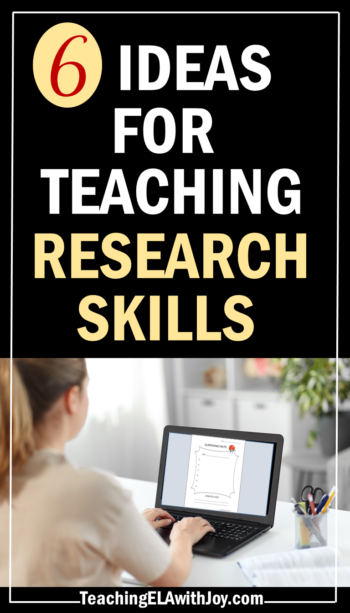
When thinking about ideas for teaching research skills, teachers can easily become overwhelmed. That’s mainly because our standards list so many requirements for students to master! If your school requires a major research paper, you might need to start off with some smaller practice pieces. Do your students know how to paraphrase? Can they judge if a website is credible? Do they know how to compose an open-ended question? How about citing sources? Check out these activities that will help your students gain essential practice with research skills.
Ideas for Teaching Research Skills
1. Say It Your Way – One great place to start is getting students in the habit of paraphrasing. Choose an interesting topic and a short article to demonstrate. An online encyclopedia comes in handy here. We worked with information on a particular dinosaur. Project the article and with class participation, highlight 5 pieces of key information. This is the information students will be “taking notes” on. Then query the students how each piece of information could be stated in bulleted notes (without copying full sentences!). Model the bulleted note-taking as students complete their own copy. When the bulleted notes are complete, engage the class in composing new sentences that are paraphrased. Again, model writing this paragraph as students follow suit. Now the process of note-taking and paraphrasing should seem “doable” in their own research.
2. Surprising Facts – A fun way for students to dive into research is to give them a topic and simply task them with finding facts that are surprising . This activity works great with partners. Topics could tie in with a current class novel or story (such as “elephant” from The Giver) or even an author. Surprising facts about Gary Paulsen, Kwame Alexander, or Edgar Alan Poe make an interesting class discussion! Students enjoy sharing their findings. I devised a free handout where students can record the topic, their surprising facts, and the website(s) they used. Grab it in Google Docs and copy to your drive by clicking the link: https://bit.ly/3Nah9UB
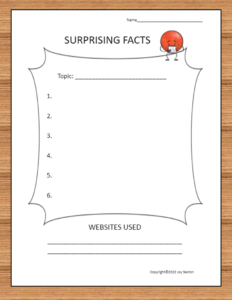
3. Give Credit Where It’s Due – Most students understand that sources need to be cited. However, many remain unclear on the process. A demonstration using a citation generator will help. I like www.bibme.org , but if you google “citation generator” you’ll find a slew of them. I open a few tabs in advance with animal websites. To demonstrate, grab the URLs and insert into the generator. Cut and paste the citations to a blank document. Then you can show students how to indent and alphabetize. For practice, give students a list of several websites. You could also include a magazine article and a book. With a partner, have them construct the works cited using a generator, indenting and alphabetizing correctly.
4. Support an Opinion – Students love to voice their opinions , but need practice supporting them with facts . Lucky for us, there are loads of argument topics available free online. You can offer several topic choices, and students choose one and respond with their opinion. Next, have them locate 2-3 important facts or statistics that specifically support their opinion. Make sure to emphasize that the information will need to be paraphrased. And since sources were used, a Works Cited should also be added.
5. Good Question! – One purpose of research is to answer a question, so students need practice in formulating good questions . An open-ended question, one that requires more than just one answer, is the goal. Start by demonstrating the difference between an open-ended question and a “thin” or “skinny” question (not open-ended). One way is to project an image of a violin on your whiteboard. Then type or write out these questions: 1. How many strings does a violin have? 2. How is a violin made? Ask students which is the open-ended question and why. Then project another image. Ask for volunteers to formulate a thin question, and then an open-ended question. Once they understand this concept, let all students practice composing both thin and open-ended questions. This activity works well in groups. Each student contributes a topic.
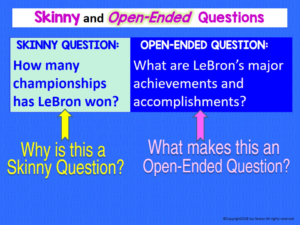
6. Format is Key – A sure-fire way to get students excited about a research project is offering engaging formats for presentation. PowerPoint is well known by most students, but take time to demonstrate some other great options. Canva allows students to create awesome Infographics! Or how about a tri-fold brochure in Publisher? Students can make up a quick template with custom headings. Set a timer for 10-15 minutes and let students experiment with the possibilities. My students have enjoyed a Q & A format, using a template I created with PowerPoint. Even students who prefer typing their report in paragraphs can easily design a poster. Along with the paragraphs, just add images, captions, topic, and headings.
I hope I have broadened your ideas for teaching research skills. I think you’ll agree that students need time and mini-lessons to get comfortable with the procedures we require. A quick graphic organizer coupled with a short activity can help solidify the skills they’ll need.
Here’s another post I wrote that will give you more helpful ideas for teaching research skills: 10 Ideas to Make Teaching Research Easier
Join the Newsletter
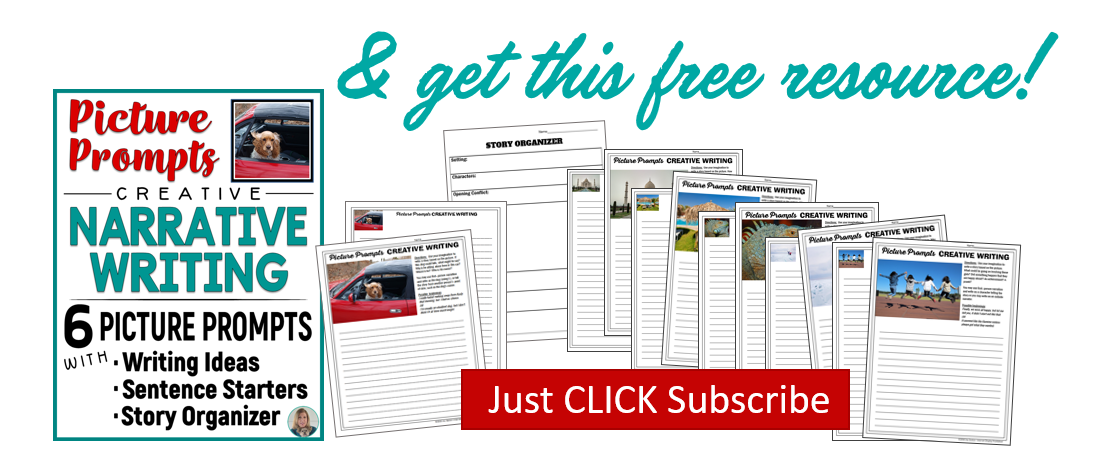
Reader Interactions
Leave a reply cancel reply.
Your email address will not be published. Required fields are marked *
Save my name, email, and website in this browser for the next time I comment.
Notify me of follow-up comments by email.
Notify me of new posts by email.
This site uses Akismet to reduce spam. Learn how your comment data is processed .

Teaching Students Better Online Research Skills
- Share article
Sara Shaw, an elementary school teacher in Avon, Mass., realized she needed to teach online research skills several years ago when her students kept turning in projects riddled with misinformation. The flawed material often came from websites the students used. They took the information as fact, when it often was just someone’s personal opinion.
Ms. Shaw thinks teaching online research skills is even more critical than it was just a few years ago. More than ever, information is literally at the fingertips of students through smartphones, tablet computers, and other digital devices.
“They will go on Google and type a word, and that is the extent of their research skills,” said Ms. Shaw, who taught 5th grade for 10 years and now teaches special education at Ralph D. Butler Elementary School. “There is so much more to doing research on the Internet.”
She is one of many teachers and librarians who are explicitly teaching online research skills, such as how to evaluate a website’s credibility, how to use precise keywords, and how to better mine search engines and databases.
In November 2012, the Pew Research Center’s Internet & American Life Project released a study that surveyed 2,067 Advanced Placement and National Writing Project teachers. It found that while most teachers agreed that the Internet provides a wealth of information to students, they also said students often don’t have the digital-literacy skills to wade through that information. Forty-seven percent of the teachers surveyed said they “strongly agree” and another 44 percent said they “somewhat believe” that courses and content focusing on digital literacy should be incorporated into the school curriculum.
Smart Searching
Teaching students to be savvy online researchers starts with knowing how to use key words. That is something 6th grader Katie Lacey has worked hard to master.
“You need precise words,” said Katie, a student at Albuquerque Academy, a private school for grades 6-12 in New Mexico. “If I’m looking up the John F. Kennedy assassination, I have to use those words. If I type in just Kennedy assassination, I could get information on Robert Kennedy.”
Another important skill to teach students is how to predict the results they expect to see when they type in search terms, said Tasha Bergson-Michelson, a librarian who works for the Google Search Education team at the technology company’s headquarters in Mountain View, Calif. Doing that can help them know when they may need to change their terms, she said.
In addition, Ms. Bergson-Michelson advises students to skim search results for words that pop up, especially unfamiliar words. People have a tendency to skip over words they don’t know, she said. But those words, when added to search terms, can lead to more meaningful results. For instance, if a student wanted to find information on immigrants who send money back to their home countries, the term “remittances” comes up on search results.
“When you change the search to include the word “remittance,” immediately the type of sources are qualitatively different and more suited for an academic or scholarly pursuit,” Ms. Bergson-Michelson said.
Using search operators, words, or symbols that join key words to form a more complex query can make searching more focused.
Students can put quotation marks around their search terms to get results that include the exact wording. A minus sign eliminates something from a search. For instance, if students wanted to find information about the planet Saturn, but not the car of that name, they could type “Saturn-car” to narrow their results. Using “and” between search terms can give results that focus on two subjects, such as Martin Luther King Jr. and Malcolm X.
Choosing Search Engines
Finding the right search engine or database is also an important step in conducting online research, said Frances Jacobson Harris, a librarian at University Laboratory High School in Urbana, Ill.
She encourages students to use Google Scholar, which includes academic and scholarly sources of information. Google Books allows searchers to read pages from books, and if the information is useful, a searcher can then find the book in a library collection.
Gloria Ha, a junior at University Laboratory High School, said she first started learning about effective search techniques in 8th grade. Knowing how to search has made her more thoughtful in her approaches to finding information online.
“I usually start with Google Scholar or Google just to figure out what the topic is. Once I have a better idea, I’ll go deeper,” she said. “For example, if it’s a history paper, I’ll use the online library catalog, or sometimes there are e-books online through the university.”
Ms. Harris teaches students how to access the invisible Web, databases that schools and libraries pay a fee to access. Those databases include scholarly articles, academic journals, online encyclopedias, archived editions of periodicals such as The New York Times , and other resources.
Some teachers steer students toward sites and search engines written specifically for children.
For example, the Kentucky Virtual Library , a consortium of libraries that provides residents of the state access to online databases—has a portal for K-12 students that outlines the steps for conducting online research, including how to use key words and how to organize information into notes, that is written in student-friendly language and designed to appeal visually to young children.
The portal also allows young users to access databases geared to children, including Searchasaurus and Grolier Online.
“They are more likely to get the right information at their reading level than simply going on Google,” said Enid Wohlstein, the director of the library, which is based in Frankfort.
Ed Baklini, a 6th grade history teacher at Albuquerque Academy in New Mexico, advises his students when using Google to type in a key word and the word “kid” after it. Doing so pulls up results for younger students. Mr. Baklini also directs them to free databases such as an educational site managed by the Lone Star College System in Texas that contains information about American history decade by decade.
“When you go to one of these sites, there are hundreds of other trusted links to go to,” he said. “This information comes from librarians and teachers who have taught history.”
Evaluating Websites
Just as critical as smart searching is evaluating the information on the Web. Students can take specific steps to dissect a website, such as checking whether its URL ends in a .com, .org, .gov, or .edu.
“If it’s from a university, museum, government, or some state run agency, then it’s pretty valid,” Ms. Shaw of Butler Elementary School said. “If it’s someone’s personal website, how do you know what that person is saying is true?”
In any case, students should approach websites with a critical eye.
“They should ask themselves while searching on sites: Who wrote this? What is the perspective of the person who wrote this?” said Rebecca Randall, the vice president of education programs for Common Sense Media , a San Francisco-based nonprofit group that studies the effects of media and technology on young people.
“Or else while searching for information on African-American history, they could wind up on the site for the Ku Klux Klan.”
It’s also important to know if a site is commercial. If so, it may be slanted toward having users buy products.
“Not that advertising on a site makes it less credible,” Ms. Randall said. “But it’s just another point to consider when looking at information. What is the intent of the information?”
When students take the time to approach their Web research thoughtfully, they sometimes encounter websites that are biased. Ms. Harris, the University Laboratory High librarian, recalls working with a student who was writing a paper on George Orwell’s 1984 . The boy found an essay about the book on the site of the Institute for Historical Review. Upon closer examination, the website was a Holocaust-denial website, Ms. Harris said.
“It looks scholarly because it’s called ‘institute,’ and there are citations at the bottom,” she said.
To help students scrutinize websites, Ms. Harris uses a lesson called “Whodunit,” which takes students to various sites and has them answer questions about who wrote the information, what their credentials are, and who is sponsoring the site.
Ms. Shaw provides a checklist to help students decide whether sites are credible. It includes questions such as: Are there dead links? Do images support the stated facts? Are there links and references to other websites, and resources and experts that corroborate the information?
Mr. Baklini of Albuquerque Academy advises his students to be aware of sites where the language comes on too strong and the attempt is to persuade readers how to think.
He also starts the school year by teaching a media-literacy unit in which he shows students how to examine the persuasive techniques advertisers use when trying to sell products. The point is to teach his students how to look at media carefully. That ability to scrutinize carries over to their Web research, he said.
“I have them think about these persuasive techniques, and I say if you see any of those techniques in there, if someone is trying to convince you to think a certain way, you can still read that website, but take it with a grain of salt,” he said.
It can be difficult for teachers to carve out time to teach yet another set of skills. But it’s important to do so, Ms. Randall of Common Sense Media said.
“If you don’t take time to do it, the kids aren’t going to be giving you their best work,” she said. “You have kids pulling information from sources that are not reliable and building a hypothesis or research paper around information that isn’t accurate.”
Modeling the Process
Teachers should model the process for searching online and make it something students do regularly in their classes, educators say.
Ms. Shaw integrated searching into her classroom by creating a classroom job of “searcher.” That student’s responsibility was to search the Internet for answers to questions that would come up during the day’s class. Ms. Shaw used that approach as an opportunity to talk about strategies for good online research.
Teaching students solid online search skills is important not only because it will help them produce better work, but also because it prepares them to judge the validity of all sorts of information and to be critical thinkers.
Librarians have a natural place in the forefront of helping students be more adept at online research.
“School librarians should be a partner in this,” Ms. Harris said. “Oftentimes, teachers don’t realize that, or sadly schools don’t have school librarians.”
Teachers should give credit to the process of searching, not just for the final product, she added. Students can turn in search logs or annotated bibliographies to emphasize that process.
“This tells the students that teachers value what sources the students are using and that the sources they use matter,” Ms. Harris said. “That way, kids won’t just jump to the easiest, most meaningless thing.”
She and others say it’s vital to reinforce those skills repeatedly in working with students.
“They won’t learn everything they need to know from one assignment,” Ms. Harris said. “It’s like learning how to write. Every context is different.”
Coverage of the education industry and K-12 innovation is supported in part by a grant from the Bill & Melinda Gates Foundation. Education Week retains sole editorial control over the content of this coverage. A version of this article appeared in the May 22, 2013 edition of Education Week as Teaching Students The Skills to Be Savvy Researchers
Sign Up for EdWeek Tech Leader
Edweek top school jobs.

Sign Up & Sign In


High School Students Thrive as Researchers
Authentic exploratory research hones students’ investigation and analysis skills..
Posted April 1, 2024 | Reviewed by Monica Vilhauer
- Why Education Is Important
- Find a Child Therapist

This post is Part I in a series.
I got to speak with students at Laguna Beach High School (LBHS) recently when giving a career talk there. They kept asking me advanced questions about conducting studies, writing, and science, and they spoke with passion about their own research projects. I was taken aback by how much these high school teens sounded like my adult college students and peers. They kept mentioning “AER”, and I had to learn more.
LBHS’s Authentic Exploratory Research (AER) Program is an independent research course inspired by Palo Alto Unified School District’s Advanced Authentic Research Program. In AER, students are paired with adult mentors (such as LBUSD staff, industry experts, and academics) who assist the teens in researching their own big questions in fields of their choice. Students spend about 60 hours per semester on coursework that includes both instruction and working on each project itself.
No such courses were offered at LBHS when I graduated there back in 1990, and I wonder how much sooner I could have enjoyed my career as a researcher if I had gotten to participate in AER as a youth. Though the program was introduced in 2019 by Laguna Beach Unified School District (LBUSD) Superintendent Jason Viloria, Ed.D., Jun Shen is the passionate teacher and edtech coordinator who runs it. I had the pleasure of partnering with Shen for an interview series where we’ll first explore how AER works before hearing from students about their experiences with AER honing skills for future success. Students’ feedback (in interviews to follow) and Shen’s answers (which follow each question below) can help others implement such a program.
Jenny Grant Rankin: What were the biggest challenges to implementing a successful AER program, and how did you tackle them?
Jun Shen: The biggest ongoing challenge is to find the balance between respecting the students’ individual freedom in their projects on one hand, and on the other, closely managing the students so they’d make adequate progress. Tackling this is an iterative process. Through the last four years, I have tried many different methods like online journaling, different grading rubrics and requirements, different communication protocols, and it seems to be steadily getting better.
JGR: When pairing students with adult mentors, how do you find and secure mentors who are appropriate for students' different interests?
JS: We have a dedicated Mentor Coordinator for AER, at first the ASB Director Jennifer Lundblad, then our District’s Career Education Coordinator Kellee Shearer. After students register for AER in March, we interview them in April and May to get a good feel for their field of interest, and Kellee spends the summer finding them mentors.
JGR: When speaking to your students about AER, I was impressed by the sophistication with which they discussed their studies. What was the most powerful strategy you used to help high schoolers understand research concepts that are hard for even college students to grasp?
JS: Most AER students are definitely wise beyond their years but I can’t claim credit for this one. It’s definitely a team effort, with a splash of selection bias thrown in. Most (though not all) students who take on the challenge of AER are already high-performing and highly-motivated students; thus, they’ve already learned a lot of the research and analysis skills in some of their other upper-level classes. In addition to that, we have a full-time Library Media Specialist, first Stephanie Gamache then Glen Warren, who works with the students to help them find what they need. Their mentor is another obviously valuable asset. As for me, I do very little whole-group, one-size-fits-all instruction about research and data analysis. Most of the students’ research methodologies are created individually with my advice.
JGR: What can you tell educators who are nervous about giving students so much independence and freedom in a course?
JS: First, be curious. If you love learning new things, then you’ll have a great time with your students as you explore some obscure topics together. The more you communicate that you’re personally invested in their study, the harder they will work with you. Second, it won’t be perfect your first year and that’s OK. Looking back, my first year running AER was rather lackluster, with a sizable portion of students dropping out or barely finishing their projects. Every year we learn our lessons and improve the course for the following year. Third, don’t reinvent the wheel. We based our program on Palo Alto USD’s program and, year after year, have modified it to suit our culture and needs. Start with their or our curriculum and see where it leads you.
JGR: What else should readers know about AER?
JS: It’s one of the highlights of my career. I’ve always been that kid who watched as many Discovery Channel Documentaries as I could because I loved learning about everything. I never thought that I’d get to geek out with kids about Aerospace Engineering and Fashion Design in a high school teaching job!
I’ve always been that kid, too. It’s heartwarming to learn how AER can be as rewarding for staff as it is for students, who we’ll hear from next. To continue reading, look for Part II.

Jenny Grant Rankin, Ph.D., is a Fulbright Specialist for the U.S. Department of State.
- Find a Therapist
- Find a Treatment Center
- Find a Support Group
- International
- New Zealand
- South Africa
- Switzerland
- Asperger's
- Bipolar Disorder
- Chronic Pain
- Eating Disorders
- Passive Aggression
- Personality
- Goal Setting
- Positive Psychology
- Stopping Smoking
- Low Sexual Desire
- Relationships
- Child Development
- Therapy Center NEW
- Diagnosis Dictionary
- Types of Therapy

Understanding what emotional intelligence looks like and the steps needed to improve it could light a path to a more emotionally adept world.
- Coronavirus Disease 2019
- Affective Forecasting
- Neuroscience

Teaching Research Papers with High School Students
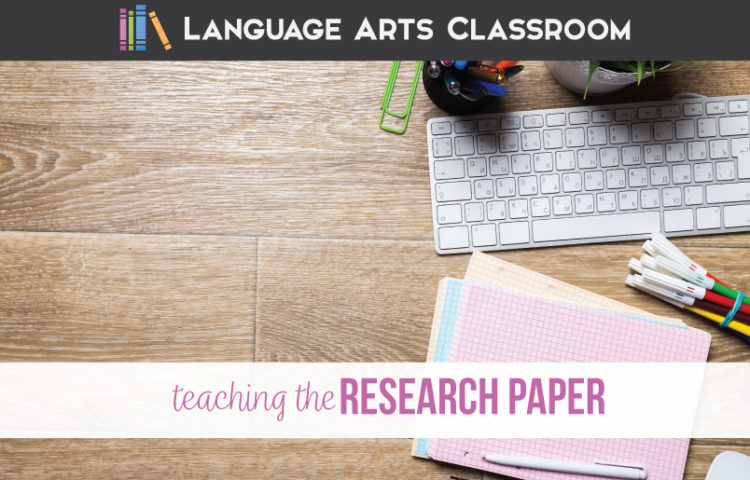
Teaching research papers with high school students? Teaching students how to write a research paper is an important part of an ELA class. Here are guidelines to make this writing unit a success.

Lawyers, political organizers, advertisers, real estate agents: most jobs require ethical research and then a written report. As a citizen, I research concepts important to my community and family. As knowledge in our world grows, student will only have more reasons to be ethical digital citizens.
Providing students with a sustainable foundation is a humbling responsibility. Teachers know that teaching students how to write a research paper is important. While teaching students how to research, I share those sentiments with them. I want students to know I take research seriously, and my expectation is that they will as well. My research paper lesson plans take into account the seriousness of ethical research.

What is the best way to teach research papers to students?
The best way to teach research papers to students is by breaking down the process into manageable steps. Start with teaching them how to choose a topic, conduct research, and create an outline/list/graphic organizer. Then guide them in writing drafts, revising and editing their papers, and properly citing sources.
Even after teaching for a decade, I sometimes overwhelm myself with this duty. I handle teaching research papers with four ideas in my mind.
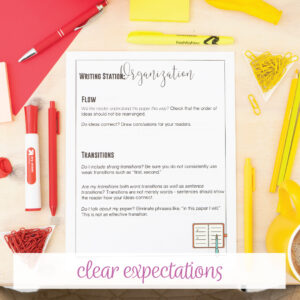
Provide clear expectations.
Idea one, be clear.
A feeling I always hated as a student was the unknown . Sure, part of the learning process is not knowing everything and making mistakes. I, as the teacher, don’t want to be the source of frustration though. I never want my classes to wander down a path that won’t advance them toward our end goal: a well-researched paper. Part of teaching research skills to high school students is providing clear expectations.
As writing in the ELA classroom becomes more digital, I simply give writers tools on our online learning platform. That way, I can remind them to check a certain section or page as we collaborate on their writing.

Give a writing overview.
Idea two, provide an overview.
Every teacher grades a little differently. Sometimes, terminology differs. Throw in the stress of research, and you might have a classroom of overwhelmed students. An overview before teaching research papers can relax everyone!
I start every writing unit with clear expectations, terminology, and goals. I cover a presentation with students, and then I upload it to Google Classroom. Students know to consult that presentation for clarity. Initially, covering the basics may seem wasteful, but it saves all of us time because students know my expectations.
Furthermore, parents and tutors appreciate my sharing that information. As students work independently (inside or outside of class), they can take it upon themselves to consult expectations. Their responsibility with this prepares them for their futures. Finally, having established that overview with students during virtual classes was invaluable.
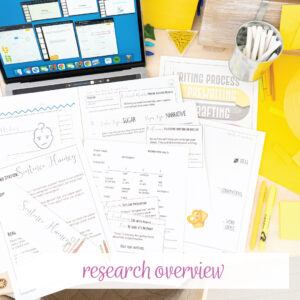
Show an overview of research.
Idea three, clearly explain research.
Before you begin teaching students how to research, outline what strong research looks like. You might consider these questions:
- What (if any) secondary sources will I accept? What about Wikipedia?
- Should students use a balance of books and online material? Do they have access to books?
- Are dates for certain topics important? Will I not accept research from before a certain date?
I’m not answering these questions for you, but I’ve seen teachers provide such guidelines while teaching research skills to high school students. Whatever parameters you have for teaching the research paper, share those with students.
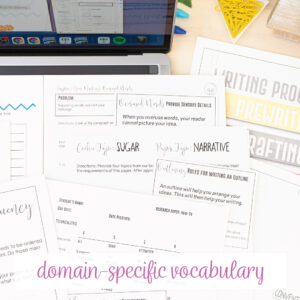
Define domain-specific vocabulary.
Idea four, don’t assume classes share the same domain-specific vocabulary.
High school classes are likely familiar with the writing process, yet the research process brings more vocabulary with which they might not be familiar.
Providing definitions for the most basic concepts enables me to walk through expectations and clarify concepts. Examples might include:
- Informational text
- Search engine
- Credible sources
- Claim, counterclaim
- Research question
- Journal articles
Plus, by providing definitions to terms, scaffolding occurs naturally. Academic writing has terms we teachers might use casually, but some students maybe have not heard of them.

How can we model ethical research?
After outlining expectations to young writers, we begin research. Some schools rely on Google Scholar, and others use Explora or EBSCO. Sign students into your databases, and run them through the program.
I stress to young writers that conducting oneself with honesty and integrity is crucial to writing. When teaching research papers with high school students, I connect these ethics to their very near futures. Aside from the basics of documenting and citing, I highlight these two points.
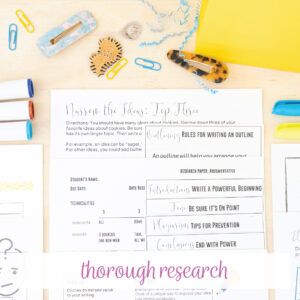
- Citing material. This includes direct quotes and paraphrasing. I review both of those concepts throughout our research and writing. The majority of a paper should be the writer’s thoughts, supported by research. Students need those concepts repeated, and they are important, so I spend time emphasizing them.
Often, I turn the basics of research into a writing mini lesson . Modeling ethical research is a very specific part of ELA classes. I understand that other classes require research and that parents might teach research skills as well.
Still, to have a functioning society, students must view relevant information with critical eyes. Teaching young citizens how to write a research paper includes clear guidelines for research and one-on-one conferencing.
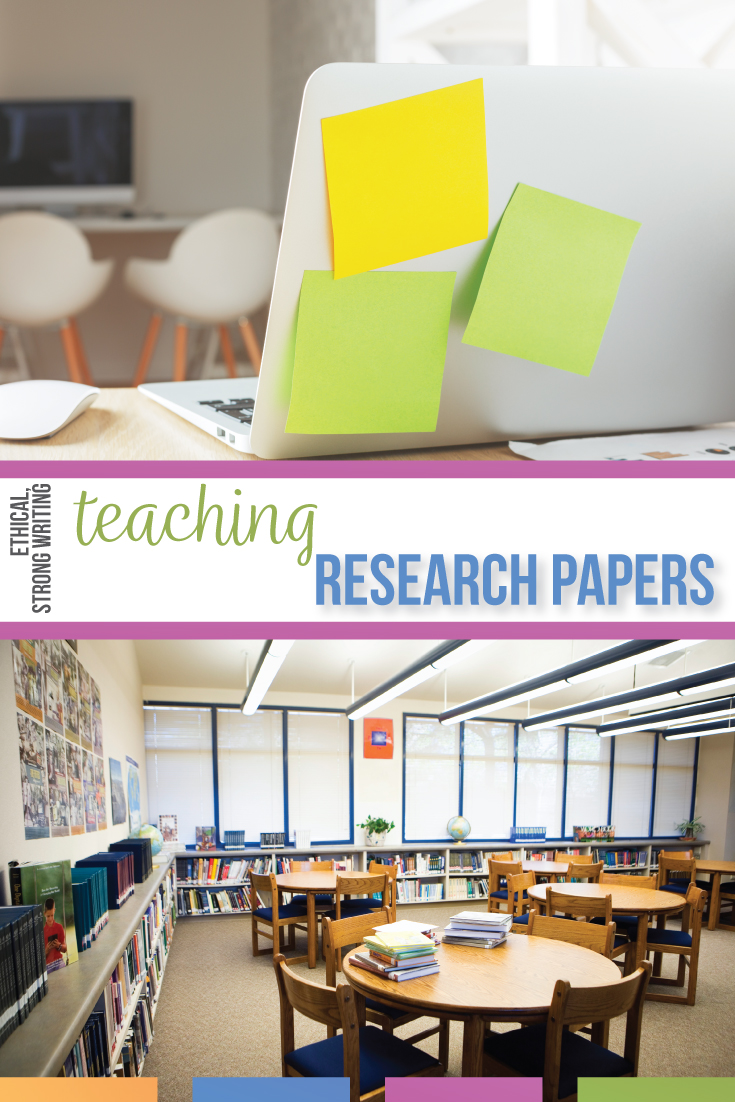
How can we encourage strong writing?
Hopefully, students write with passion. Hopefully, they want to show or prove their statements. Teaching students how to write a research paper is easier when students enjoy their topics.
I cover grammar with students (all year), and I always make the connection for them to implement those lessons. Teaching them to write a research paper requires some focus on writing skills. Primarily, they will work on strong verbs and syntax.

Look at verbs.
Students possess strong verbs in their vocabularies. Sometimes in writing, humans create a fast rough draft, myself included. Every verb is a linking verb, and every sentence reads subject + linking verb + predicate adjective. (Nothing is wrong with a linking verb, but writers should break from the mold.) When I see that a paper can be improved with strong verbs, we conference about ways to improve the verbs without thesaurus abuse.
Ask students to pick their least favorite paragraph in a research paper and to highlight every verb . Chances are, they are not conveying their message because of weak verbs. Help them turn the predicate adjectives into verbs or think of an action that will convey their meaning. Additionally as you continue teaching students how to research, you’ll cross strong verbs in research. Point out those verbs to your classes.
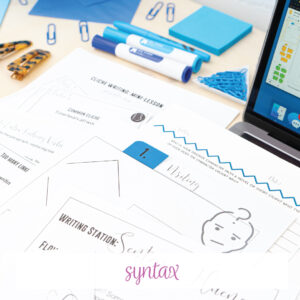
Examine syntax.
Just as every sentence shouldn’t contain a linking verb, not every sentence should be a simple sentence. Sentence syntax takes practice, and often teamwork! Ask students to provide a sentence that needs improvement. Break the sentence down into phrases and clauses. (If it is a simple sentence, ask for another sentence to attach.) What is the best arrangement? What is the student’s goal? Would a conjunctive adverb lead readers to a conclusion? What if a subordinating conjunction started the sentence, or, should the dependent clause come second in the complex sentence? Play with the language of papers! By connecting grammar to writing, you have empowered learners to improve their writing.
Sentence structure is also part of teaching students how to write a research paper because the information must be factual. Sometimes students report information incorrectly, and sometimes, their sentence structure is to blame. Focus on a return to simple syntax for ethical research, and then work on sentence diversity if possible.
All parts of an ELA classroom fit together like puzzle pieces, and when teaching research papers, that neatly assembled puzzle sits on display. By giving classes clear expectations, you are ready to guide them through ethical research and through strengthening their writing. Teaching the research paper is a large task, so you should know what you want to accomplish.

Is scaffolding teaching research papers possible?
Overall, a research unit takes me 2-3 weeks with high school students. Every teacher has different methodologies, but if I allow writing research papers for about a month, writers become bored. Fifteen working days for research, revision, and publishing is my average time frame. Going longer, and different aspects fall apart, and we lose momentum.
Scaffolding is built into our days. Outline the writing process with your calendar, and add days that follow the writing process. Pieces to consider:
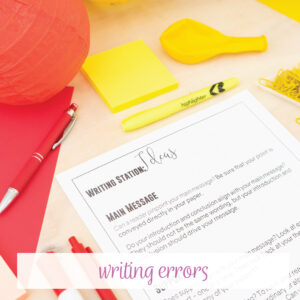
Scaffold writing errors.
Overall, writing errors are an inevitable part of the learning process. As teachers, it is crucial that we address these errors in a way that not only corrects them but also helps students understand why they occurred in the first place. When it comes to research papers, grammatical errors can significantly affect the credibility and clarity of the information presented.
One effective way to scaffold writing errors is by focusing on the actual problems that classes have in their papers. When we conference, I jot down common errors and then cover them as a class.
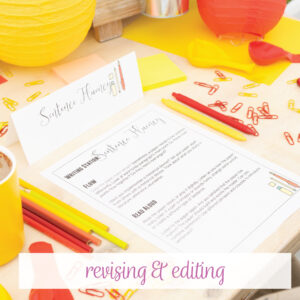
Include revising and editing days.
Young writers should take ownership of the writing process which includes revising and editing. This can be achieved by dedicating specific days in the research unit for revising and editing. By allotting time for these crucial steps, writers will learn to critically analyze their work and make necessary improvements.
During the revision phase, students can focus on the overall structure and organization of their research paper. They should evaluate if their arguments are clear and logical, if the evidence supports their claims effectively, and if there is a smooth flow of ideas throughout the paper. This stage allows them to refine their content and ensure that it aligns with their desired objectives.
After revising, students should move toward publishing and sharing with their peers.
Your turn, writing teachers: What questions do you have left?
All activities mentioned in this post (except the common errors bundle) are included in my writing bundle for freshmen and sophomores .
What questions remain? Do you have different advice to offer teachers?
What do you focus on with when teaching research papers? Read how Melissa from Reading and Writing Haven differentiates when teaching research writing .
Subscribe to our mailing list to receive updates about new blog posts, freebies, and teaching resources!
Marketing Permissions We will send you emails, but we will never sell your address.
You can change your mind at any time by clicking the unsubscribe link in the footer of any email you receive from us, or by contacting us at [email protected] . We will treat your information with respect. For more information about our privacy practices please visit our website. By clicking below, you agree that we may process your information in accordance with these terms.
We use Mailchimp as our marketing platform. By clicking below to subscribe, you acknowledge that your information will be transferred to Mailchimp for processing. Learn more about Mailchimp’s privacy practices here.
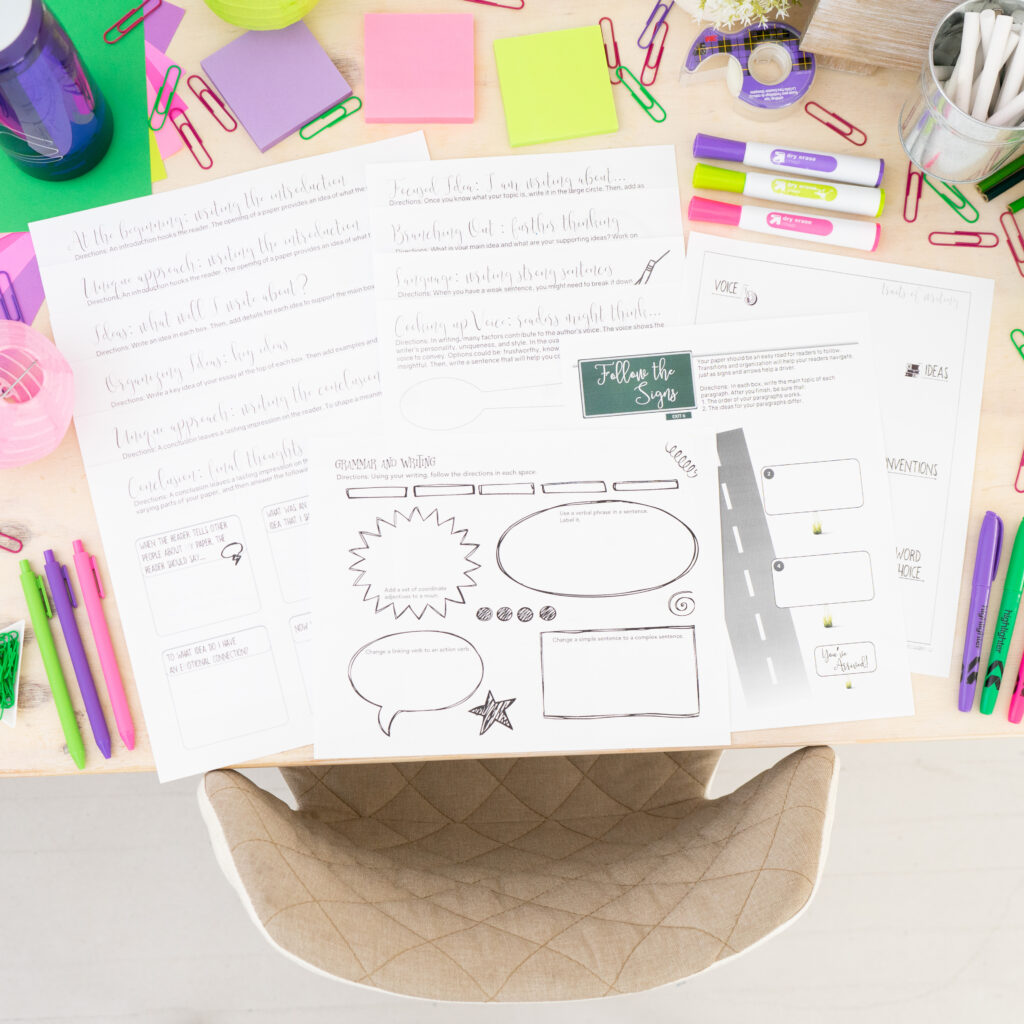
ethical research writing activities writing lessons writing process
Digital Learning Tools and Resources Guide
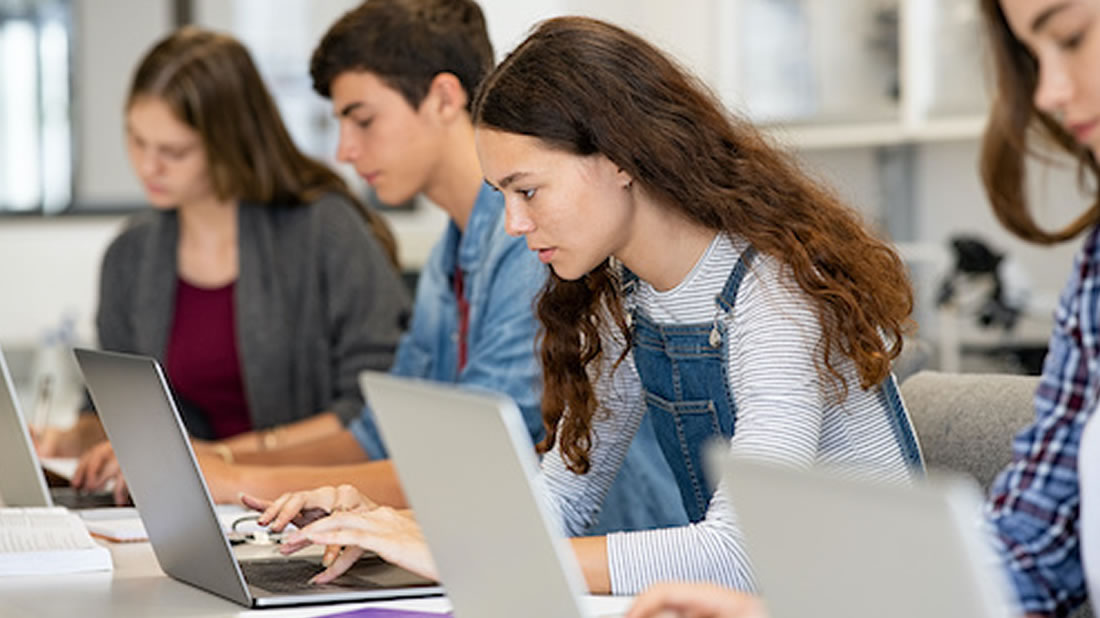
4 essential resources for building research skills in high school
Strong research skills are valuable beyond high school and will serve students well as they enter a world of digital resources and information.
Key points: Helping students develop strong research skills will create responsible digital citizens Critical evaluation of online resources and information is essential See related article: Students need freedom to develop critical skills with edtech Get the latest news about digital learning by going to eSN’s Digital Learning page
Right now is the perfect time to start a research project with your students, as it will help them develop skills they will use for the rest of their lives. While your students, who have grown up in the Information Age and think they already know everything, any classroom teacher knows that our students need help more than they think.
As a school librarian for the past 11 years, my primary focus has been on helping students become adept navigators of the sea of information they live in. By the time students reach me in high school, they are already juggling multiple social media accounts and unknowingly driving many business and political decisions through their media consumption.
Our students’ belief that everything they need to know is online can, without the right skillset, leave them prey to misinformation. So how do we teach our students to steer through the online ocean of data to be both effective researchers and responsible digital citizens?
Here are 4 must-have resources for teaching high school students how to research:
Digital encyclopedias like Britannica School or Credo Reference are still important, and vetted, sources of basic information. Each provides students with a credible resource and gives them helpful notation and citation tools. But don’t settle for just one. Take students on a tour of both databases and explore the differences. Britannica School is user-friendly and comprehensive, which makes it an ideal tool for building student confidence in their research skills. Even if your students are literal social media influencers, they may be apprehensive or overwhelmed navigating a database, and we do not want them to give up and turn to Google. They need to develop their research skills before they are ready to evaluate content from across the world wide web. The bold, colorful text features and differentiation of reading levels make Britannica School engaging and easy to use, and it is a trusted source of information.
Although both databases offer similar content, Credo Reference has a unique feature called Visual Exploration that you and your students will love. The database will retrieve your search results in the form of a mind map, which links your search term to related terms that are hyperlinked to vetted content. Articles related to the original search term appear alongside the mind map. Visual Exploration is an effective and interactive tool for teaching students about choosing search terms and narrowing their research topics. Credo Reference also has a series of short research tip videos for students on topics such as “what to do when your topic is too broad.”
Upper-level courses require students to navigate and analyze more complex sources than a standard encyclopedia entry, which can often be just a list of facts. Whether you are teaching U.S. Government or A.P. Language and Composition, your students are learning to evaluate persuasive writing and identify propaganda, because these are key information literacy skills. Gale In Context: Opposing Viewpoints not only provides students with curated sources and all the tools of an online encyclopedia but also introduces students to well-researched writing from various perspectives. A huge part of research is thinking critically about the credibility and intent of the source, and this database provides a safe space to analyze and examine issues from multiple angles. Gale In Context: Opposing Viewpoints is both visually appealing and has a unique feature for visual learners. The Topic Finder retrieves results as your choice of a tile or a wheel that displays terms at various sizes depending on the number of results for that term. For example, a Topic Finder search for “Artificial intelligence” displays “mental health” among the largest clusters of the tile or section of the wheel, which lets me know I can find significant content in the database related to A.I. and mental health. There is a curriculum search and an Educator Resources page with helpful tip sheets and worksheets, including one for students to create their own concept map.
Before you dive into an encyclopedia head first, you may want to go to Discovery Education Experience and gather some tools for teaching research effectively. You do not need to build a lesson from scratch. There’s a wealth of media within the platform to help you activate prior knowledge, develop assignments and create interactive lessons on any topic. The Discover Data channel, which is the result of a partnership between the Nielsen Foundation, Discovery Education, and the National Afterschool Association, has interactive, relevant lessons that you can adapt for your students. One of my favorites is the “Social Media and Misinformation” presentation. You can use it as an introduction to information literacy or assign the presentation as a self-paced lesson for students. In fact, you can use the Build an Activity feature with this or another presentation from Discovery Education to create an assignment and share it directly to Google Classroom, Microsoft Teams, Schoology or Canvas.
With these essentials in your toolbox, you will be able to equip your students with research skills that will help them unlock success in and out of the classroom.
Related : 4 tools to help students build post-COVID research skills
- Recent Posts
Ayanna Mayes is a school librarian at Chapin High School in School District Five of Lexington and Richland Counties. She served as the 2018 School Librarian of the Year for the South Carolina Association of School Librarians (SCASL).
- As invisible threats to education loom, cybersecurity is paramount - April 1, 2024
- Your district’s cyber safety needs help–here’s how to fix it - April 1, 2024
- How to keep hackers off your school attendance list with object storage - April 1, 2024
Eberly Center
Teaching excellence & educational innovation, explore potential strategies., students don’t know how to do research..
Students don’t have the prerequisite knowledge and skills, but think they do.
Research is a complex skill requiring diverse sub-skills. For example, some of those skills are very procedural (e.g., How to use a database), while others involve critical thinking (eg. Evaluating search results). Still others require strategic thinking (e.g., knowing what tools and procedures are appropriate/efficient for different research questions). Furthermore, in addition to developing proficiency in all of these areas and more, students must be able to integrate all of them. It is likely that students do not possess these skills because many of the research assignments in high school were easily answered by Wikipedia and the free web (e.g., Google). Because students were able to perform successfully in high school they my have false assumptions about their research abilities. In addition, we faculty may correlate technological competency with solid research skills when in reality, these skills must be taught and practiced.
Strategies:
Conduct a pre-assessment of your students’ research skills., teach research skills., clearly articulate your expectations., articulate assignment requirements in detail., partner with the library., model your research process in your own teaching..
Once you have decided what particular research skills are important in your course, you can design a questionnaire asking students to self-assess in those areas. Students typically might have difficulty in accurately assessing their own skills, but each academic department has a liaison librarian , who is available to assist you in designing the pre-assessment. The Eberly Center can also help you in this task.
If students lack the research skills they will need to meet your course objectives, then you must teach them in tandem with your course content. As with any other skills, you should address the relevant sub skills in class and give students opportunities to practice and provide them with feedback.
Discuss with students the level at which you expect them to perform and how it differs from high school. For example, you might say, “Rather than simply regurgitating a ‘report’, I expect you to a) generate a research question, b) search for and retrieve appropriate sources according to the following criteria, c) analyze and evaluate those sources, d) synthesize them into a position.”
You can never be too explicit. Instructors tend to err on the side of vagueness, even when they think they are being very clear. For instance, if you are requiring 5 papers for a literature review, students may default to a simple Google search unless told otherwise. Some instructors further detail their assignments, specifying that papers need to be peer-reviewed, or that they need to come from a menu of approved scholarly journals. Other instructors have policies in their syllabi which forbid students from citing Wikipedia as a source on certain kinds of research projects. Depending on your course objectives, these or other policies might be appropriate.
Each academic department has a liaison librarian, who is a subject specialist able to provide subject-oriented research skills instruction for small groups and classes. Services vary from in-class to in-the-library instruction, and are customizable according to your needs (e.g., from explaining the collection or the available databases to creating research guides for your class and helping students to evaluate sources). Liaison librarians are also available to help you specify research learning objectives for your course. For a list of liaison librarians visit http://www.library.cmu.edu/Services/sliaisons.html .
Demonstrate for your students the process you engage in when doing research. For instance, you can take your students through a sample literature search. Talk yourselves through how you conceptualize a topic, narrow it down to be manageable, identify relevant data bases, perform searches, analyze search results for relevance, decide which ones to investigate deeper, refine or expand the search once you identify a few good hits, iterate the process, and finally assess that your information needs have been met. This will show students all the various skills involved as well as highlight the reasoning behind the process.
This site supplements our 1-on-1 teaching consultations. CONTACT US to talk with an Eberly colleague in person!

ChatGPT for Teachers
Trauma-informed practices in schools, teacher well-being, cultivating diversity, equity, & inclusion, integrating technology in the classroom, social-emotional development, covid-19 resources, invest in resilience: summer toolkit, civics & resilience, all toolkits, degree programs, trauma-informed professional development, teacher licensure & certification, how to become - career information, classroom management, instructional design, lifestyle & self-care, online higher ed teaching, current events, how to help middle school students develop research skills.

As the research skills you teach middle school students can last them all their lives, it’s essential to help them develop good habits early in their school careers.
Research skills are useful in nearly every subject, whether it’s English, math, social studies or science, and they will continue to pay off for students every day of their schooling. Understanding the most important research skills that middle school students need will help reach these kids and make a long-term difference.
The research process
It is important for every student to understand that research is actually a process rather than something that happens naturally. The best researchers develop a process that allows them to fully comprehend the ideas they are researching and also turn the data into information that is usable for whatever the end purpose may be. Here is an example of a research process that you may consider using when teaching research skills in your middle school classroom:
- Form a question : Research should be targeted; develop a question you want to answer before progressing any further.
- Decide on resources : Not every resource is good for every question/problem. Identify the resources that will work best for you.
- Gather raw data : First, gather information in its rawest form; do not attempt to make sense of it at this point.
- Sort the data : After you have the information in front of you, decide what is important to you and how you will use it. Not all data will be reliable or worthwhile.
- Process information : Turn the data into usable information. This processing step may take longer than the rest combined. This is where you really see your data shape into something exciting.
- Create a final piece : This is where you would write a research paper, create a project or build a graph or other visual piece with your information. This may or may not be a formal document.
- Evaluate : Look back on the process. Where did you experience success and failure? Did you find an answer to your question?
This process can be adjusted to suit the needs of your particular classroom or the project you are working on. Just remember that the goal is not only to find the data for this particular project, but to teach your students research skills that will help them in the long run.
Research is a very important part of the learning process as well as being useful in real-life once the student graduates. Middle school is a great time to develop these skills as many high school teachers expect that students already have this knowledge.
Students who are well-prepared as researchers will be able to handle nearly any assignment that comes their way. Finding new ways to teach research skills to middle school students need will be a challenge, but the results are well worth it as you see your students succeed in your classroom and set the stage for further success throughout their schooling experience.
You may also like to read
- Web Research Skills: Teaching Your Students the Fundamentals
- Building Math Skills in High School Students
- How to Help High School Students with Career Research
- Five Free Websites for Students to Build Research Skills
- Homework in Middle School: Building a Foundation for Study Skills
- 5 Novels for Middle School Students that Celebrate Diversity
Categorized as: Tips for Teachers and Classroom Resources
Tagged as: Engaging Activities , Middle School (Grades: 6-8)
- Math Teaching Resources | Classroom Activitie...
- Online & Campus Doctorate (EdD) in Organizati...
- Master's in Reading and Literacy Education
- Our Mission
Getting First Graders Started With Research
Teaching academically honest research skills helps first graders learn how to collect, organize, and interpret information.

Earlier in my career, I was told two facts that I thought to be false: First graders can’t do research, because they aren’t old enough; and if facts are needed for a nonfiction text, the students can just make them up. Teachers I knew went along with this misinformation, as it seemed to make teaching and learning easier. I always felt differently, and now—having returned to teaching first grade 14 years after beginning my career with that age group—I wanted to prove that first graders can and should learn how to research.
A lot has changed over the years. Not only has the science of reading given teachers a much better understanding of how to teach reading skills , but we now exist in a culture abundant in information and misinformation. It’s imperative that we teach academically honest research skills to students as early as possible.
Use a Familiar Resource, and Pair it with a Planned Unit
How soon do you start research in first grade? Certainly not at the start of the year with the summer lapse in skills and knowledge and when new students aren’t yet able to read. By December of this school year, skills had either been recovered or established sufficiently that I thought we could launch into research. This also purposely coincided with a unit of writing on nonfiction—the perfect pairing.
The research needed an age-related focus to make it manageable, so I chose animals. I thought about taking an even safer route and have one whole class topic that we researched together, so that students could compare notes and skills. I referred back to my days working in inquiry-based curriculums (like the International Baccalaureate Primary Years Program) and had students choose which animal to study. Our school librarian recommended that we use Epic because the service has an abundance of excellent nonfiction animal texts of different levels.
Teach the Basics for Organized Research
I began with a conversation about academic honesty and why we don’t just copy information from books. We can’t say this is our knowledge if we do this; it belongs to the author. Instead, we read and learn. Then, we state what we learned in our own words. Once this concept is understood, I model how to do this by creating a basic step-by-step flowchart taught to me by my wife—a longtime first-grade and kindergarten teacher and firm believer in research skills.
- Read one sentence at a time.
- Turn the book over or the iPad around.
- Think about what you have learned. Can you remember the fact? Is the fact useful? Is it even a fact?
- If the answer is no, reread the sentence or move onto the next one.
- If the answer is yes, write the fact in your own words. Don’t worry about spelling. There are new, complex vocabulary words, so use your sounding-out/stretching-out strategies just like you would any other word. Write a whole sentence on a sticky note.
- Place the sticky note in your graphic organizer. Think about which section it goes in. If you aren’t sure, place it in the “other facts” section.
The key to collecting notes is the challenging skill of categorizing them. I created a graphic organizer that reflected the length and sections of the exemplar nonfiction text from our assessment materials for the writing unit. This meant it had five pages: an introduction, “what” the animal looks like, “where” the animal lives, “how” the animal behaved, and a last page for “other facts” that could become a general conclusion.
Our district’s literacy expert advised me not to hand out my premade graphic organizer too soon in this process because writing notes and categorizing are two different skills. This was my intention, but I forgot the good advice and handed out the organizer right away. This meant dedicating time for examining and organizing notes in each combined writing and reading lesson. A lot of one-on-one feedback was needed for some students, while others flourished and could do this work independently. The result was that the research had a built-in extension for those students who were already confident readers.
Focus on What Students Need to Practice
Research is an essential academic skill but one that needs to be tackled gradually. I insisted that my students use whole sentences rather than words or phrases because they’re at the stage of understanding what a complete sentence is and need regular practice. In this work, there’s no mention of citation language and vetting sources; in the past, I’ve introduced those concepts to students in fourth grade and used them regularly with my fifth-grade students. Finding texts that span the reading skill range of a first-grade class is a big enough task.
For some of the key shared scientific vocabulary around science concepts, such as animal groups (mammals, etc.) or eating habits (carnivore, etc.), I created class word lists, having first sounded out the words with the class and then asked students to attempt spelling them in their writing.
The Power of Research Can Facilitate Student Growth
I was delighted with the results of the research project. In one and a half weeks, every student had a graphic organizer with relevant notes, and many students had numerous notes. With my fourth- and fifth-grade students, I noticed that one of the biggest difficulties for them was taking notes and writing them in a way that showed a logical sequence. Therefore, we concluded our research by numbering the notes in each section to create a sequential order.
This activity took three lessons and also worked for my first graders. These organized notes created an internal structure that made the next step in the writing process, creating a first draft of their nonfiction teaching books, so much easier.
The overall result was that first graders were able to truly grasp the power of research and gathering accurate facts. I proved that young children can do this, especially when they work with topics that already fascinate them. Their love of learning motivated them to read higher-level and more sophisticated texts than they or I would normally pick, further proving how interest motivates readers to embrace complexity.
- A winning model: Bogotá’s charter schools boost students’ academic and social-emotional skills
Media Inquiries
- 615-322-6397 Email
Latest Stories
- Jessica Logan: a meta-scientist on a mission
- Update your personal devices to the secure VUIT Wi-Fi network
Apr 5, 2024, 2:04 PM
By Jenna Somers
Researchers at Vanderbilt University and William & Mary may have found a promising approach to education reform that could help provide high-quality education to students from low-income families. Results from a study on the quality of public-private partnership schools in Bogotá, Colombia—known as schools in administration—demonstrate that students enrolled in these schools have higher scores in cognitive and social-emotional skills than students of similar socio-economic and demographic backgrounds who did not enroll in these schools. Parents and guardians also reported higher satisfaction with the schools in administration and a lower likelihood of transferring to another school.
Much like charter schools in the United States, schools in administration are privately managed but publicly funded. Colombia seeks to leverage both sectors to more efficiently use public resources to provide a better-quality education to students from low-income backgrounds. To ensure the quality of these schools, the government holds them to the same accountability standards as public schools. Furthermore, non-profit organizations selected by the government to manage these schools must demonstrate prior experience managing high-quality private schools.

“The benefits in cognitive and social-emotional outcomes for students at these schools could potentially shift the approach to public education in Colombia. Based on the positive results for students and the satisfaction of parents, these schools not only deliver a quality education, but they promote community confidence,” said Felipe Barrera-Osorio , the study’s principal investigator and associate professor of public policy, education, and economics at Vanderbilt Peabody College of education and human development .
Students’ cognitive skills—those related to thinking, learning, and problem-solving—were measured by the Peabody Picture Vocabulary Test . Those with superior scores on the test demonstrated better social understanding, emotional health, and well-being. Parents of students in schools in administration seemed to notice the enhanced quality, as only 10 percent of them indicated a desire to change schools, compared to 37 percent of parents whose children were not enrolled in these schools.
Barrera-Osorio and co-PI Andrew Dustan , assistant professor of economics at William & Mary, note several key benefits of schools in administration that may support positive outcomes for students. These schools employ more full-time psychologists and provide more professional development training to teachers compared to traditional public schools. In particular, teacher trainings focus on classroom management and content, whereas teacher trainings in public schools focus more on coexistence in school and managing socio-emotional characteristics of students. That said, the researchers found that schools in administration and public schools collaborate through teacher networks to improve teaching practices.
While the findings from the study offer much promise for the future of providing cost-effective, quality education to students from low-income families in Colombia, the researchers say it is vital to further study the performance, benefits, and characteristics of schools in administration.
Importantly, this is the first study to compare students who applied to schools in administration and were assigned a spot with students who also applied and did not receive a spot. The Colombian government created a priority index of students based on socio-economic status and demographic background. The researchers formed pairs of students who each had the same score on the priority index. Through a lottery system, one student received a spot in a school in administration and the other student did not. Key to the validity of the findings is that the students’ profiles were identical, except whether they attended a school in administration.
This study was conducted in collaboration with Innovations for Poverty Action Colombia and the Bogotá Secretary of Education. It was supported by a one-year, $400,000 grant from the National Science Foundation.
Keep Reading

Peabody Scholars share guidance to inform school voucher policy
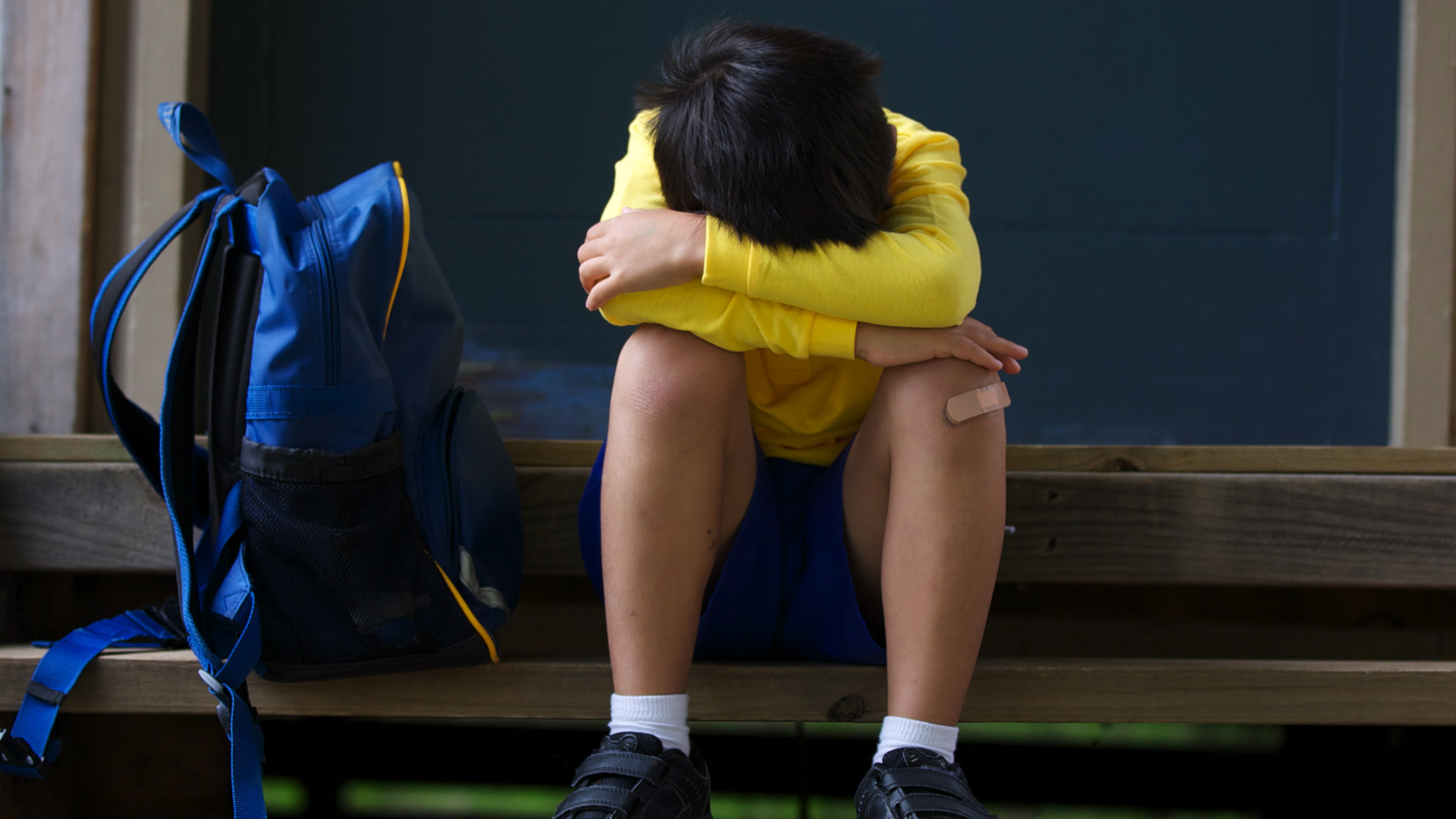
Education, bullying, mental health, school gun violence top list of parental concerns for their children: poll

Welsh’s study reveals the importance of parental trust in schools for reducing exclusionary discipline
Explore story topics.
- Education and Psychology
- Felipe Barrera-Osorio
- Ideas In Action
- Peabody College
- Peabody global engagement
- peabody-home
Read our research on: Gun Policy | International Conflict | Election 2024
Regions & Countries
What’s it like to be a teacher in america today, public k-12 teachers are stressed about their jobs and few are optimistic about the future of education; many say poverty, absenteeism and mental health are major problems at their school.
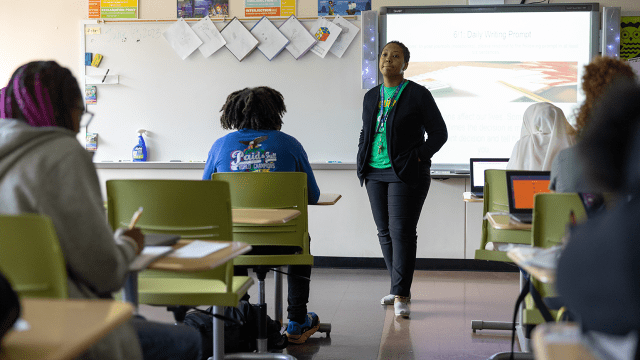
Pew Research Center conducted this study to better understand the views and experiences of public K-12 school teachers. The analysis in this report is based on an online survey of 2,531 U.S. public K-12 teachers conducted from Oct. 17 to Nov. 14, 2023. The teachers surveyed are members of RAND’s American Teacher Panel, a nationally representative panel of public K-12 school teachers recruited through MDR Education. Survey data is weighted to state and national teacher characteristics to account for differences in sampling and response to ensure they are representative of the target population.
Here are the questions used for this report , along with responses, and the survey methodology .
Low-poverty , medium-poverty and high-poverty schools are based on the percentage of students eligible for free and reduced-price lunch, as reported by the National Center for Education Statistics (less than 40%, 40%-59% and 60% or more, respectively).
Secondary schools include both middle schools and high schools.
All references to party affiliation include those who lean toward that party. Republicans include those who identify as Republicans and those who say they lean toward the Republican Party. Democrats include those who identify as Democrats and those who say they lean toward the Democratic Party.
Public K-12 schools in the United States face a host of challenges these days – from teacher shortages to the lingering effects of COVID-19 learning loss to political battles over curriculum .
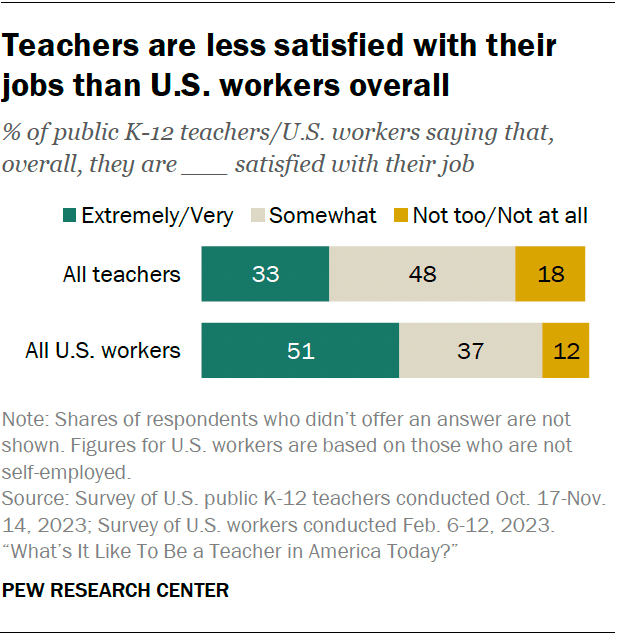
In the midst of all this, teachers express low levels of satisfaction with their jobs. In fact, they’re much less satisfied than U.S. workers overall.
Here’s how public K-12 teachers are feeling about their jobs:
- 77% say their job is frequently stressful.
- 68% say it’s overwhelming.
- 70% say their school is understaffed.
- 52% say they would not advise a young person starting out today to become a teacher.
When it comes to how their students are doing in school, teachers are relatively downbeat about both academic performance and behavior.
Here’s how public K-12 teachers rate academic performance and behavior at their school:
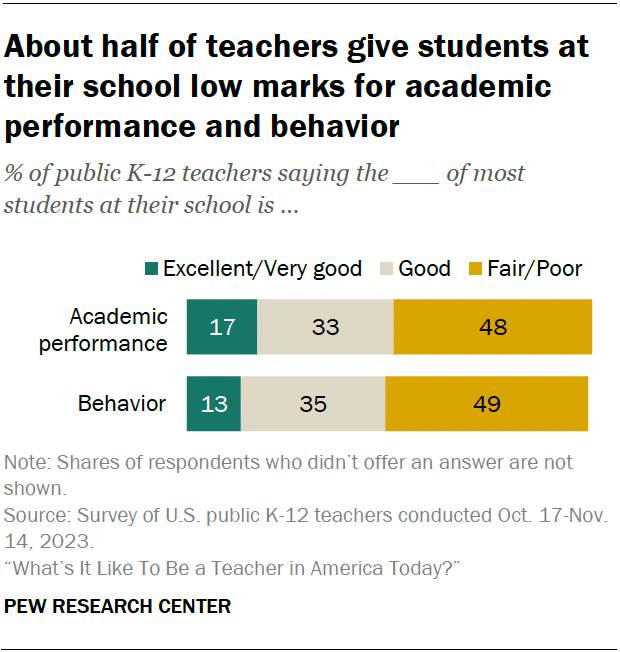
- 48% say the academic performance of most students at their school is fair or poor. A third say it’s good, and only 17% describe it as excellent or very good.
- 49% say the behavior of most students at their school is fair or poor; 35% say it’s good and 13% say it’s excellent or very good.
The COVID-19 pandemic likely compounded these issues. About eight-in-ten teachers (among those who have been teaching for at least a year) say the lasting impact of the pandemic on students’ behavior, academic performance and emotional well-being has been very or somewhat negative.
Assessments of student performance and behavior differ widely by school poverty level. 1 Teachers in high-poverty schools have a much more negative outlook. But feelings of stress and dissatisfaction among teachers are fairly universal, regardless of where they teach.
Related: What Public K-12 Teachers Want Americans To Know About Teaching
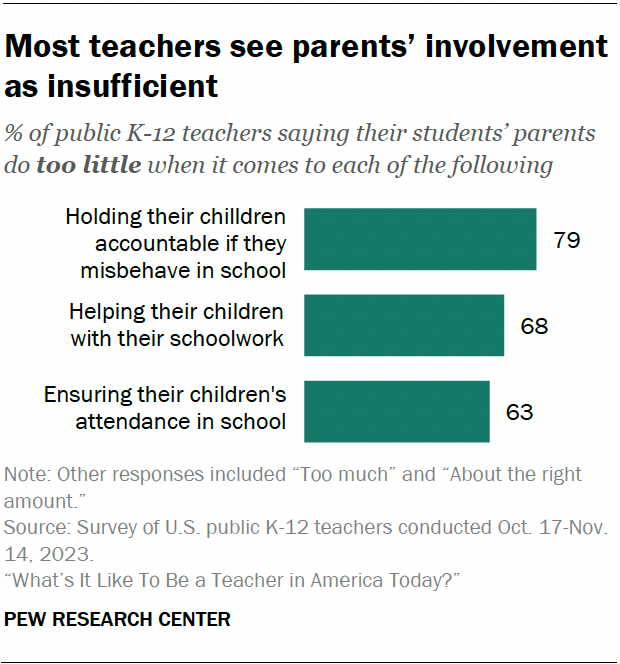
As they navigate these challenges, teachers don’t feel they’re getting the support or reinforcement they need from parents.
Majorities of teachers say parents are doing too little when it comes to holding their children accountable if they misbehave in school, helping them with their schoolwork and ensuring their attendance.
Teachers in high- and medium-poverty schools are more likely than those in low-poverty schools to say parents are doing too little in each of these areas.
These findings are based on a survey of 2,531 U.S. public K-12 teachers conducted Oct. 17-Nov. 14, 2023, using the RAND American Teacher Panel. 2 The survey looks at the following aspects of teachers’ experiences:
- Teachers’ job satisfaction (Chapter 1)
- How teachers manage their workload (Chapter 2)
- Problems students are facing at public K-12 schools (Chapter 3)
- Challenges in the classroom (Chapter 4)
- Teachers’ views of parent involvement (Chapter 5)
- Teachers’ views on the state of public K-12 education (Chapter 6)
Problems students are facing
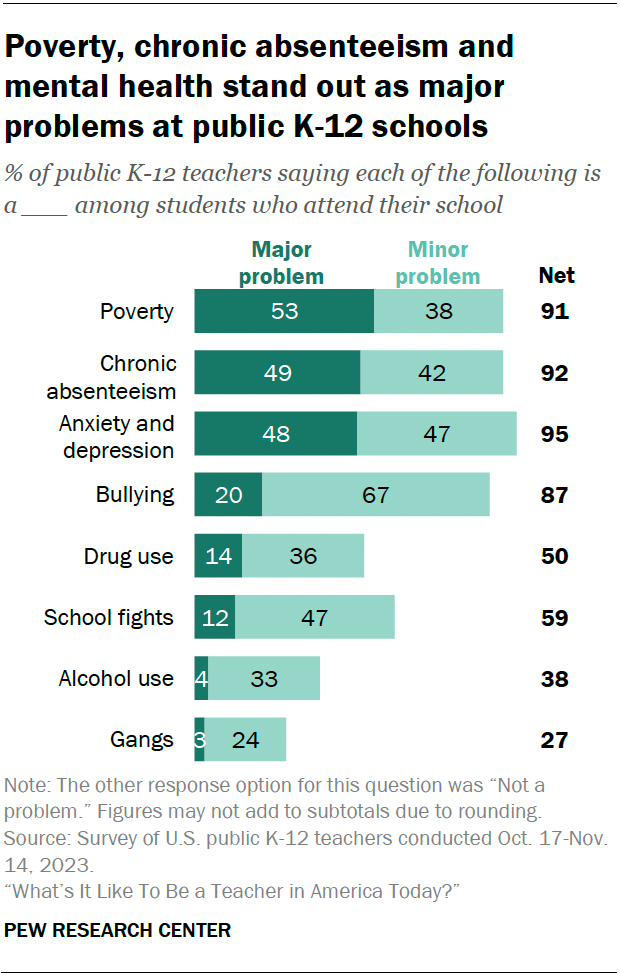
We asked teachers about some of the challenges students at their school are facing. Three problems topped the list:
- Poverty (53% say this is a major problem among students who attend their school)
- Chronic absenteeism (49%)
- Anxiety and depression (48%)
Chronic absenteeism (that is, students missing a substantial number of school days) is a particular challenge at high schools, with 61% of high school teachers saying this is a major problem where they teach. By comparison, 46% of middle school teachers and 43% of elementary school teachers say the same.
Anxiety and depression are viewed as a more serious problem at the secondary school level: 69% of high school teachers and 57% of middle school teachers say this is a major problem among their students, compared with 29% of elementary school teachers.
Fewer teachers (20%) view bullying as a major problem at their school, though the share is significantly higher among middle school teachers (34%).
A look inside the classroom
We also asked teachers how things are going in their classroom and specifically about some of the issues that may get in the way of teaching.
- 47% of teachers say students showing little or no interest in learning is a major problem in their classroom. The share rises to 58% among high school teachers.
- 33% say students being distracted by their cellphones is a major problem. This is particularly an issue for high school teachers, with 72% saying this is a major problem.
- About one-in-five teachers say students getting up and walking around when they’re not supposed to and being disrespectful toward them (21% each) are major problems. Teachers in elementary and middle schools are more likely than those in high schools to see these as challenges.
A majority of teachers (68%) say they’ve experienced verbal abuse from a student – such as being yelled at or threatened. Some 21% say this happens at least a few times a month.
Physical violence is less common. Even so, 40% of teachers say a student has been violent toward them , with 9% saying this happens at least a few times a month.
About two-thirds of teachers (66%) say that the current discipline practices at their school are very or somewhat mild. Only 2% say the discipline practices at their school are very or somewhat harsh, while 31% say they are neither harsh nor mild. Most teachers (67%) say teachers themselves don’t have enough influence in determining discipline practices at their school.
Behavioral issues and mental health challenges
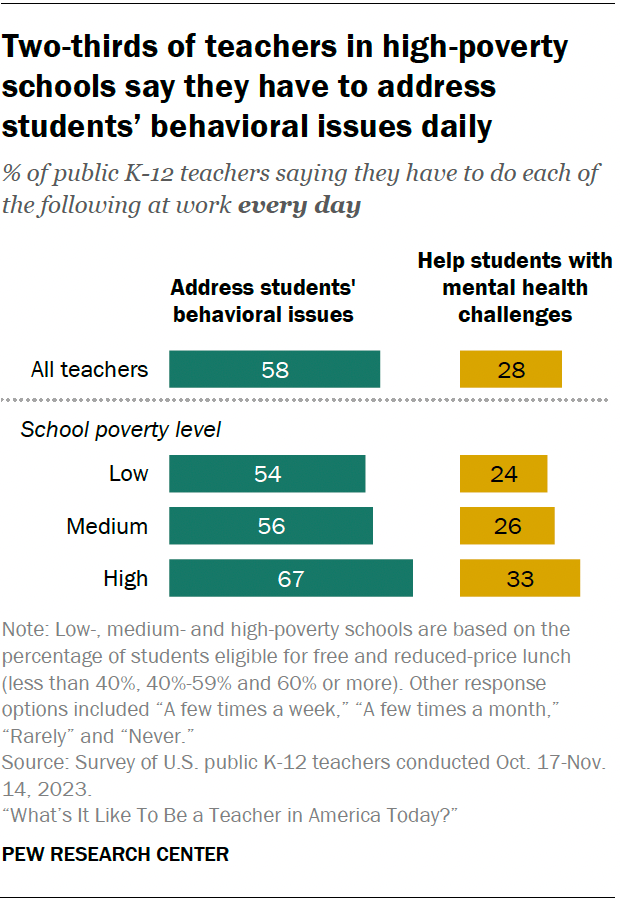
In addition to their teaching duties, a majority of teachers (58%) say they have to address behavioral issues in their classroom every day. About three-in-ten teachers (28%) say they have to help students with mental health challenges daily.
In each of these areas, elementary and middle school teachers are more likely than those at the high school level to say they do these things on a daily basis.
And teachers in high-poverty schools are more likely than those in medium- and low-poverty schools to say they deal with these issues each day.
Cellphone policies and enforcement
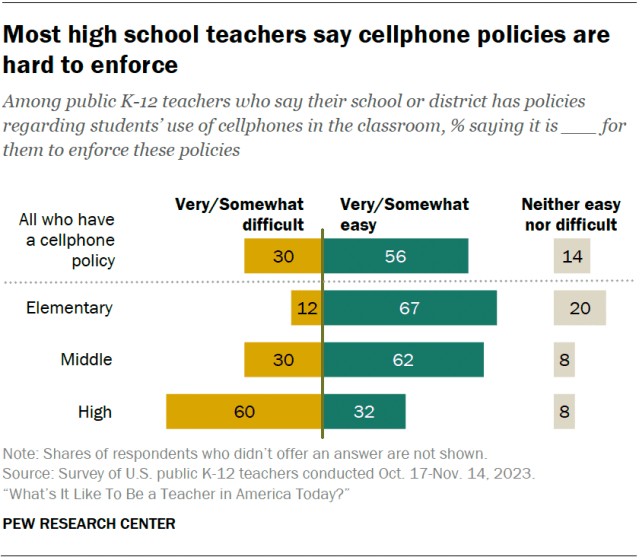
Most teachers (82%) say their school or district has policies regarding cellphone use in the classroom.
Of those, 56% say these policies are at least somewhat easy to enforce, 30% say they’re difficult to enforce, and 14% say they’re neither easy nor difficult to enforce.
Experiences with cellphone policies vary widely across school levels. High school teachers (60%) are much more likely than middle school (30%) and elementary school teachers (12%) to say the policies are difficult to enforce (among those who say their school or district has a cellphone policy).
How teachers are experiencing their jobs
Thinking about the various aspects of their jobs, teachers are most satisfied with their relationship with other teachers at their school (71% are extremely or very satisfied).
They’re least satisfied with how much they’re paid – only 15% are extremely or very satisfied with their pay, while 51% are not too or not at all satisfied.
Among teachers who don’t plan to retire or stop working this year, 29% say it’s at least somewhat likely they will look for a new job in the 2023-24 school year. Within that group, 40% say they would look for a job outside of education, 29% say they’d seek a non-teaching job in education, and only 18% say they’d look for a teaching job at another public K-12 school.
Do teachers find their work fulfilling and enjoyable?
Overall, 56% of teachers say they find their job to be fulfilling extremely often or often; 53% say their job is enjoyable. These are significantly lower than the shares who say their job is frequently stressful (77%) or overwhelming (68%).
Positive experiences are more common among newer teachers. Two-thirds of those who’ve been teaching less than six years say their work is fulfilling extremely often or often, and 62% of this group says their work is frequently enjoyable.
Teachers with longer tenures are somewhat less likely to feel this way. For example, 48% of those who’ve been teaching for six to 10 years say their work is frequently enjoyable.
Balancing the workload
Most teachers (84%) say there’s not enough time during their regular work hours to do tasks like grading, lesson planning, paperwork and answering work emails.
Among those who feel this way, 81% say simply having too much work is a major reason.
Many also point to having to spend time helping students outside the classroom, performing non-teaching duties like lunch duty, and covering other teachers’ classrooms as at least minor reasons they don’t have enough time to get all their work done.
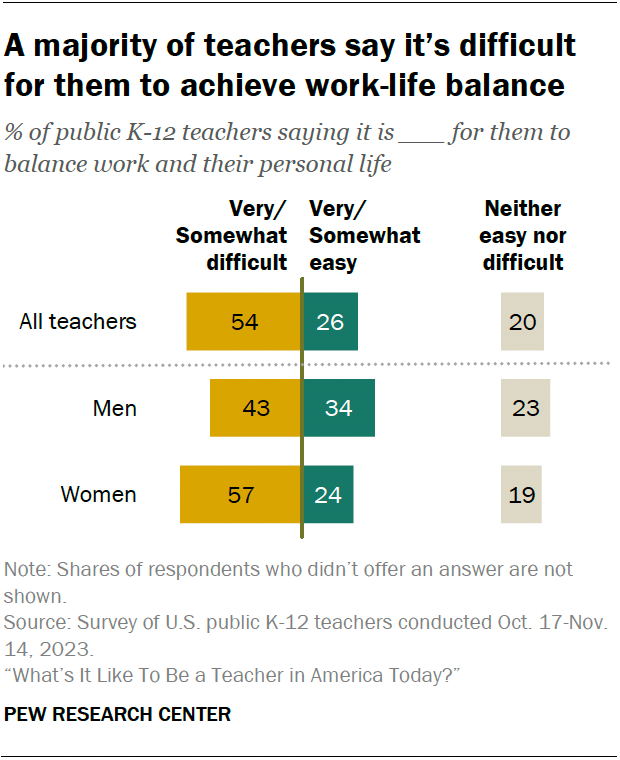
A majority of teachers (54%) say it’s very or somewhat difficult for them to balance work and their personal life. About one-in-four (26%) say it’s very or somewhat easy for them to balance these things, and 20% say it’s neither easy nor difficult.
Among teachers, women are more likely than men to say work-life balance is difficult for them (57% vs. 43%). Women teachers are also more likely to say they often find their job stressful or overwhelming.
How teachers view the education system
A large majority of teachers (82%) say the overall state of public K-12 education has gotten worse in the past five years.
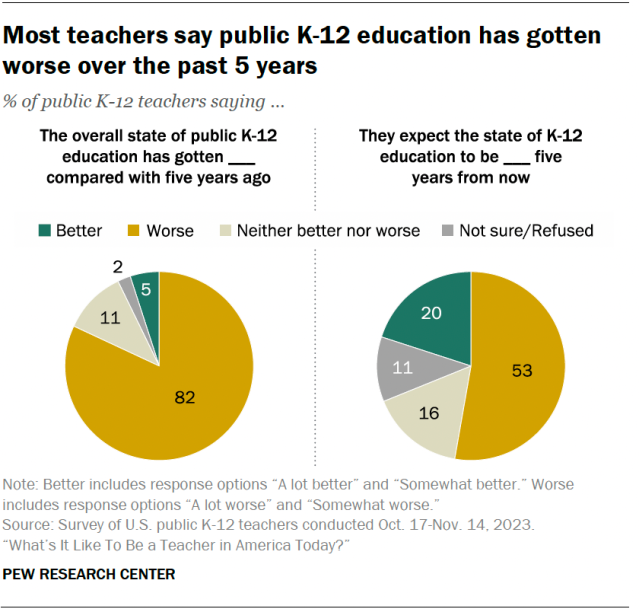
And very few are optimistic about the next five years: Only 20% of teachers say public K-12 education will be a lot or somewhat better five years from now. A narrow majority (53%) say it will be worse.
Among teachers who think things have gotten worse in recent years, majorities say the current political climate (60%) and the lasting effects of the COVID-19 pandemic (57%) are major reasons. A sizable share (46%) also point to changes in the availability of funding and resources.
Related: About half of Americans say public K-12 education is going in the wrong direction
Which political party do teachers trust more to deal with educational challenges?
On balance, more teachers say they trust the Democratic Party than say they trust the Republican Party to do a better job handling key issues facing the K-12 education system. But three-in-ten or more across the following issues say they don’t trust either party:
- Shaping school curriculum (42% say they trust neither party)
- Ensuring teachers have adequate pay and benefits (35%)
- Making schools safer (35%)
- Ensuring adequate funding for schools (33%)
- Ensuring all students have equal access to high-quality K-12 education (31%)
A majority of public K-12 teachers (58%) identify or lean toward the Democratic Party. This is higher than the share among the general public (47%).
- Poverty levels are based on the percentage of students in the school who are eligible for free and reduced-price lunch. ↩
- For details, refer to the Methodology section of the report. ↩
- Urban, suburban and rural schools are based on the location of the school as reported by the National Center for Education Statistics (rural includes town). Definitions match those used by the U.S. Census Bureau. ↩
Social Trends Monthly Newsletter
Sign up to to receive a monthly digest of the Center's latest research on the attitudes and behaviors of Americans in key realms of daily life
Report Materials
Table of contents, ‘back to school’ means anytime from late july to after labor day, depending on where in the u.s. you live, among many u.s. children, reading for fun has become less common, federal data shows, most european students learn english in school, for u.s. teens today, summer means more schooling and less leisure time than in the past, about one-in-six u.s. teachers work second jobs – and not just in the summer, most popular.
About Pew Research Center Pew Research Center is a nonpartisan fact tank that informs the public about the issues, attitudes and trends shaping the world. It conducts public opinion polling, demographic research, media content analysis and other empirical social science research. Pew Research Center does not take policy positions. It is a subsidiary of The Pew Charitable Trusts .
High school students compete in 2024 SWCC Welding Skills Challenge
Published April 5, 2024 10:38 am

High school students were on Southwestern Community College's Creston campus on Thursday, April 4, from 9 a.m.-2 p.m., competing in the 2024 Welding Skills Challenge.
During their time at Southwestern, students competed individually and as teams, networked with industry professionals, and learned about career opportunities in the welding field. During competition, the students rotated through three welding stations, including oxy-acetylene, SMAW/stick, and GMAW/MIG. Local welding experts served as the judges for the hands-on competition.
Contest winners included the following:
- Team Winner - Clarke High School
- Top Individuals - First Place, Ryder Collins, Clarke High School; Second Place – Ethan Davids, Red Oak High School; and Third Place – Baz Clear, Red Oak High School
A big thank you to the event sponsors: Airgas, Altec, and H&H Trailers.
Southwestern’s welding program offers a one-year diploma program, as well as a two-year Associate of Applied Science degree in welding. Luke Nelson is the lead instructor for the college’s welding program.
PHOTO ABOVE: First Place, Team - Clarke High School. Pictured L to R: Remington Binning; Cole Binning; Mike Spalding, industrial technology teacher; Ryder Collins; and Lukas Short.
PHOTO BELOW: Top Individuals - First Place, Ryder Collins, Clarke High School; Second Place, Ethan Davids, Red Oak High School; and Third Place, Baz Clear, Red Oak High School.

Quick Links
- Areas of Study
- Net Partner
- Transcript Request
- Safety Data Sheets
- Student Survey Fall 2023
- SWCC Shoppe
Information for...
- Future Students
- Current Students
- Parents & Counselors
- Alumni & Community
- Faculty & Staff
- Open access
- Published: 05 April 2024
Unveilling the hidden skillset: exploring non-technical skills in surgical education across spanish medical universities
- Oves-Suarez B 1 ,
- García-Marín JA 2 ,
- Aguayo-Albasini JL 2 &
- Soria-Aledo V 3
BMC Medical Education volume 24 , Article number: 376 ( 2024 ) Cite this article
1 Altmetric
Metrics details
Non-Technical Skills (NTS) are cognitive, social, and personal resource skills that are crucial in complex and high-risk environments. The aims of our research are to determine the prevalence and content of NTS in the surgical rotation teaching guides of the Medicine Degree programs in Spanish Universities, to identify the most prevalent types and subtypes of NTS, and to analyze factors associated with the prevalence of surgical NTS in Medical Schools in Spain.
Descriptive observational cross-sectional study involving the identification and collection of competencies outlined in the surgical rotation teaching guides of Spanish Medical Schools. Information regarding university performance was obtained from the Foundation for Knowledge and Development Ranking webpage. The “Non-Technical Skills for Surgeons” (NOTSS) system was used to classify each competency in the teaching guides as NTS (categories and elements) and technical skills. Disagreements were resolved through group consensus.
A total of 1,846 competencies were analyzed in surgical rotations of the Medicine Degree programs across 40 Spanish Universities, with 99 competencies identified as surgical NTS, accounting for 5% of the total. The most frequently identified surgical NTS were “Decision Making” (46%), “Communication & Teamwork” (25%), and “Leadership” (19%). Additionally, several NOTSS were not identified in any institution. Public universities and those including a greater number of competencies had a higher rate of surgical NTS competencies, and we did not find a correlation between surgical NTS competencies and quality indices of University Centers.
Conclusions
There is a limited presence of surgical NTS in the educational plans of Spanish Universities.
Peer Review reports
Surgery stands as a pivotal and essential component of healthcare worldwide. Surgical safety is a global public health priority. In fact, 40–65% of events related to unsafe medical care occur within an operating theatre [ 1 , 5 ].
The current challenges in surgery (an overall change of the medical model from paternalistic to cooperative, work more focused on the team and less individual, etc.) differ from those of the past, rendering technical skills and manual dexterity alone inadequate to ensure comprehensive quality care [ 1 , 2 ]. Thus, the concept of Non-Technical Skills (NTS) has been introduced, encompassing cognitive, social, and personal resource skills crucial in complex and high-risk environments. In commercial aviation during the 1980s, once technological advancements mitigated common safety issues, it was realized that the “human factor” was the most frequent cause of aviation accidents. In 1981, United Airlines pilots became the first to receive training in key NTS under the “Crew Resource Management” (CRM) [ 3 ].
In 1997, James Reason, a psychologist from the University of Manchester, proposed the “Swiss cheese” model for risk analysis and management within organizations [ 4 ]. Presently, up to 60% of surgical adverse events result from NTS deficits [ 5 , 6 , 7 ]. NTS, categorized into “Situation Awareness,” “Communication & Teamwork,” “Decision Making,” and “Leadership,” are related to emotional intelligence and contribute to safe and efficient surgical performance [ 8 , 9 ]. A behavioral error in the operating theatre can lead to a serious adverse event. According to Gawande AA et al. [ 7 ] and Vioque SM et al. [ 10 ], 43% of surgical errors result from communication failures. NTS, both at the individual and team levels, are interrelated and constitute an essential complement to technical skills.
Publications such as “Crisis Management in Anesthesiology” by Gaba D et al. [ 11 ], and projects like “MedTeams” [ 12 ] and “TeamSTEPPS” [ 13 ] developed in the United States, have adapted CRM programs to the field of Medicine. However, it wasn’t until 2004 when Fletcher G et al. introduced an innovative system called “The Anaesthetists Non-Technical Skills” (ANTS), the first behavior marker system for NTS training and assessment, specifically in anaesthesia [ 14 ]. Two years later, Yule S et al. created another NTS taxonomy and system named “Non-Technical Skills for Surgeons” (NOTSS) for surgeons [ 15 ]. In 2010, Mitchell L et al. developed “Scrub Practitioners’ List of Intraoperative Non-Technical Skills” (SPLINTS) for instrument nurse practitioners [ 16 ]. Presently, NOTSS [ 15 ] is one of the most evidence-based and validated systems for individual assessment, and “Oxford Non-Technical Skills” (NOTECHS) for team assessment [ 17 ].
Nevertheless, little effort has been made to enhance formal training in surgical NTS during undergraduate studies, despite the clear importance of knowledge and implementation for effective surgical team performance. Investment in research and educational innovation by Scientific Societies and Universities is greatly needed in the field of surgery to train competent professionals adapted to new technologies in an ever-changing surgical landscape (robotic surgery, surgical artificial intelligence, etc.). Considering that university education forms the cornerstone of medical training, focusing on the initial step of the surgical education pyramid, medical students, is crucial. Mastery of surgical NTS will allow future physicians to flourish both professionally and personally, as these skills are applicable across all domains of human knowledge.
Currently, there is limited scientific literature concerning the learning of surgical NTS, and in Spain, there is no research evaluating the prevalence, content, or implementation of surgical NTS among medical students. Furthermore, no validated system exists for the periodic assessment of the level of surgical NTS training achieved by future doctors. Hence, the objectives of our research are to determine the prevalence and content of NTS in the teaching guides of surgical rotations within the Medicine Degree programs at Spanish universities, identify the most prevalent types and subtypes of NTS, and analyze the factors related to the prevalence of surgical NTS within our country’s Medical Schools.
Descriptive Cross-Sectional Observational Study through the identification and compilation of competencies outlined in the surgical rotation teaching guides of Medical Schools in Spain in the year 2022. The inclusion criteria were: Medical Schools located in Spanish territory with a curriculum that includes the subject “Surgical Rotation” and accessible teaching guides via web or email. Among the 49 Medical Schools in Spanish territory, teaching guides for surgery could be identified for 38 through their websites, while emails were sent to the remaining 11 secretariats, resulting in obtaining guides from only 2 institutions. The surgical rotation subject within the Medicine Degree program is included in all Medical Schools in Spain and provides students with the opportunity to apply theoretical concepts learned in the classroom in a real clinical setting. This helps them develop practical skills, gain experience in managing surgical patients, and explore various surgical specialties before making more informed decisions about their future medical careers.
Out of the 40 Medical Schools included in the study, 34 are public and 6 are private. Two categories of school size were considered, categorizing as small (< 200 incoming students) and large (≥ 200 incoming students). Information regarding university performance was obtained from the Foundation for Knowledge and Development Ranking (CYD) [ 18 ] website, collecting the following variables for all institutions: teaching and learning area (faculty qualifications, success rate, innovative teaching and assessment methods), research area (publications per faculty member, normalized impact of publications, highly cited publications), knowledge transfer area (private funds), international orientation area (foreign faculty, international publications, international research funds), regional development contribution area (regional publications, regional research funds), and employment rate area (Social Security affiliation rate after one year). High performance was understood as an indicator > 66th percentile, intermediate performance as 33rd ≤ indicator ≤ 66th percentile, and low performance as indicator < 33rd percentile.
The NOTSS [ 15 ] system was employed to classify each competency in the teaching guides as NTS (categories and elements) and technical skills (Table 1 ). Additionally, NOTSS elements were subdivided into three categories (1 item, 2 items, and ≥ 3 items NOTSS out of the total competencies, respectively). A database was designed in Excel (Microsoft) version 19.0 for data recording, where all collected data were archived, and identifying data of participating Medical Schools were protected and encrypted. Competencies were evaluated by a single evaluator who received training and guidance in NTS identification from experts in the NOTSS system at the Royal College of Surgeons of Edinburgh [ 15 ]. Disagreements were resolved through group consensus. An intraobserver reliability study was conducted in two periods of the study (first period in August 2022 and second period in October 2022). Intraobserver agreement analysis was assessed using Cohen’s weighted kappa test.
Descriptive analysis presented qualitative variables through frequency distribution of category percentages, while quantitative variables were assessed for normal distribution using the Kolmogorov-Smirnov test, and indicators of central tendency (mean or median) and dispersion (standard deviation or percentiles) were provided. In bivariate analysis, the Pearson’s Chi-Square test was used for qualitative variables, Spearman’s rank correlation for quantitative variables, and Student’s t-test or one-way ANOVA for mean comparison. Statistically significant differences were considered when p-value was less than 0.05. Statistical analysis was conducted using the Statistical Package for Social Sciences (SPSS) program (IBM) version 19.0.
This research was carried out in accordance with the publication standards for observational studies outlined in the STROBE Statement [ 19 ].
Among the 40 reviewed Medical Schools, a total of 1,846 competencies were analyzed within the surgical rotation subjects, identifying 99 surgical NTS, which accounts for 5% of the total competencies. Based on the total competencies required as stipulated in the curriculum of the subject (average score/university = 47.5), NTS exhibited an average of 2.3 per university.
The most frequent NOTSS categories were “Decision Making” (46%), “Communication & Teamwork” (25%), and “Leadership” (19%) (Fig. 1 : Distribution of Non-Technical Skills in Surgery in Spanish Universities). Furthermore, several NOTSS were not identified in any institution. Table 2 outlines the prevalence of each NOTSS element.

Distribution of non-technical skills in surgery in Spanish universities
Universities with a higher number of competencies in surgical subjects displayed more NTS in those subjects, showing statistical significance (rho = 0.668, p < 0.001) (Fig. 2 : Correlation between total competencies and NOTSS identified in surgical rotations of the Degree in Medicine from Spanish Universities). No significant relationships were found between surgical NTS competencies and other performance indices of the University Centers (Table 3 ).
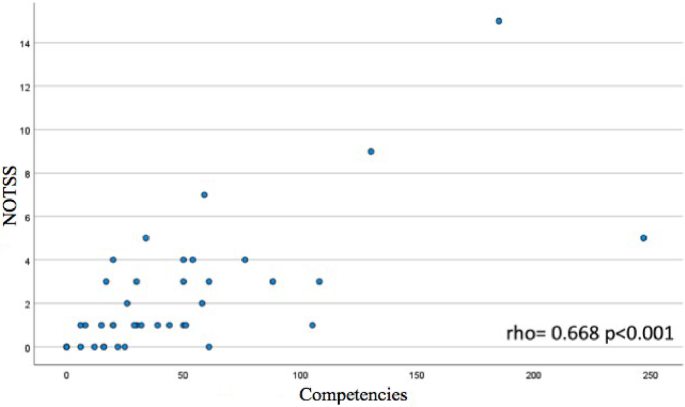
Correlation between total competencies and NOTSS identified in surgical rotations of the degree in medicine from Spanish Universities
Medicine degrees offered by public Universities exhibited an average of 2.6 ± 3 surgical NTS competencies, whereas Medicine degrees offered by private Universities had an average of 0.8 ± 1, with the differences between these types of institutions being statistically significant ( p = 0.002).
Regarding the number of students, in terms of university size based on the number of available spots for enrolling in the Medicine Degree program at the institution, no significant differences were found ( p = 0.082). However, a slight trend was observed that Universities with ≥ 200 spots had a higher number of NOTSS in their curricula compared to universities with < 200 spots (3.2 ± 4 vs. 1.9 ± 2).
Regarding intraobserver agreement, the kappa index was 0.9 (95% CI 0.8-1.0).
The subject of “surgical rotation” within the Medicine Degree pertains to a practical training phase where medical students have the opportunity to rotate through different surgical specialties within a real clinical setting. The objective of this subject is to provide students with direct experience in the field of surgery, allowing them to acquire clinical skills and specific knowledge related to various surgical areas.
The outcomes of our study reveal the limited presence of surgical NTS within these subjects in Spanish Universities, figures that markedly differ from the total competencies that are evaluated to satisfactorily complete practical rotations in surgical specialties before graduation. Lee A et al. have affirmed this fact and underscored the necessity for NTS training during undergraduate studies within Medical Schools in Canada. Spanish Institutions exhibit a higher prevalence of NTS in their surgical rotations and differ in the order of the most prevalent NOTSS categories and elements identified compared to Canadian Institutions [ 20 ]. Since comprehensive figures on the prevalence of surgical NTS are not yet available, the trends in other countries remain unclear. What appears evident is that Medical students in both Spain and Canada are not receiving adequate training in surgical NTS, despite the evidence linking NTS to patient safety [ 21 , 22 , 23 ].
In our study, “Leadership” emerged as one of the least prevalent surgical NTS, with certain elements like “Coping with Pressure” not being identified in any institution. We believe that implementing specific leadership programmes for Medical students from the undergraduate level onwards could enhance the attitude of future professionals in critical situations.
The results of our study depict a greater prevalence of the NTS category “Communication & Teamwork” in surgical specialty rotations compared to other studies, despite communication failures being one of the foremost contributors to surgical errors today [ 7 , 10 , 24 ]. One possible explanation could be the challenge of imparting this skill to medical students.
Factors such as the type of university (public vs. private) have been associated with a higher number of NOTSS in the curricula of Spanish Medical Schools. This data has not been explored previously, and the rationale behind this observation is not straightforward to comprehend. While the observed differences in favour of public Institutions are statistically significant, it should be noted that the vast majority of Centers in Spain are public, and private Universities have a lesser tradition, which could explain these disparities; however, further insights from additional studies are warranted.
Surgical NTS, like any other skill, must be learned and can be honed through training [ 25 , 26 , 27 ]. Hence, an innovative teaching model is needed to enhance knowledge, interest, and bridge the “Learning Gap” of medical students concerning these matters. In this context, artificial intelligence or the metaverse could be novel and appealing educational tools for the youth due to their cutting-edge technology. Other strategies like case simulation, didactic courses, the GemaSim simulator, mentoring, or role-playing games have been extensively described in scientific literature as effective for acquiring NTS in risk-free environments [ 28 , 29 , 30 , 31 , 32 ].
One of the strengths of this study lies in the fact that the participating researchers possessed prior training in NTS and patient safety before designing the study. Additionally, the registration method assessed the technique and intraobserver variability in recording variables to ensure data reliability. Another strength of this research is that the team consisted of representation from medical students, senior surgeons, and teaching-research staff from the University, thus obtaining perspectives from all stakeholders involved in the medical training process.
Several methodological limitations in our study should be acknowledged. Firstly, the identification of competencies was carried out by a single observer; while we believe that observer training by experts and team resolution of doubts and conflicts have mitigated the potential impact of this limitation. Secondly, the NOTSS [ 15 ] system is not validated for application to medical students. However, we consider it a useful tool for the study’s objective. The third limitation stems from evaluating the competencies outlined in the teaching plan, but it doesn’t imply that teaching encompassing these behaviors and attitudes has not been imparted within theoretical or practical teachings of surgical subjects.
The most significant challenges in the future involve assessing the impact of implementing surgical NTS on patient safety-related outcomes and complications, and finally, securing the inclusion of surgical NTS training, refinement, and periodic evaluation as educational priorities by competent authorities and responsible bodies.
Our study examined 1,846 competencies in surgical rotation subjects within the Medicine Degree across 40 Spanish Universities, identifying 99 competencies falling within surgical NTS, which constitutes 5% of the total. The most frequently identified surgical NTS include “Decision Making,” “Communication & Teamwork,” and “Leadership.” Public Universities and those with a higher number of competencies exhibit a higher rate of surgical NTS competencies, and no correlation has been found between surgical NTS competencies and the quality indices of University Centers.
Data availability
The datasets used and/or analysed during the current study are available from the corresponding author on reasonable request.
Abbreviations
- Non-Technical Skills
- Crew Resource Management
- Anaesthetists Non-Technical Skills
- Non-Technical Skills for Surgeons
- Scrub Practitioners’ List of Intraoperative Non-Technical Skills
- Oxford Non-Technical Skills
- Statistical Package for Social Sciences
McMullan M. Patients using the internet to obtain health information: how this affects the patient–health professional relationship. Patient Educ Couns. 2006;63:24–8. https://doi.org/10.1016/j.pec.2005.10.006 .
Article Google Scholar
Mayo WJ. Specialization in surgery. Arch Surg. 1925;10:264. https://doi.org/10.1001/archsurg.1925.01120100276011 .
Helmreich RL, Merritt AC, Wilhelm JA. The evolution of Crew Resource Management Training in Commercial Aviation. Int J Aviat Psychol. 1999;9(1):19–32. https://doi.org/10.1207/s15327108ijap0901_2 .
Reason JT, Brookfield. Vt., USA: Ashgate; 1997. 252. https://doi.org/10.4324/9781315543543 .
de Vries EN, Ramrattan MA, Smorenburg SM, Gouma DJ, Boermeester MA. The incidence and nature of in-hospital adverse events: a systematic review. Qual Saf Health Care. 2008;17:216–23. https://doi.org/10.1136/qshc.2007.023622 .
Gillespie BM, Harbeck E, Kang E, Steel C, Fairweather N, Panuwatwanich K, et al. Effects of a brief Team Training Program on Surgical teams’ nontechnical skills: an interrupted time-series study. J Patient Saf. 2021;17:e448–54. https://doi.org/10.1097/PTS.0000000000000361 .
Gawande AA, Zinner MJ, Studdert DM, Brennan TA. Analysis of errors reported by surgeons at three teaching hospitals. Surgery. 2003;133:614–21. https://doi.org/10.1067/msy.2003.169 .
Flin R, O ́Connor P, Crichton M. Safety at the Sharp end: a guide to non-technical skills. Burlington: Ashgate Publishing Company; 2008.
Google Scholar
Yule S, Flin R, Paterson-Brown S, Maran N, Rowley D. Development of a rating system for surgeons’ non-technical skills. Med Educ. 2006;40:1098–104. https://doi.org/10.1111/j.1365-2929.2006.02610 .
Vioque SM, Kim PK, McMaster J, Gallagher J, Allen SR, Holena DN, et al. Classifying errors in preventable and potentially preventable trauma deaths: a 9-year review using the Joint Commission’s standardized methodology. Am J Surg. 2014;208:187–94. https://doi.org/10.1016/j.amjsurg.2014.02.006 .
Gaba DM, Fish KJ, Howard SK. Crisis management in anesthesiology. New York: Churchill Livingstone; 1994. p. 294.
Risser DT, Rice MM, Salisbury ML, Simon R, Jay GD, Berns SD. The potential for Improved Teamwork to reduce medical errors in the Emergency Department. Ann Emerg Med. 1999;34:373–83. https://doi.org/10.1016/S0196-0644(99)70134-4 .
King HB, Battles J, Baker DP, Alonso A, Salas E, Webster J, et al. TeamSTEPPSTM: team strategies and tools to Enhance Performance and Patient Safety. In: Henriksen K, Battles JB, Keyes MA, Grady ML, editors. Advances in Patient Safety: new directions and alternative approaches. Performance and Tools. Volume 3. Rockville (MD): Agency for Healthcare Research and Quality (US); 2008.
Flin R, Glavin R, Maran M, Patey R. Framework for Observing and Rating anaesthetics ́Non-Technical skills-anaesthetists ́Non-Technical skills (ANTS) System Handbook. 1st ed. Aberdeen: UniPrint, University of Aberdeen; 2012.
Yule S, Flin R, Paterson-Brown S, Maran N, Rowley D. The non-technical skills for surgeons (NOTSS) System Handbook. 1st ed. Aberdeen: UniPrint, University of Aberdeen; 2012.
Flin R, O ́Connor P, Crichton M. Scrub practitioners ́List of Intraoperativa non- technical skills (SPLINTS) System Handbook. 1st ed. Aberdeen: UniPrint, University of Aberdeen; 2014.
McMullan RD, Urwin R, Sunderland N, Westbrook J. Observational tools that quantify nontechnical skills in the operating room: a systematic review. J Surg Res. 2020;247:306–22.
Ranking CYD. https://www.rankingcyd.org; 2023 [accessed 26 March 2023].
von Elm E, Altman DG, Egger M, Pocock SJ, Gøtzsche PC, Vandenbroucke JP. Strengthening the reporting of observational studies in epidemiology (STROBE) statement: guidelines for reporting observational studies. BMJ. 2007;335:806–8. https://doi.org/10.1136/bmj.39335.541782.AD .
Lee A, Finstad A, Gawad N, Boet S, Raiche I, Balaa F. Nontechnical skills (NTS) in the Undergraduate Surgical and Anesthesiology Curricula: are we adequately preparing medical students? J Surg Educ. 2021;78:502–11. https://doi.org/10.1016/j.jsurg.2020.08.001 .
Mazzocco K, Petitti DB, Fong KT, Bonacum D, Brookey J, Graham S, et al. Surgical team behaviors and patient outcomes. Am J Surg. 2009;197:678–85. https://doi.org/10.1016/j.amjsurg.2008.03.002 .
Armour Forse R, Bramble JD, McQuillan R. Team training can improve operating room performance. Surgery. 2011;150:771–8. https://doi.org/10.1016/j.surg.2011.07.076 .
Neily J, Mills PD, Young-Xu Y, Carney BT, West P, Berger DH, et al. Association between implementation of a medical team training program and surgical mortality. JAMA. 2010;304:1693–700. https://doi.org/10.1001/jama.2010.1506 .
Lingard L, Espin S, Whyte S, Regehr G, Baker GR, Reznick R, et al. Communication failures in the operating room: an observational classification of recurrent types and effects. Qual Saf Health Care. 2004;13:330–4. https://doi.org/10.1136/qshc.2003.008425 .
Chang Y, Lai C. Nontechnical skills for the surgery clerkship in the operating room based on adult learning principles in Taiwan. Kaohsiung J Med Sci. 2022;38:907–13. https://doi.org/10.1002/kjm2.12565 .
Savoldelli GL, Naik VN, Park J, Joo HS, Chow R, Hamstra SJ. Value of debriefing during simulated Crisis Management. Anesthesiology. 2006;106:279–85. https://doi.org/10.1097/00000542-200608000-00010 .
McCulloch P, Mishra A, Handa A, Dale T, Hirst G, Catchpole K. The effects of aviation-style non-technical skills training on technical performance and outcome in the operating theatre. Qual Saf Health Care. 2009;18:109–15. https://doi.org/10.1136/qshc.2009.032177 .
Phillips EC, Smith SE, Hamilton AL, Kerins J, Clarke B, Tallentire VR. Assessing medical students’ nontechnical skills using Immersive Simulation: what are the essential components? Simul Healthc J Soc Simul Healthc. 2021;16:98–104. https://doi.org/10.1097/SIH.0000000000000463 .
Lateef F. Simulation-based learning: just like the real thing. J Emerg Trauma Shock. 2010;3:348. https://doi.org/10.4103/0974-2700.70743 .
Kaiser D, Eberhart J, Butler C et al. Real Time Cockpit Resource Management (CRM) training, 2012. [consultado el 26 de marzo de 2023].
Nicolaides M, Cardillo L, Theodoulou I, Hanrahan J, Tsoulfas G, Athanasiou T, et al. Developing a novel framework for non-technical skills learning strategies for undergraduates: a systematic review. Ann Med Surg. 2018;36:29–40. https://doi.org/10.1016/j.amsu.2018.10.005 .
Yule S, Parker SH, Wilkinson J, McKinley A, MacDonald J, Neill A, et al. Coaching non-technical skills improves Surgical residents’ performance in a simulated operating room. J Surg Educ. 2015;72:1124–30. https://doi.org/10.1016/j.jsurg.2015.06.012 .
Download references
Acknowledgements
Not applicable.
No sources of funding have been used in these manuscript.
Author information
Authors and affiliations.
School of Medicine, University of Murcia, Murcia, Spain
Oves-Suarez B
Department of General and Digestive Surgery, University Hospital Morales Meseguer, Murcia, Spain
García-Marín JA & Aguayo-Albasini JL
Chief of Department of General and Digestive Surgery, University Hospital Morales Meseguer, Murcia, Spain
Soria-Aledo V
You can also search for this author in PubMed Google Scholar
Contributions
BOS designed the work, analyzed and interpreted the data and drafted the manuscript. JAGM and VSA designed the work, interpreted the data and revised it JAAA designed the work and revised the manuscript All authors have approved the manuscript.
Corresponding author
Correspondence to García-Marín JA .
Ethics declarations
Ethics approval and consent to participate, consent for publication, competing interests.
The authors declare that they have no competing interests.
Additional information
Publisher’s note.
Springer Nature remains neutral with regard to jurisdictional claims in published maps and institutional affiliations.
Rights and permissions
Open Access This article is licensed under a Creative Commons Attribution 4.0 International License, which permits use, sharing, adaptation, distribution and reproduction in any medium or format, as long as you give appropriate credit to the original author(s) and the source, provide a link to the Creative Commons licence, and indicate if changes were made. The images or other third party material in this article are included in the article’s Creative Commons licence, unless indicated otherwise in a credit line to the material. If material is not included in the article’s Creative Commons licence and your intended use is not permitted by statutory regulation or exceeds the permitted use, you will need to obtain permission directly from the copyright holder. To view a copy of this licence, visit http://creativecommons.org/licenses/by/4.0/ . The Creative Commons Public Domain Dedication waiver ( http://creativecommons.org/publicdomain/zero/1.0/ ) applies to the data made available in this article, unless otherwise stated in a credit line to the data.
Reprints and permissions
About this article
Cite this article.
B, OS., JA, GM., JL, AA. et al. Unveilling the hidden skillset: exploring non-technical skills in surgical education across spanish medical universities. BMC Med Educ 24 , 376 (2024). https://doi.org/10.1186/s12909-024-05362-w
Download citation
Received : 26 August 2023
Accepted : 27 March 2024
Published : 05 April 2024
DOI : https://doi.org/10.1186/s12909-024-05362-w
Share this article
Anyone you share the following link with will be able to read this content:
Sorry, a shareable link is not currently available for this article.
Provided by the Springer Nature SharedIt content-sharing initiative
- Medical education
- Patient safety
- Non-technical skills
- Human factors
BMC Medical Education
ISSN: 1472-6920
- Submission enquiries: [email protected]
- General enquiries: [email protected]

IMAGES
VIDEO
COMMENTS
Gale Litfinder, Gale E-books, or Gale Middle School are just a few of the many resources within Gale for middle school students. Teaching Research Skills To High Schoolers. The goal is that research becomes intuitive as students enter high school. With so much exposure and practice over the years, the hope is that they will feel comfortable ...
Learn how to teach research skills to primary students, middle school students, or high school students. 50 activities that could be done in just a few minutes a day. Lots of Google search tips and research tips for kids and teachers.
Teaching students to look for bias, political orientation, and opinions within all sources is one of the most valuable research skills for high school students. 5. Teaching your students to use Wikipedia. Now, I know that Wikipedia can be the bane of your teacherly existence when you are reading essays.
How to Teach Research Skills to High School Students. Teaching a comprehensive research experiences can be daunting and overwhelming! Many dread teaching a research project or paper but, weirdly, one of my favorite things to teach. I have taught many projects over my years but the inquiry-based project has always been my favorite!
Empowering students to develop research skills. February 8, 2021. This post is republished from Into Practice, a biweekly communication of Harvard's Office of the Vice Provost for Advances in Learning. Terence D. Capellini, Richard B Wolf Associate Professor of Human Evolutionary Biology, empowers students to grow as researchers in his Building the Human Body course through a comprehensive ...
Almost nine in ten teachers who participated in the NWP Summer Institute (88%) reported assigning a research paper in the 2011-2012 academic year. Most teachers rate their students "good" or "fair" on a variety of specific research skills. Despite the overall perception that the internet and digital technologies have a "mostly ...
5 simple steps to teaching Google search tips and internet research skills for students. This updated 2020 post and free eBook shows how to research effectively online for kids in primary school, middle school and high school. These tips are summarized in a free online research skills poster for your classroom.
Here are 4 must-have resources for teaching high school students how to research: Digital encyclopedias like Britannica School or Credo Reference are still important, and vetted, sources of basic information. Each provides students with a credible resource and gives them helpful notation and citation tools. But don't settle for just one.
Such activities convey the elements that are suggested to make a post-secondary led high school education programs ... teams based on laboratory skills, teaching experience, and research expertise
Avoid relational words like impact, effect, and cause. Stick to two to four keywords for best results. Example. Three keywords: social media, loneliness, teens. 3. Specify and professionalize. Think of more professional and academic synonyms for your keywords. Talk to your friends, teachers, parents and librarians to brainstorm.
2. Surprising Facts - A fun way for students to dive into research is to give them a topic and simply task them with finding facts that are surprising. This activity works great with partners. Topics could tie in with a current class novel or story (such as "elephant" from The Giver) or even an author.
Removing Barriers to New Information. For starters, research is crucial for education. It helps us learn and create new knowledge. Teachers learning how to translate research into practice can help contribute toward continuous improvement in schools. However, not all research is beneficial or easily applicable.
Teaching research skills to high school students is a crucial part of their education. It helps them develop critical thinking and analytical skills they will need in college and beyond. I have a ...
Teaching Students Better Online Research Skills. By Leslie Harris O'Hanlon — May 20, 2013 9 min read. Sara Shaw, an elementary school teacher in Avon, Mass., realized she needed to teach online ...
Most (though not all) students who take on the challenge of AER are already high-performing and highly-motivated students; thus, they've already learned a lot of the research and analysis skills ...
Part of teaching research skills to high school students is providing clear expectations. As writing in the ELA classroom becomes more digital, I simply give writers tools on our online learning platform. That way, I can remind them to check a certain section or page as we collaborate on their writing.
Work individually. Work collaboratively. The following tips and methodologies build off the initial preparation: Students formulate a logical thesis that expresses a perspective on their research subject. Students practice their research skills. This includes evaluating their sources, summarizing and paraphrasing significant information, and ...
At my last school I, along with another teacher, taught a compulsory half-year ICT course for all 400 Year 9 new entrants (average age 13). The course was a carryover of the teaching of basic ...
Abstract — Teaching Practical Research in the Senior High. School was a challenge but at the same time a room for. exploration. This study investigated the key areas in the. interconnected ...
So how do we teach our students to steer through the online ocean of data to be both effective researchers and responsible digital citizens? Here are 4 must-have resources for teaching high school students how to research: Digital encyclopedias like Britannica School or Credo Reference are still important, and vetted, sources of basic ...
Research is a complex skill requiring diverse sub-skills. For example, some of those skills are very procedural (e.g., How to use a database), while others involve critical thinking (eg. Evaluating search results). Still others require strategic thinking (e.g., knowing what tools and procedures are appropriate/efficient for different research ...
Teaching High School Students Active Reading Skills. Strategies used before, during, and after reading can help high school students locate and retain important information. Although many people consider reading to be a passive activity, research supports that it's an active activity that involves complex cognitive processes.
Here is an example of a research process that you may consider using when teaching research skills in your middle school classroom: Form a question: Research should be targeted; develop a question you want to answer before progressing any further. Decide on resources: Not every resource is good for every question/problem. Identify the resources ...
Teaching academically honest research skills helps first graders learn how to collect, organize, and interpret information. Earlier in my career, I was told two facts that I thought to be false: First graders can't do research, because they aren't old enough; and if facts are needed for a nonfiction text, the students can just make them up.
These schools employ more full-time psychologists and provide more professional development training to teachers compared to traditional public schools. In particular, teacher trainings focus on ...
Come and join us for the Awarding and Closing Ceremony of the National Science and Technology Fair (NSTF) 2024! #NSTF2024 #MATATAG #BatangMakabansa...
Being disrespectful toward the teacher (21%) Some challenges are more common among high school teachers, while others are more common among those who teach elementary or middle school. Cellphones: 72% of high school teachers say students being distracted by their cellphones in the classroom is a major problem. A third of middle school teachers ...
Low-poverty, medium-poverty and high-poverty schools are based on the percentage of students eligible for free and reduced-price lunch, as reported by the National Center for Education Statistics (less than 40%, 40%-59% and 60% or more, respectively).. Secondary schools include both middle schools and high schools.. All references to party affiliation include those who lean toward that party.
Published April 5, 2024 10:38 am. High school students were on Southwestern Community College's Creston campus on Thursday, April 4, from 9 a.m.-2 p.m., competing in the 2024 Welding Skills Challenge. During their time at Southwestern, students competed individually and as teams, networked with industry professionals, and learned about career ...
Non-Technical Skills (NTS) are cognitive, social, and personal resource skills that are crucial in complex and high-risk environments. The aims of our research are to determine the prevalence and content of NTS in the surgical rotation teaching guides of the Medicine Degree programs in Spanish Universities, to identify the most prevalent types and subtypes of NTS, and to analyze factors ...